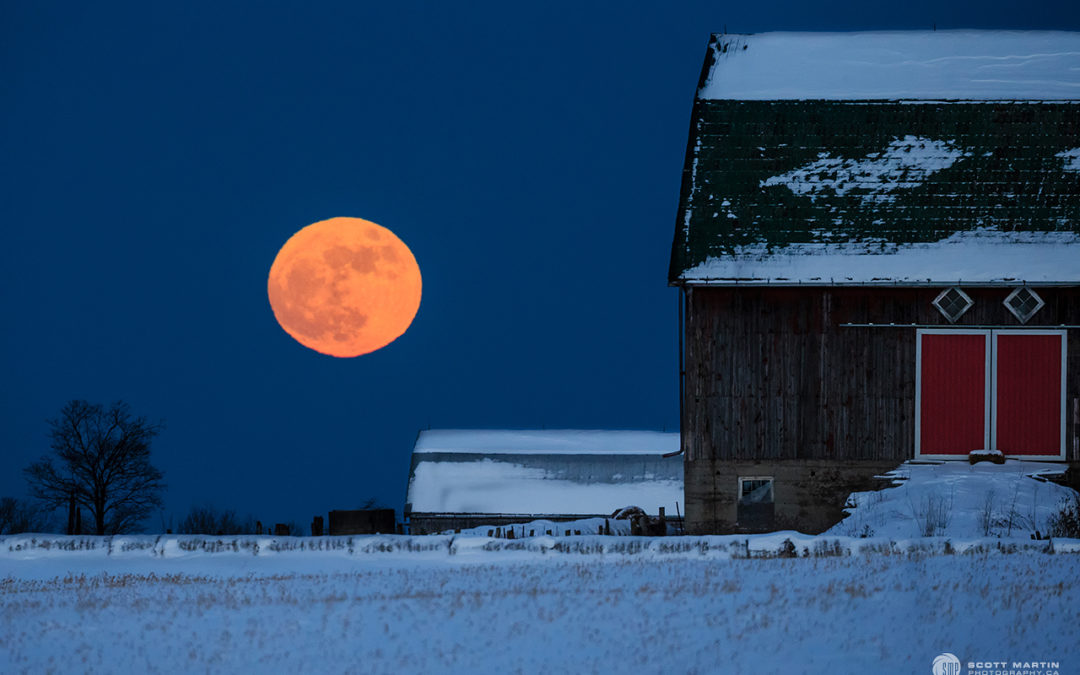
Full Moon On New Years Day, 2018
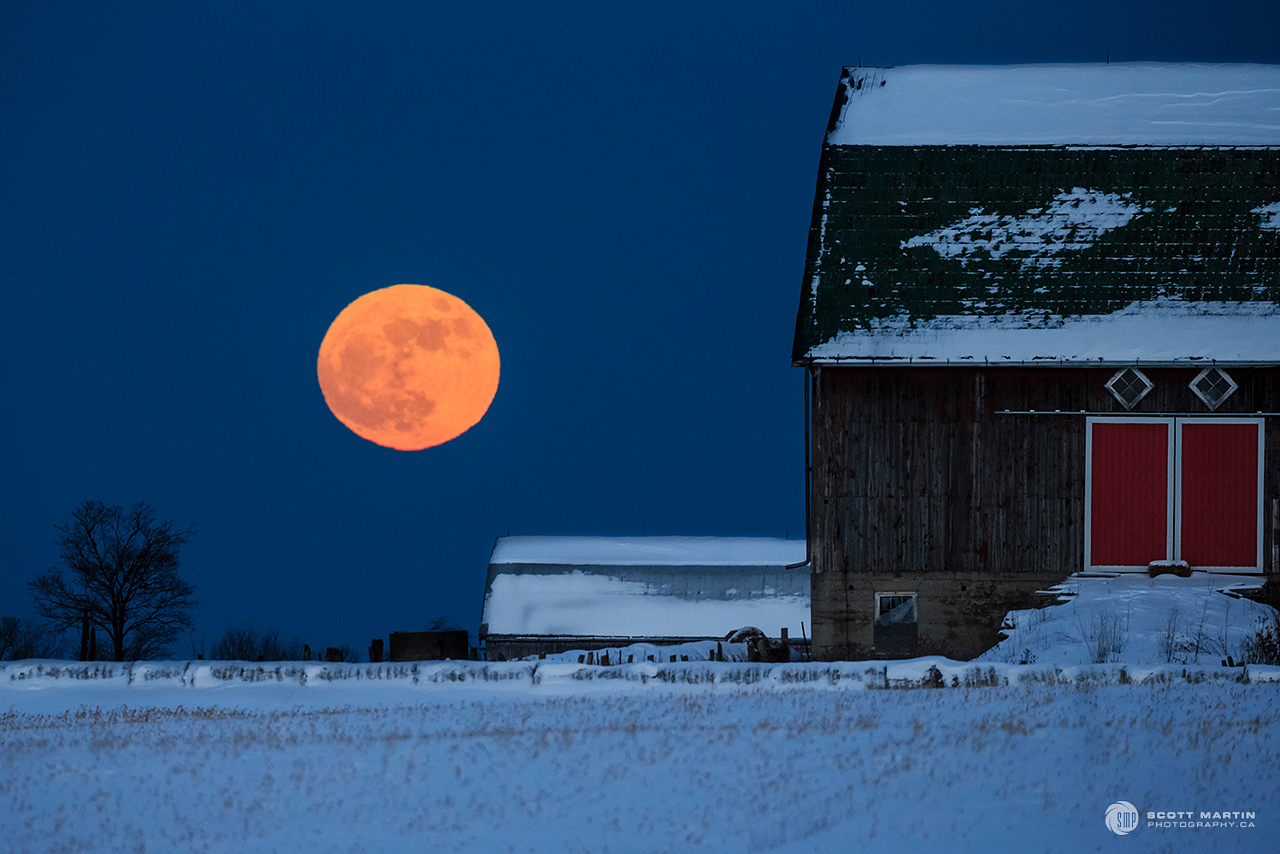
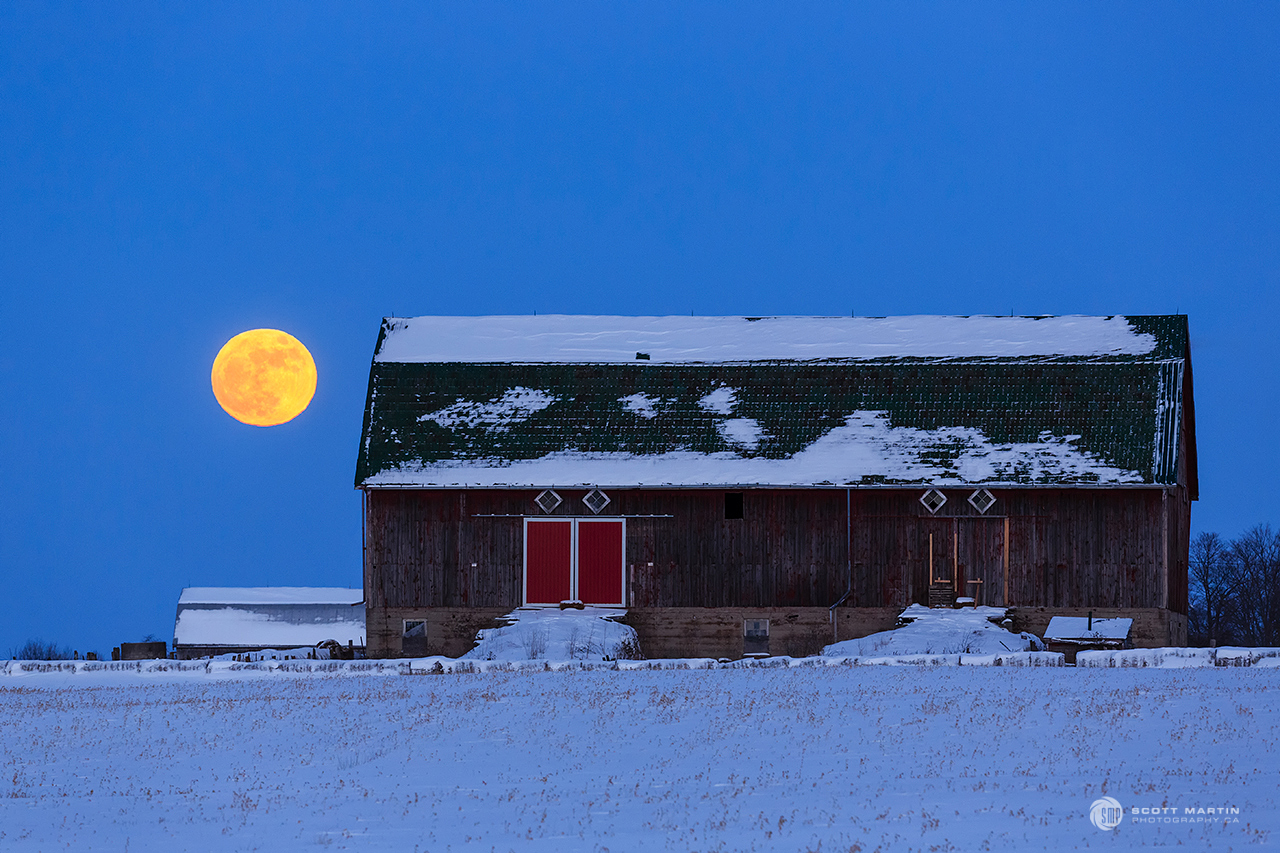
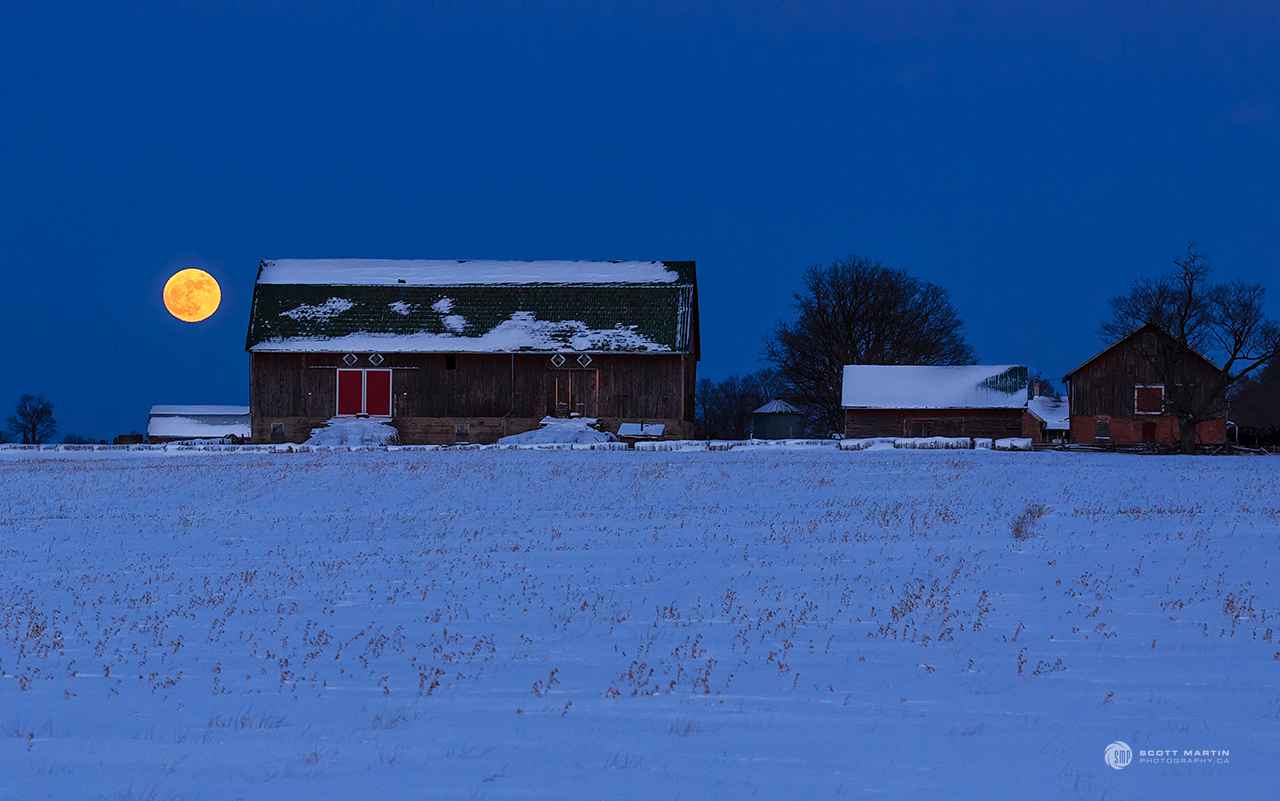
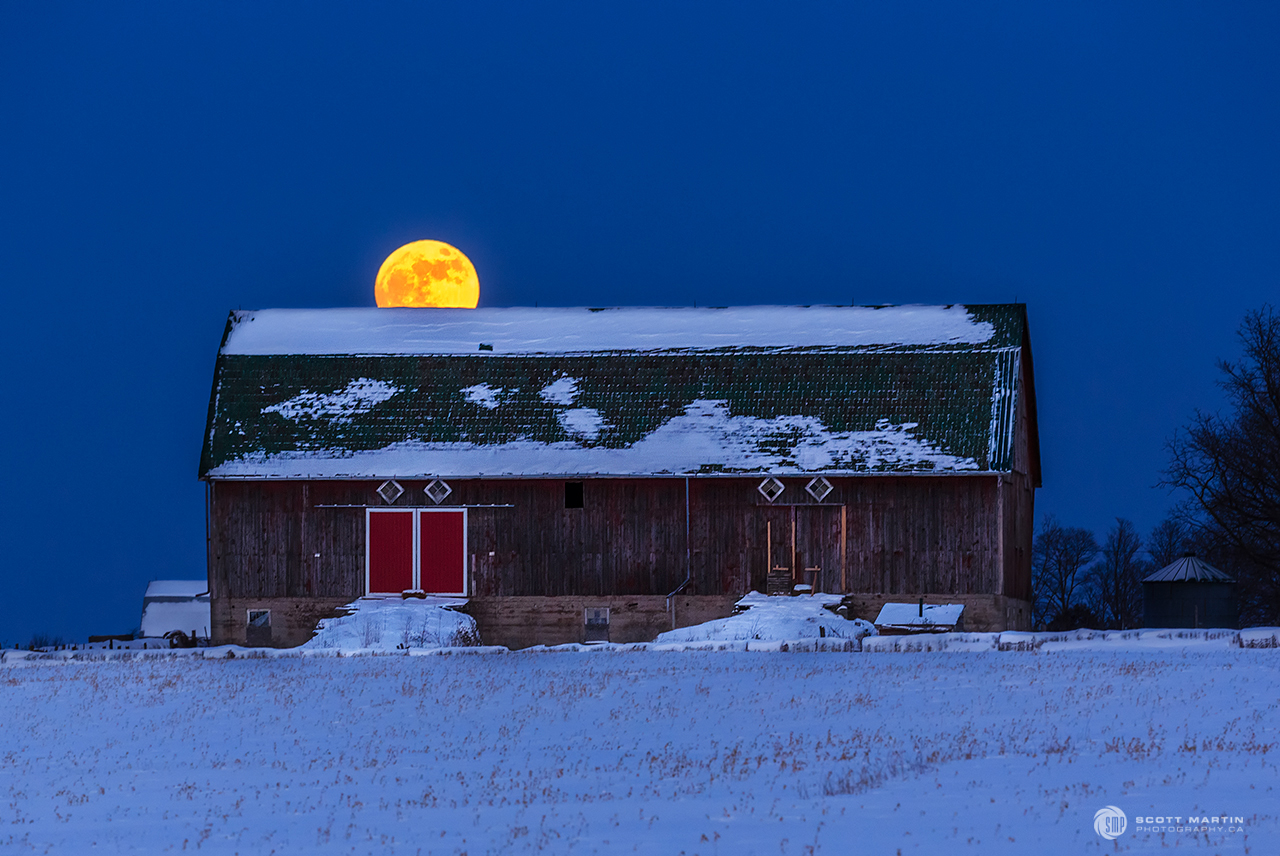
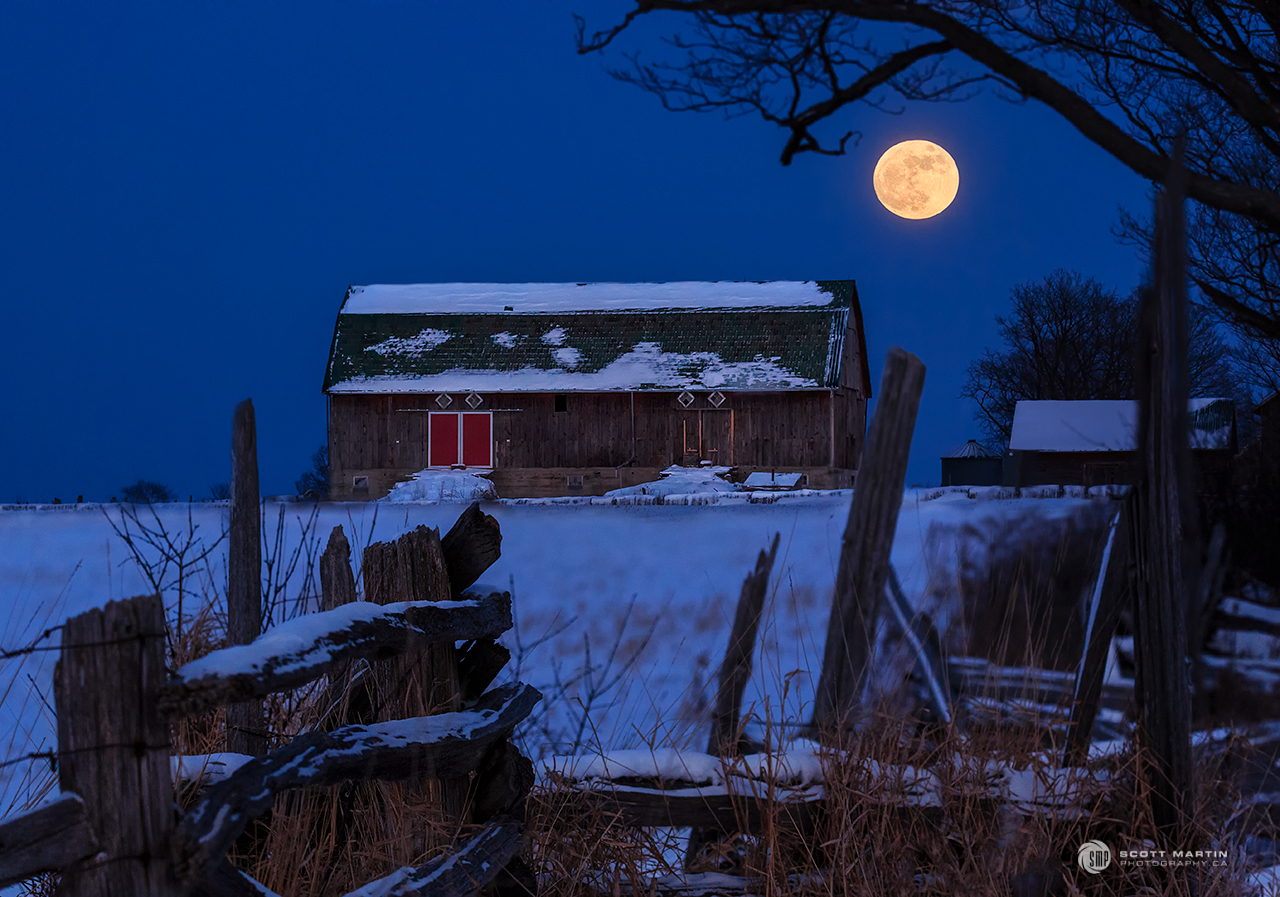






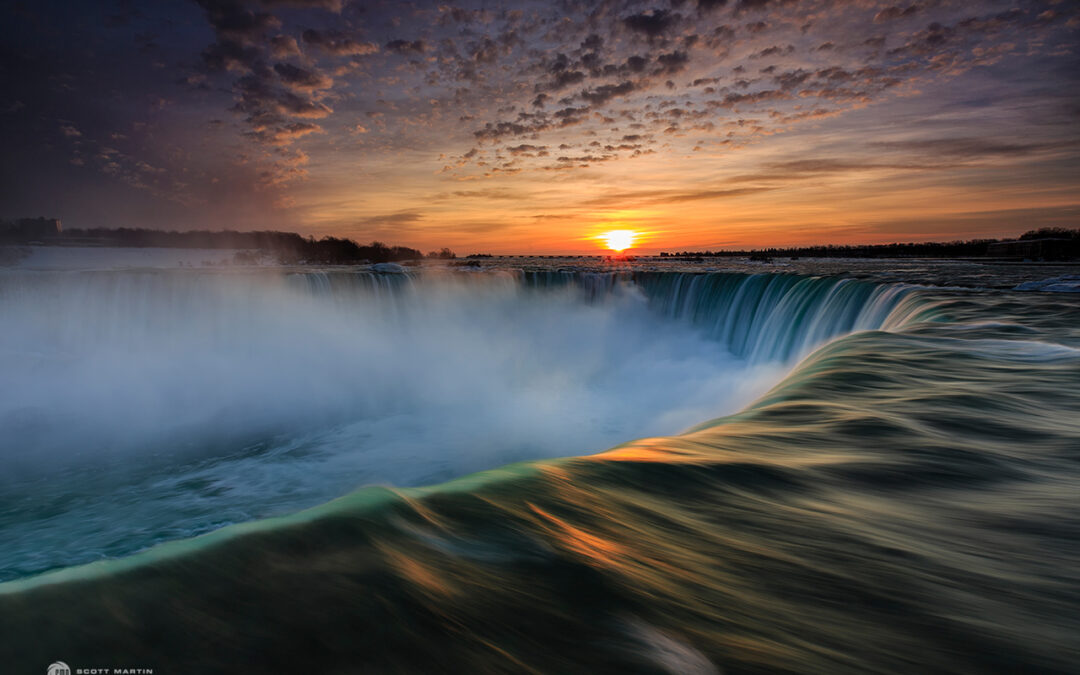
For the past number of years we have enjoyed an extended family weekend in Niagara Falls in January. It is a great time of the year to see the falls dressed in her winter splendour with snow and ice abounding and the ever-present mist laminating layer after layer of ice on everything it touches. Also during winter the sun rises over the Horseshoe Falls creating the opportunity for that ‘perfect’ Niagara Falls sunrise photograph.
So on a very cold Saturday morning Deb & I made the short walk from our hotel to the brink of the falls arriving in the dark about twenty minutes before sunrise. It’s wise to arrive early for three reasons; you will likely be first on scene and thus the prime spot to take the image is available (the early bird…), you have time to scout out and determine the best vantage point, and you have time to set up your gear and take test images to determine the correct, perspective, composition and exposure details to successfully record the image you have in mind.
With your smartphone it is possible to do much of the advance planning long before you arrive on the scene. There are many apps that help in this process and after testing many of them my two favourites are LightTrac and PhotoPills. LightTrac is a great little app that allows you to see rise and set times for the sun and moon on any date anywhere in the world. PhotoPills is a very robust app that is essential for every landscape photographer. It allows you to determine where and when the sun or moon will be positioned where you desire and how to position yourself to photograph it. PhotoPills also provides a wealth of information to help calculate complex photographic challenges including time lapse, long exposure and HDR (High Dynamic Range) photography.
Once we pinpointed our location and set up the tripod, we waited patiently for the sun to rise, very happy that there were some clouds in the sky and the wind was sufficient to be blowing the mist from the falls away from the spot where the sun was going to rise.
Sunrise, January 20, 2018
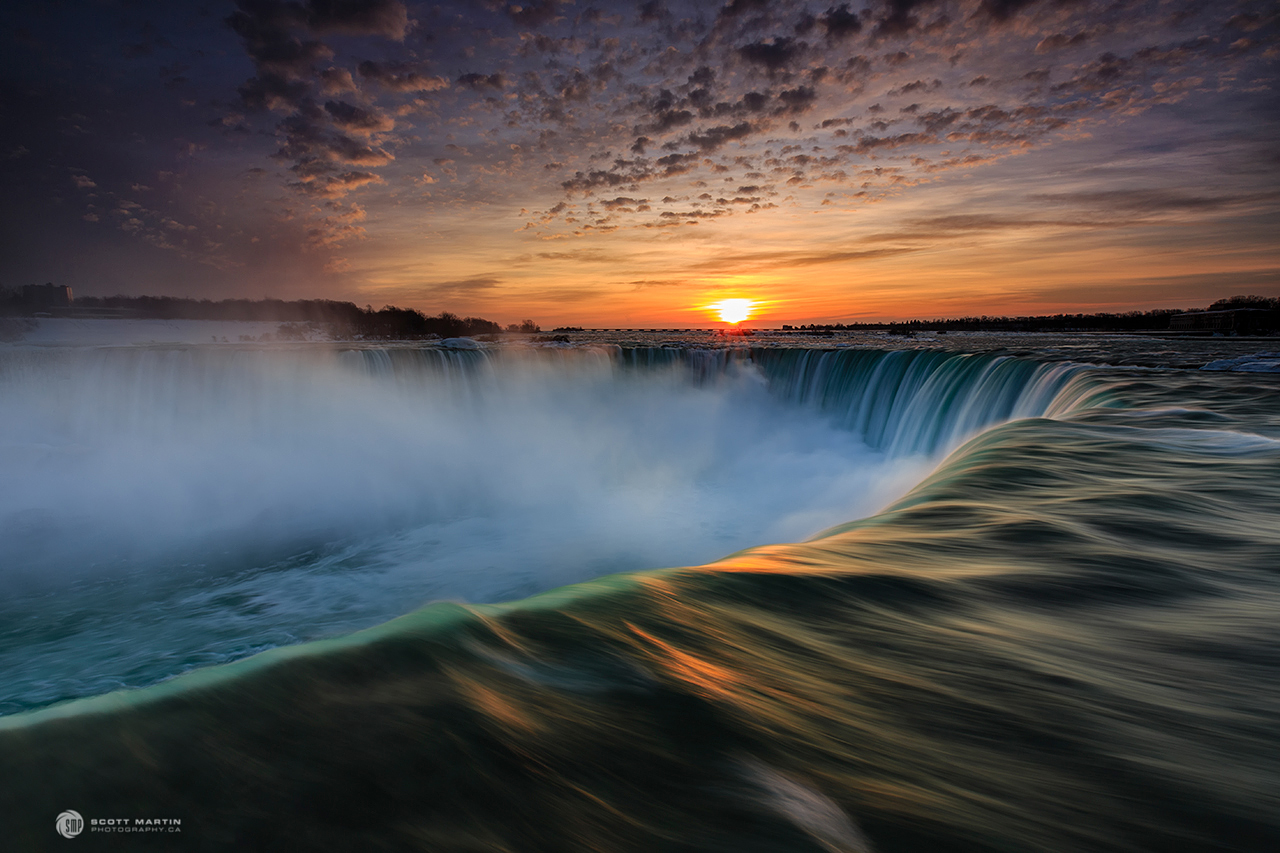
This image was taken using a Canon 5D Mk III with an EF 16-35mm f/2.8L III lens; ISO 50, f/22, 1/2 sec at 16mm focal length. I was able to take this image with a single frame by using a Singh Ray reverse three stop ND grad filter to darken the sun by three f-stops which evens the light intensity at the camera sensor. Without the filter, in order to get a well exposed image you would require at least two images, one exposed for the bright sky and the other for the darker falls and combining them later on the computer. It’s always easier and less time consuming to take one image and filters help make that possible.
After capturing a ‘few’ sunrise images we wandered around the falls enjoying a great start to new day. Making more memories of Niagara Falls on a cool winter’s morning before heading back to the hotel for breakfast. I hope you enjoy these images.
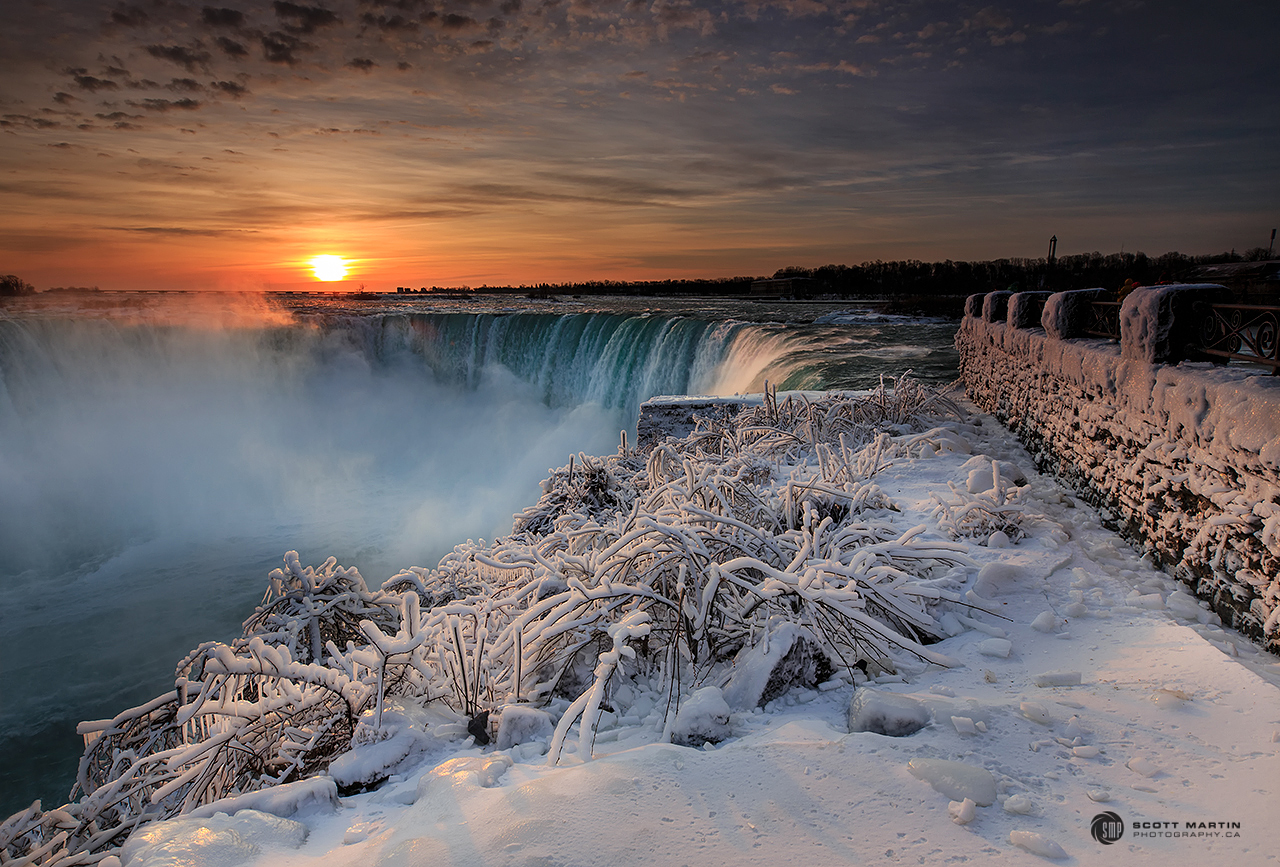
.
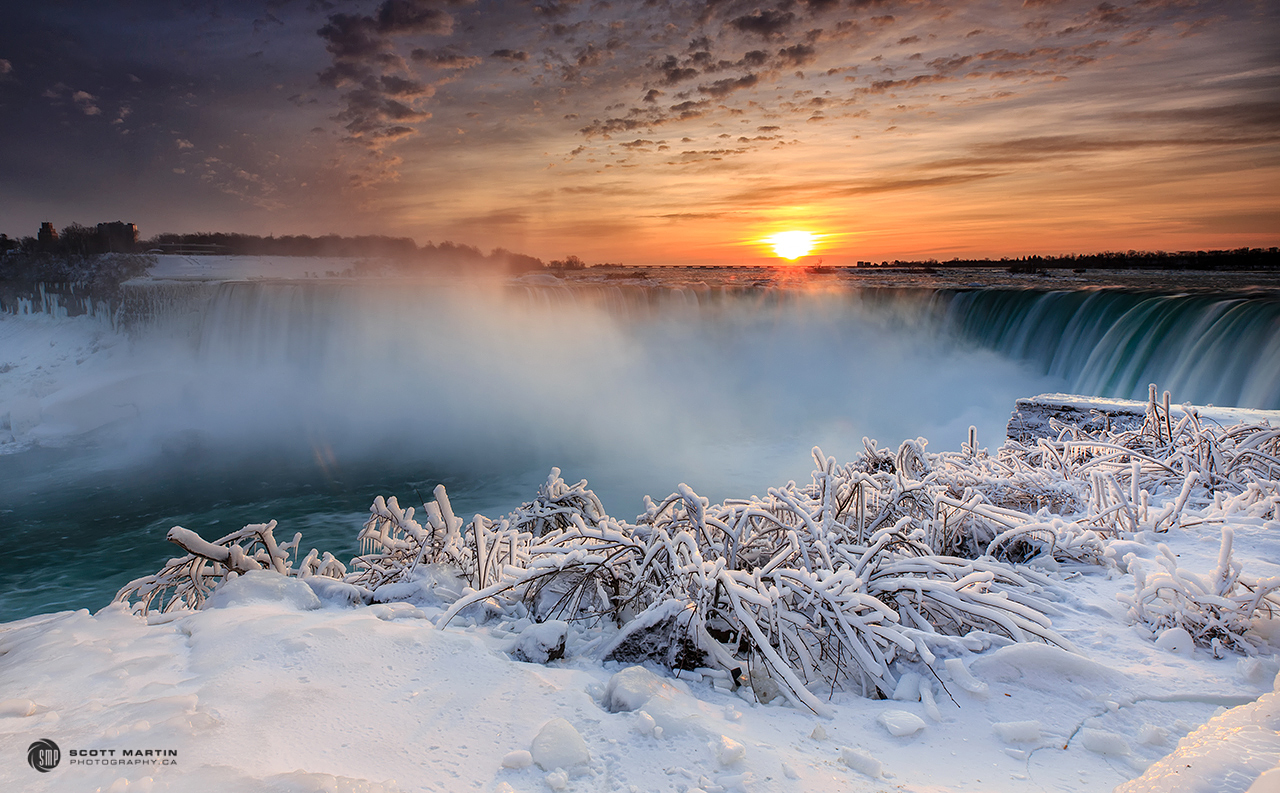
.
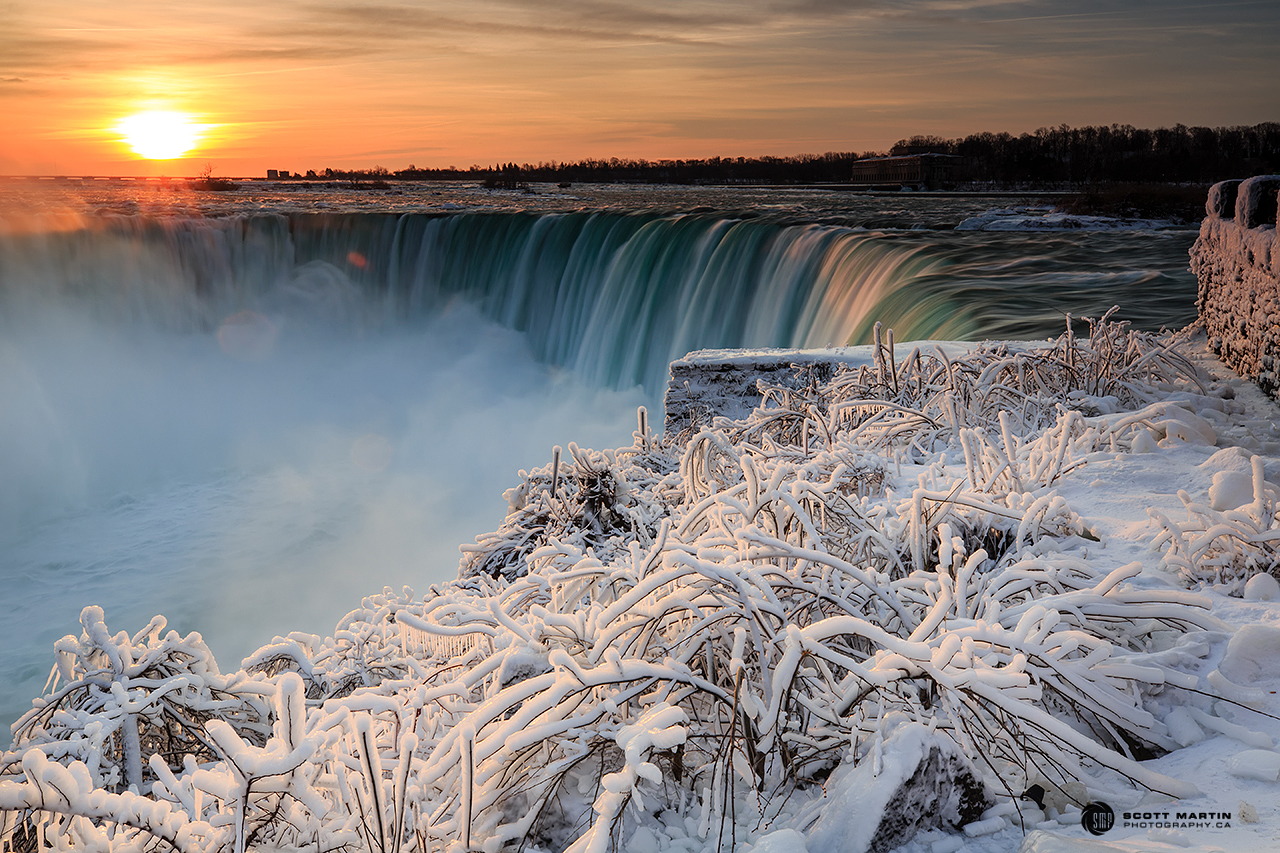
.
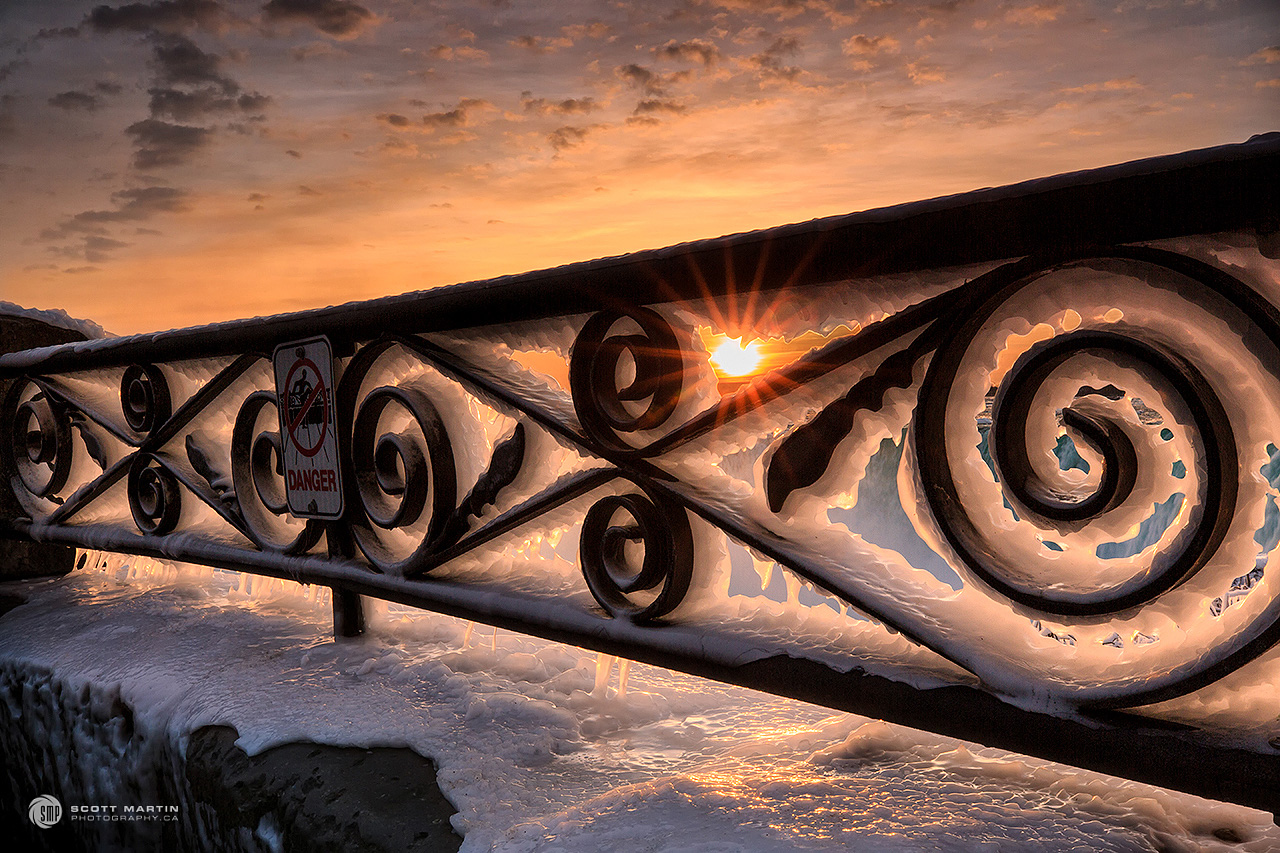
.
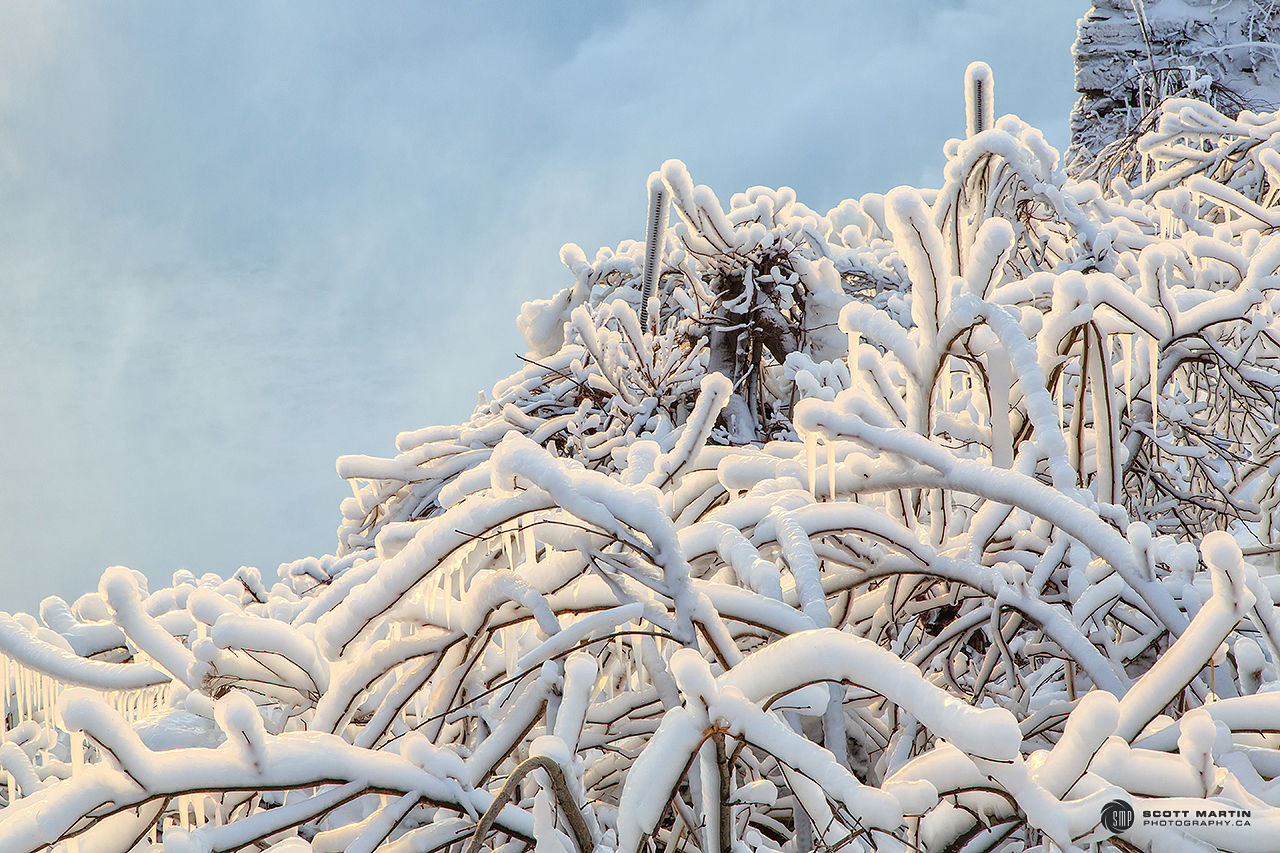
.
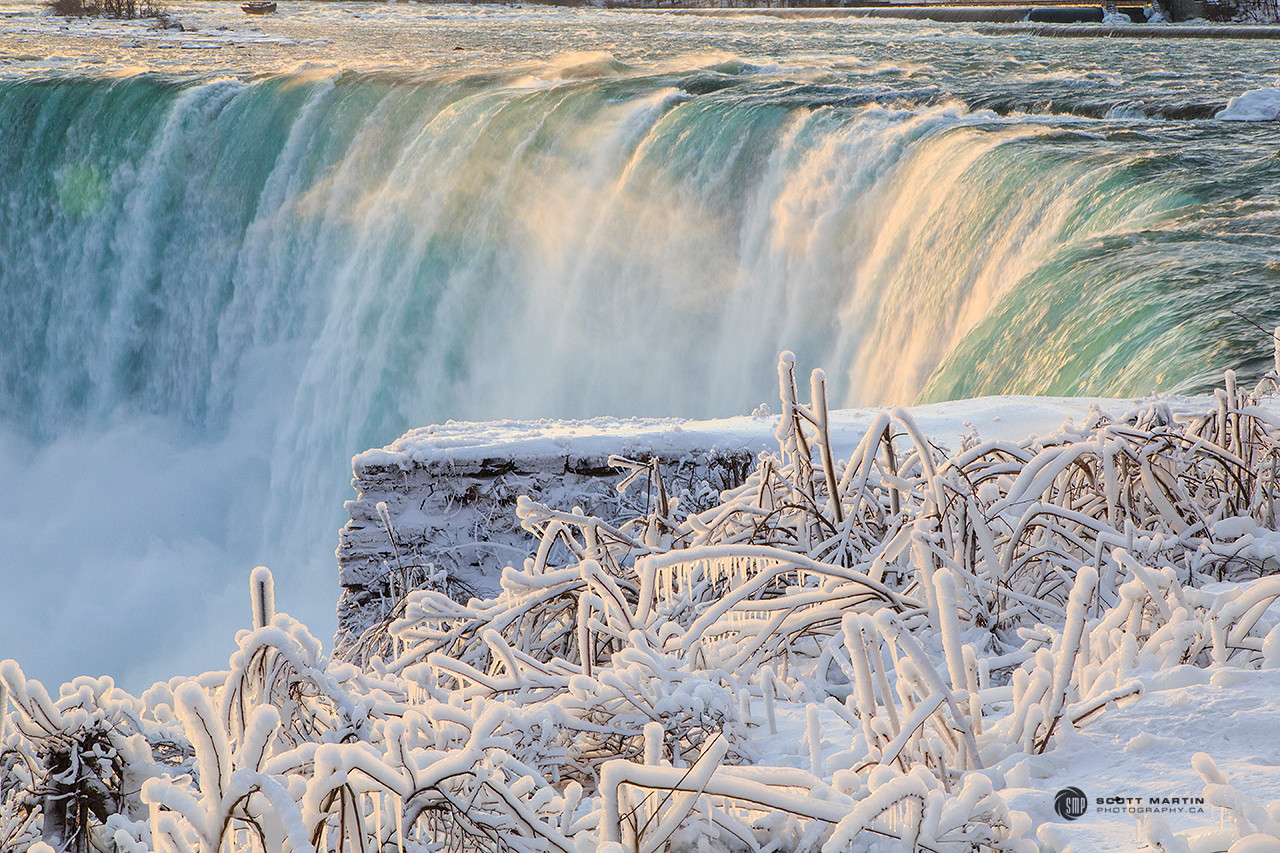
.
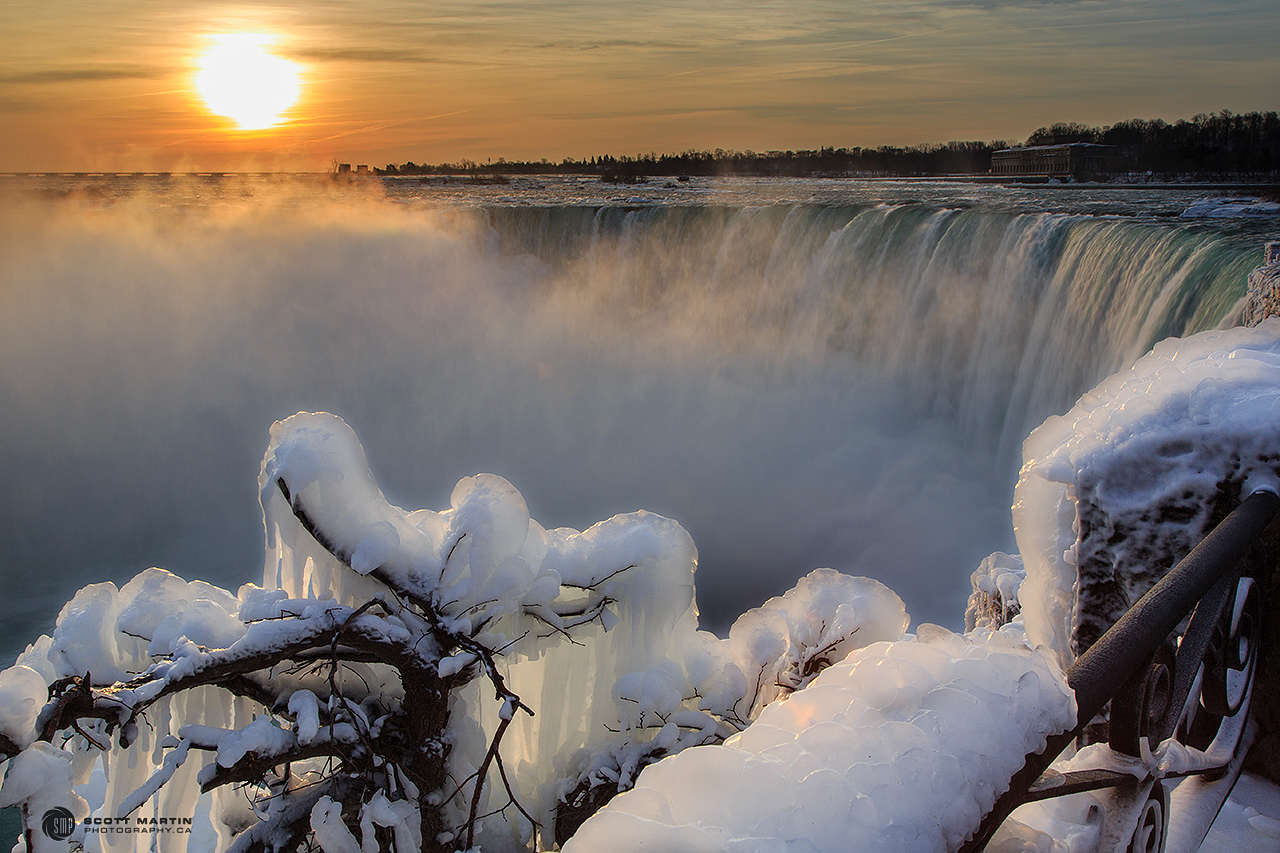
.
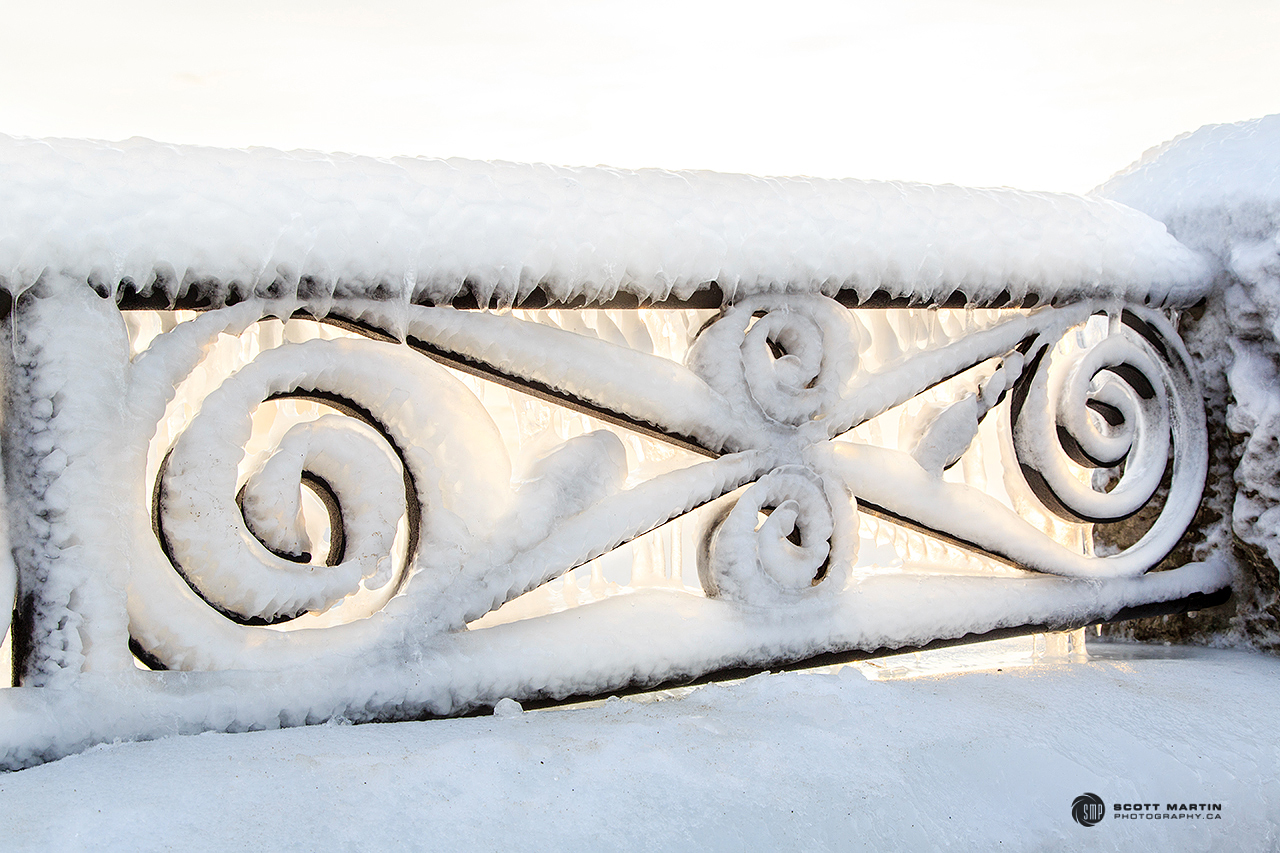
The view from our hotel room.
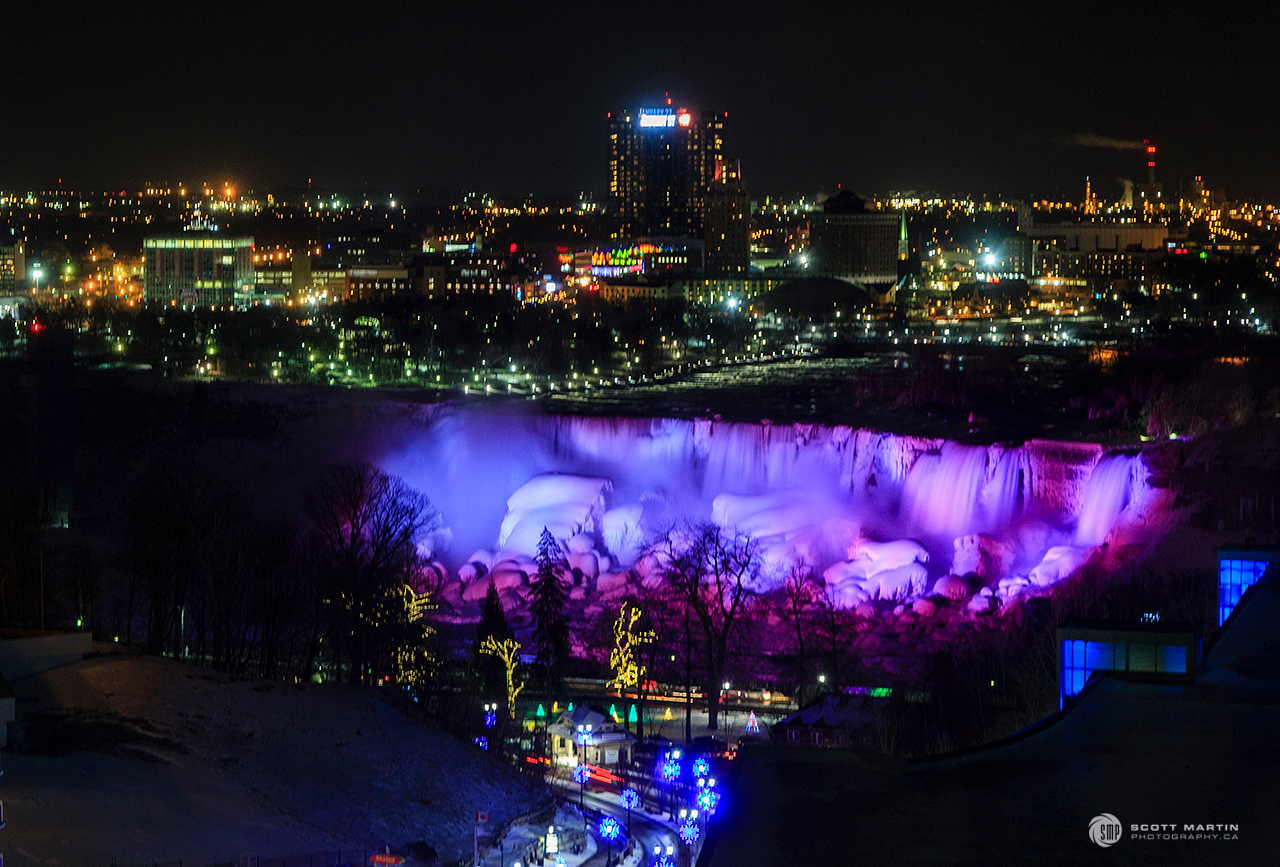
Other images taken at the falls can be seen in the Naturescapes Gallery on the website.
As always, your comments and questions are welcomed and I trust that you will grab a tripod and camera and head out early one morning soon to photograph the sunrise. You will be glad you did.
Although this is a little late, Happy New Year and all the best in 2018 to you and yours!
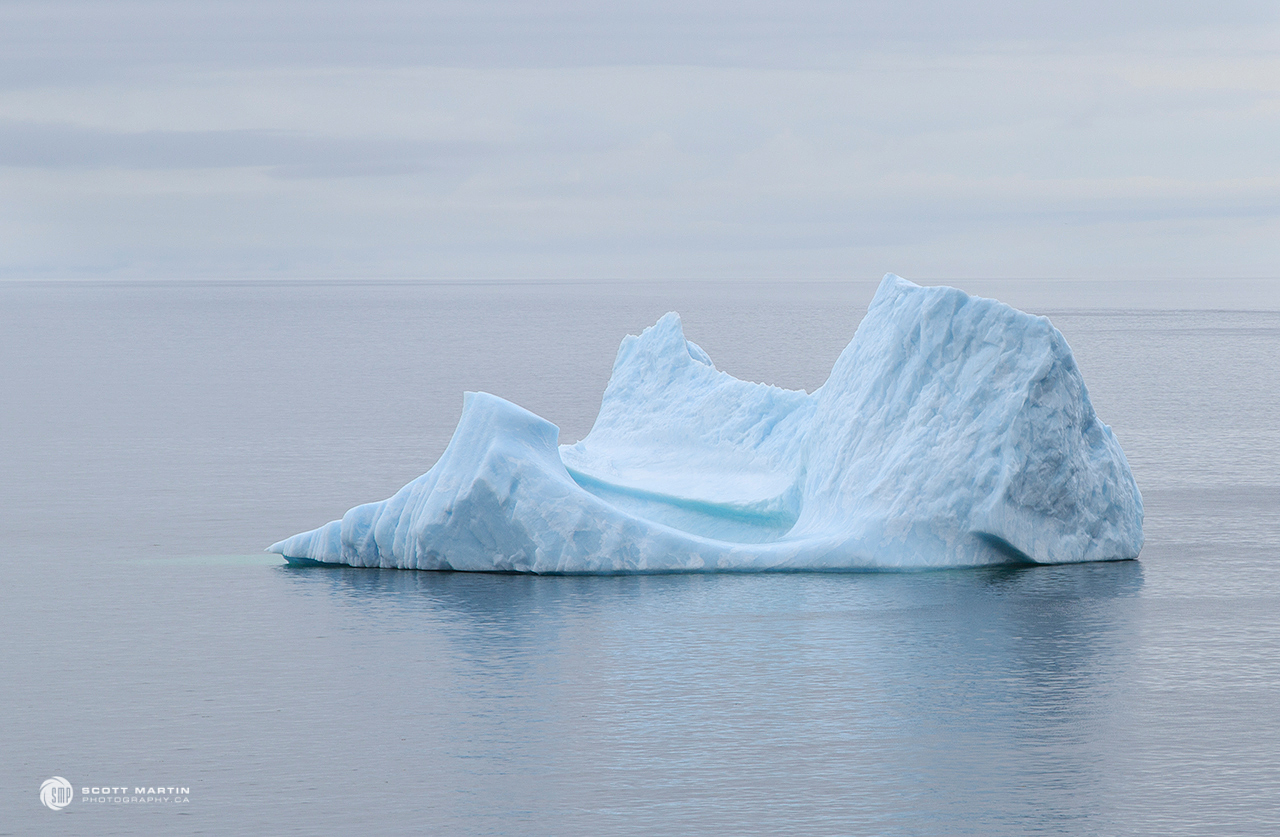
This past summer Deb & I visited Newfoundland for the first time. It was a magical place to explore and happily we were able to see and photograph the wonderful geography, historic lighthouses and quaint villages as well as three unpredictable things we had hoped to see, namely icebergs, Puffins and whales.
This year was one of the best in recent memory to see icebergs in Newfoundland due to the large numbers present and how late into the summer the pack ice remained before breaking up and freeing the mighty icebergs to drift out to sea. This allowed Deb & I to see a few icebergs at the end of July, more than a month later than usual. We had planned the timing of our visit to see Puffins and whales which made the likelihood of seeing icebergs slim, however as we daily monitored IcebergFinder in the weeks prior to our trip we were excited to find that we just might see some. (Bookmark the IcebergFinder link if you ever plan to visit Newfoundland and want to know where the icebergs are).
While staying in Twillingate, part of the region known as Iceberg Alley along the North Coast of the island, we heard a large iceberg was just a few kilometres away in Crow Head. Neither Deb nor I had ever seen an iceberg and will never forget the feeling of cresting a hill heading into the village and seeing a huge iceberg sitting majestically just off shore. I had to stop the car and take a pic 🙂
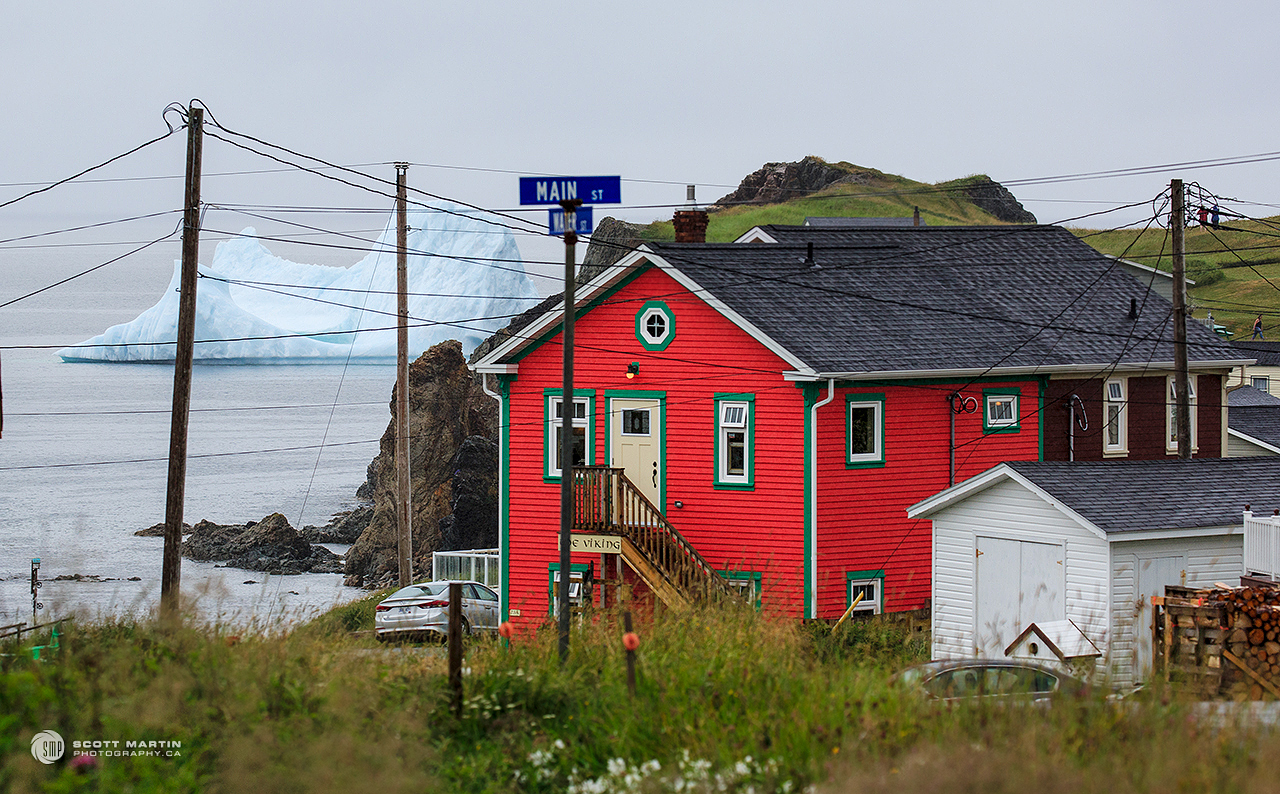
We quickly made our way to a great vantage point to see and photography the iceberg.

Icebergs are formed when they calve off a glacier and typically survive for three to six years before passing out of existence. Most icebergs in Newfoundland are formed when they break off glaciers in Greenland and currents take them southwest where they encounter the Labrador Current which they follow until they physically break apart due to the erosive action of the wind and waves or simply melt as they stray into warmer waters.
We were thrilled to see a Minke whale slowly swim behind the iceberg and give a bit of context to the size of the iceberg. Minke Whales are up to 30′ long and the locals were saying the iceberg was 200′ wide and 75′ high. It was grounded in 580′ of water! Take note of the iceberg water level in this picture and compare it with the images to follow.
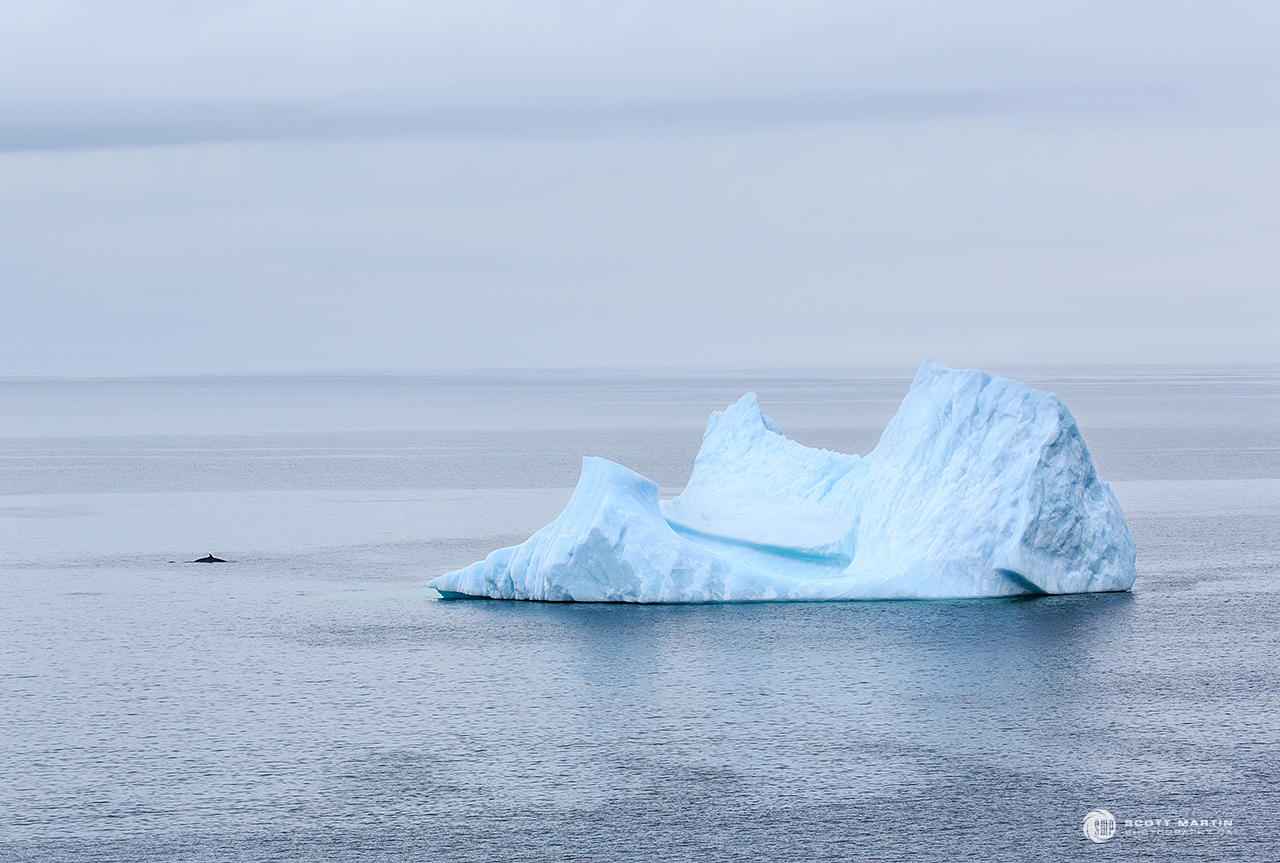
These two kayakers, much braver than Deb or I, also provide some context, but have you noticed the changing water levels….the iceberg was destabilizing and starting to roll!
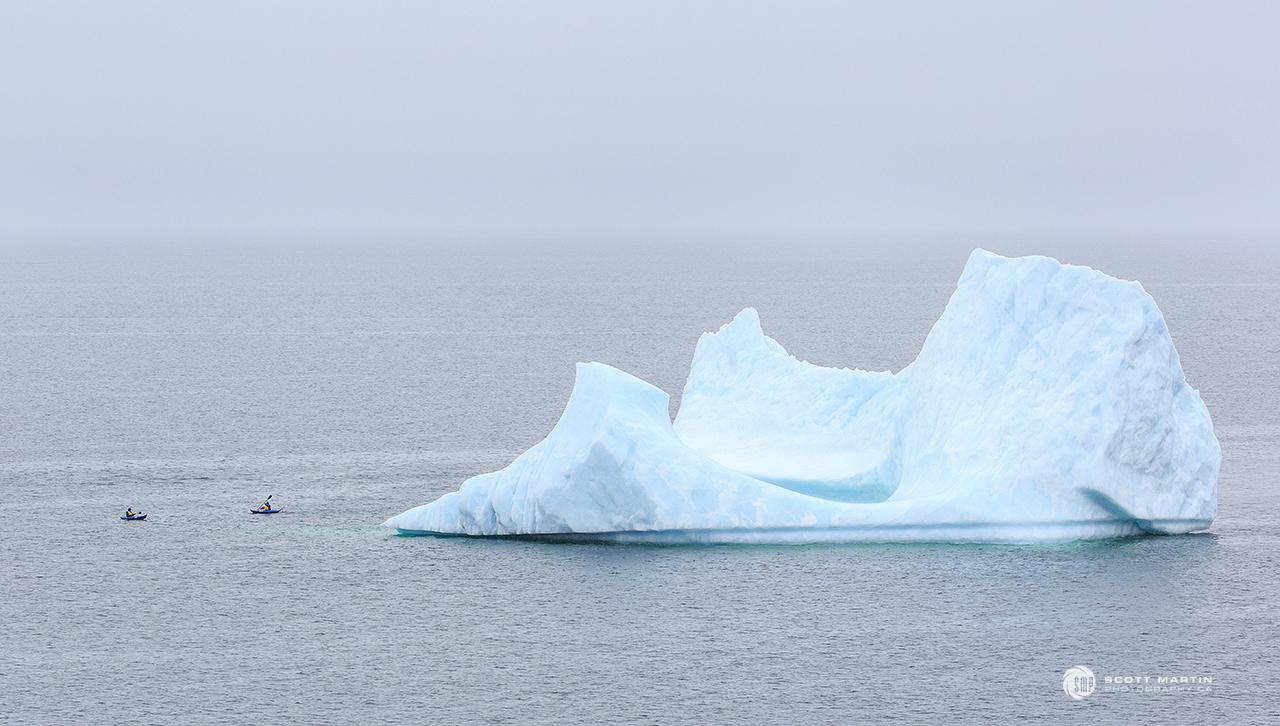
As the iceberg moves, the weight distribution is altered which can cause the iceberg to fragment as seen in this next image. The sound of ice breaking away from the iceberg and splashing into the water is like nothing we had ever heard; like the combination of a rifle shot with thunder.
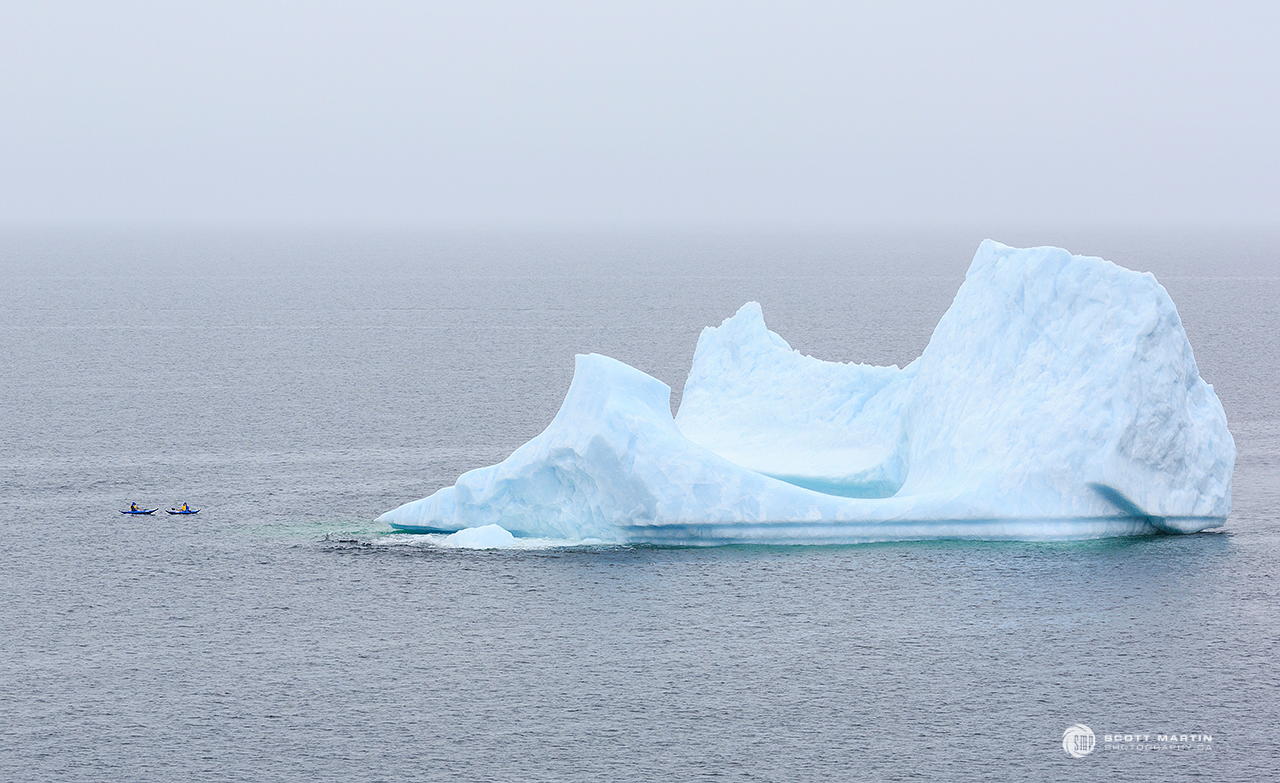
Once the iceberg began to fragment, the process continued and less than five minutes after the first piece of ice fractured and even larger segment fell off the back of the iceberg. Check the water level marks and note how much the ice mass was moving.
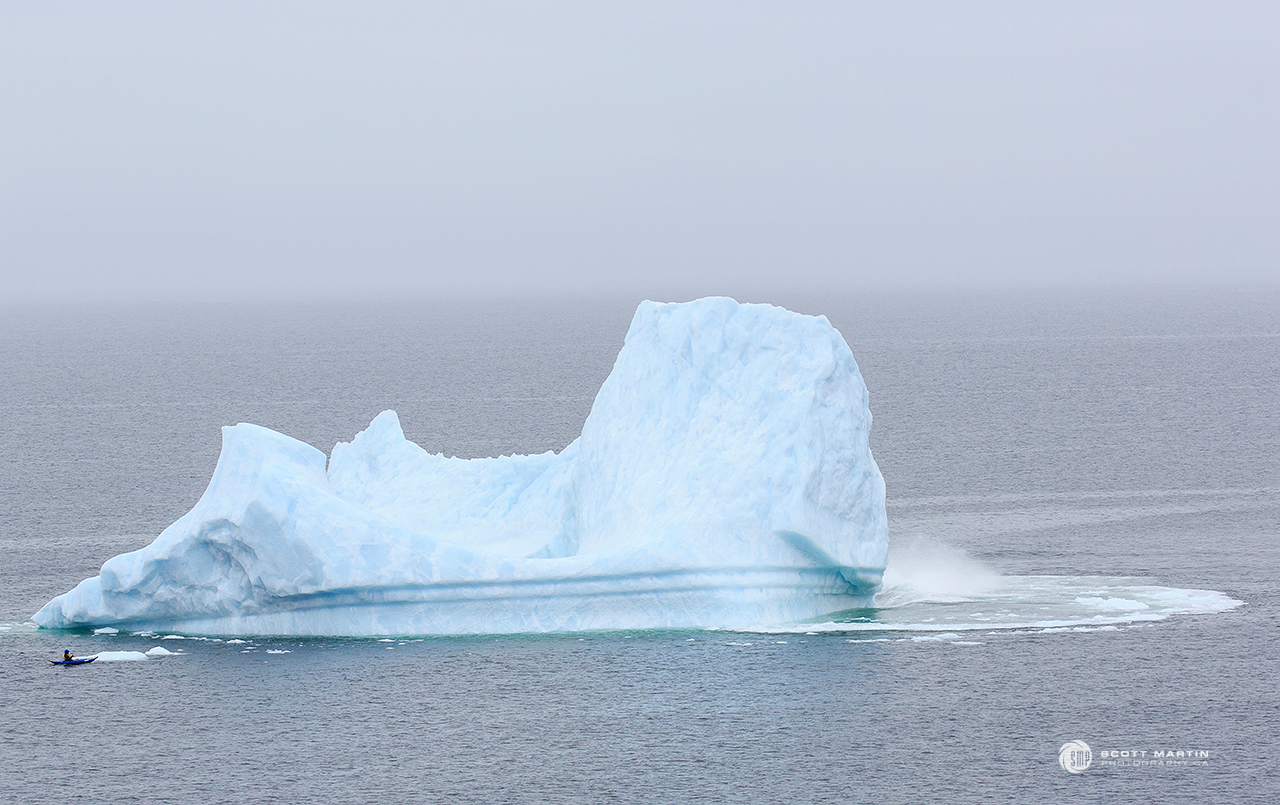
I can only imagine what it would have been like to be in a kayak while an iceberg was breaking up around me!
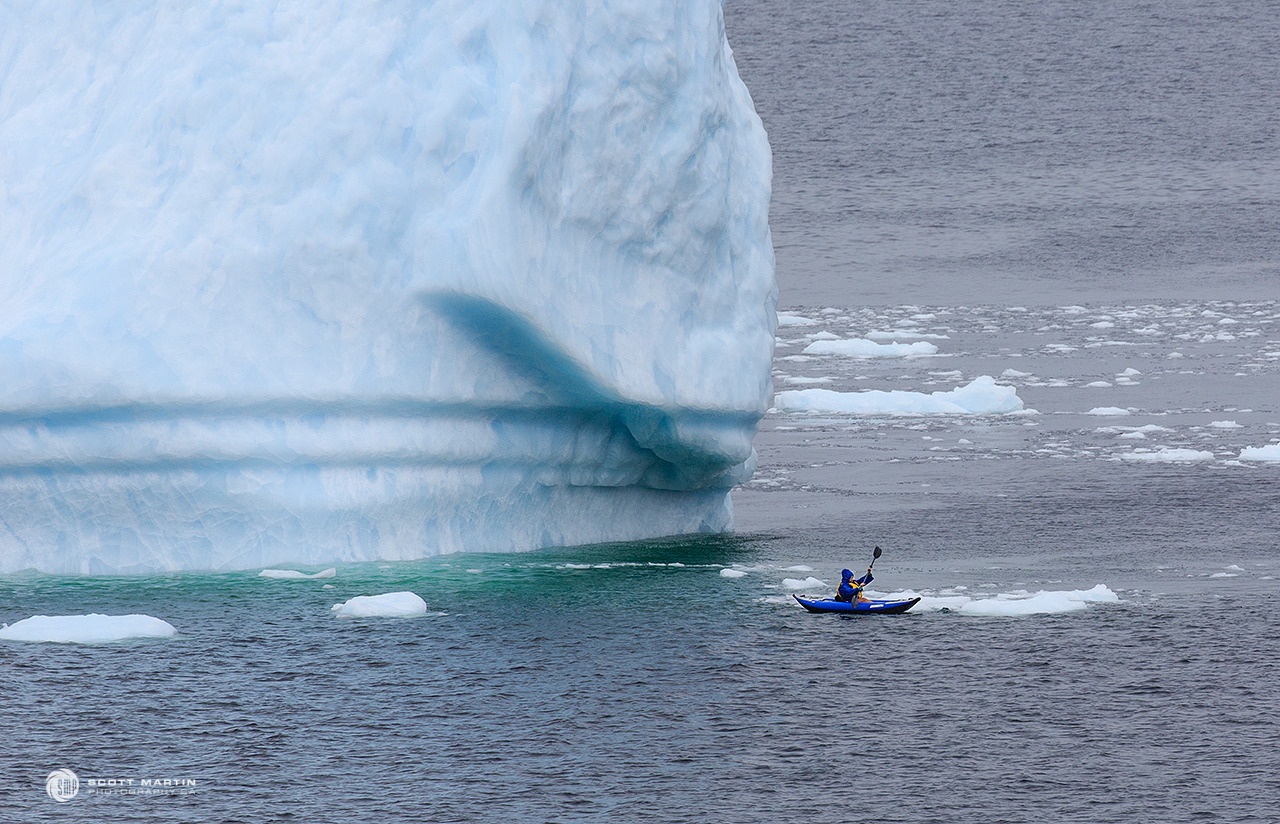
Although we didn’t try a kayak, we connected with Iceberg Man Tours in Twillingate for a two hour cruise highlighted with a visit to the iceberg. Captain Cecil was terrific and we learned so much about Newfoundland, the culture, the whales and the icebergs during our cruise. Captain Cecil is a retired teacher, who grew up in Twillingate, served as mayor of Twillingate and started Iceberg Man Boat tours in 1985. Cecil knows Newfoundland!
The little village of Crow Head, NL as seen from amongst ice fragments around the iceberg.
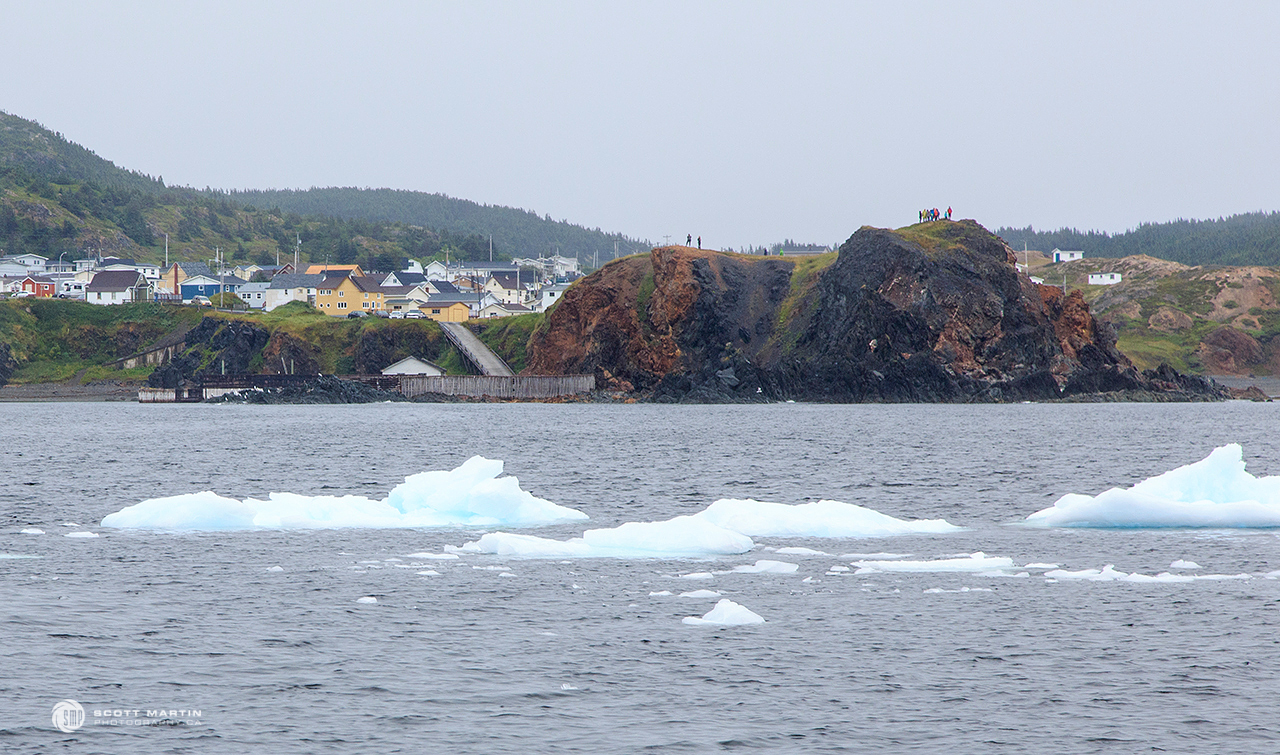
We circled around the iceberg a number of times, taking more than 500 images of it from every conceivable angle. It was hard to put the camera down!
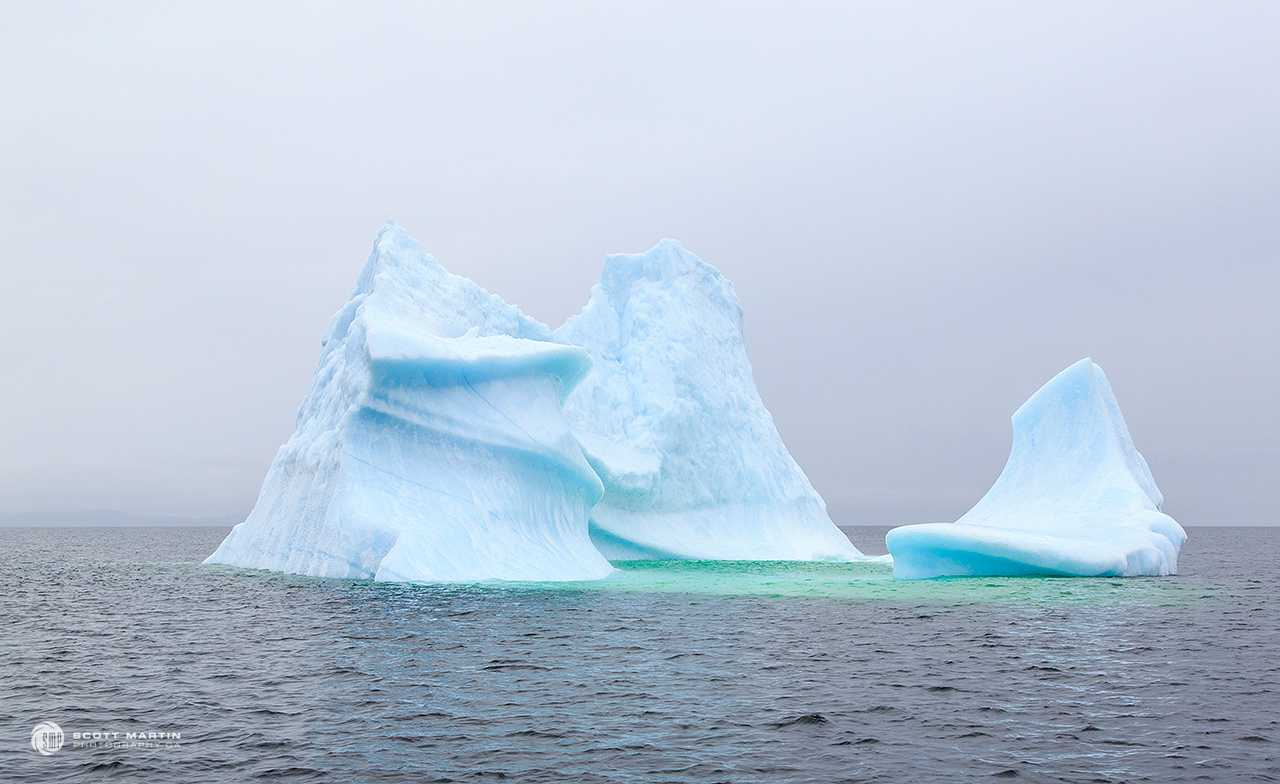
.
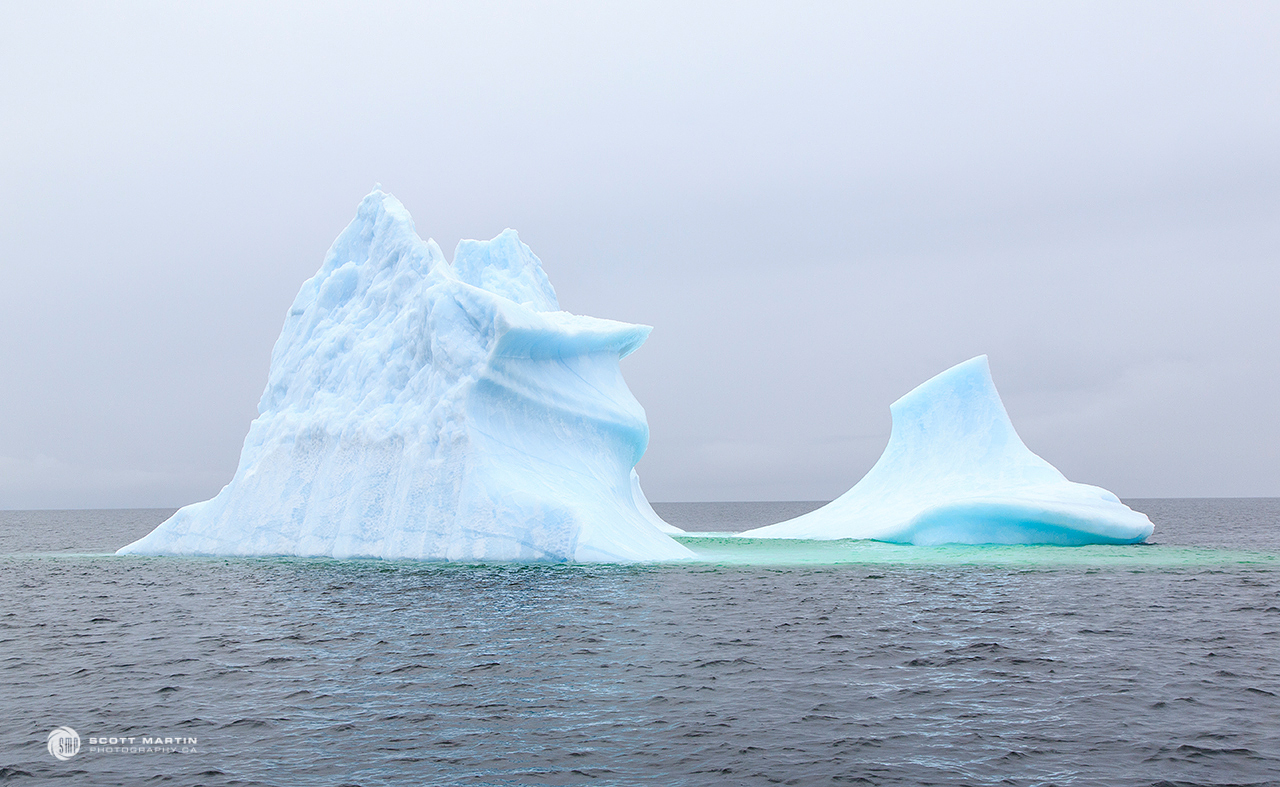
Like modern pieces of art.
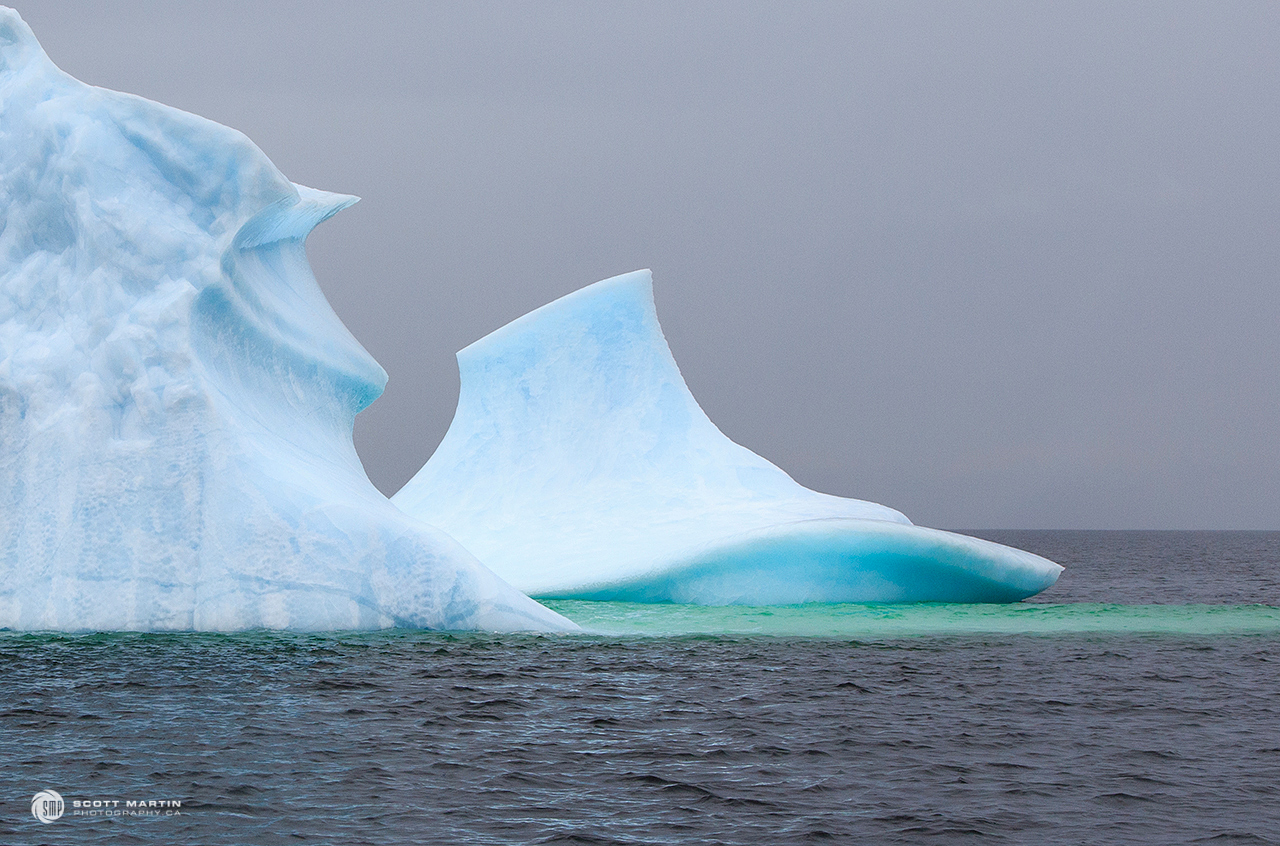
The approaching ship provides an interesting size perspective for the next image.
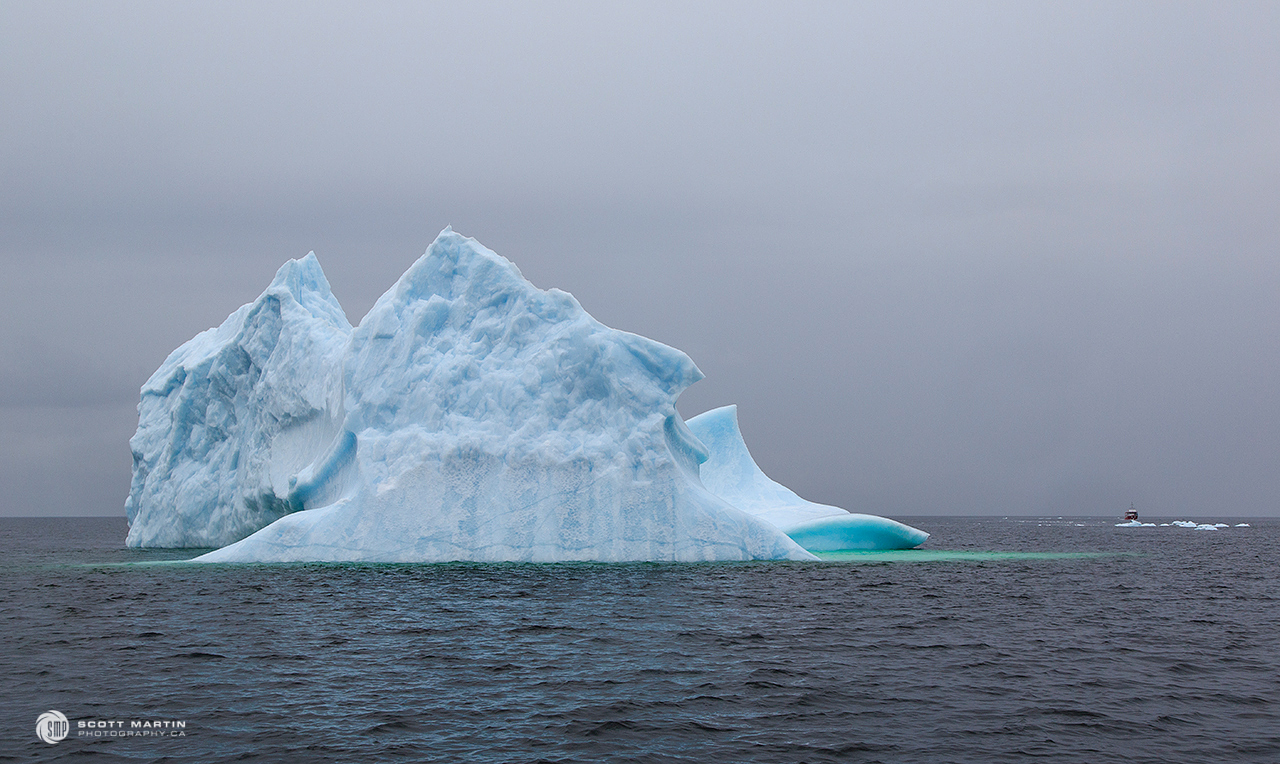
.
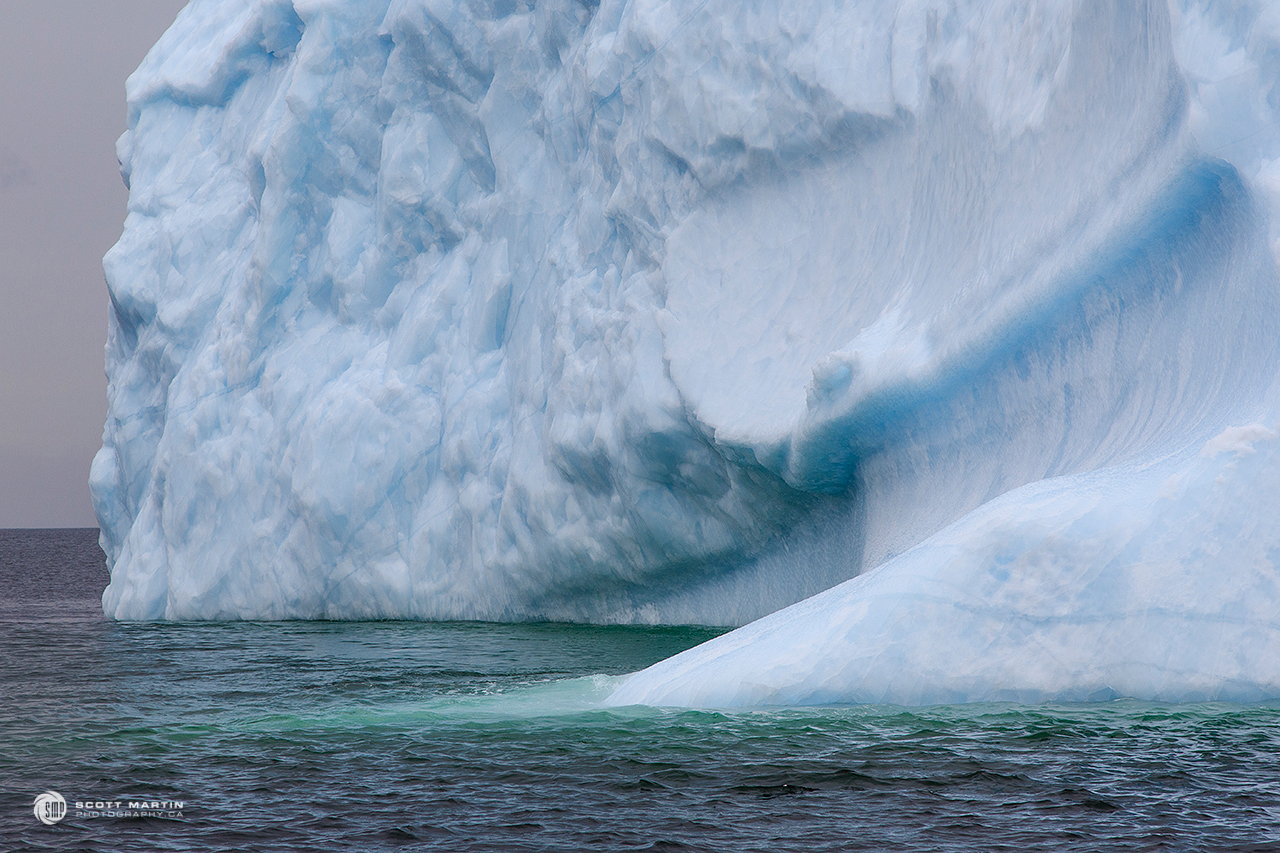
After returning to Captain Cecil’s dock in Twillingate and enjoying dinner in a little restaurant on the edge of the harbour we headed back to Crow Head to watch the sunset and see the iceberg one last time. Although we couldn’t frame the sun setting over the iceberg from the mainland, we did enjoy the colours and the new look they gave the iceberg. It was remarkable how much the iceberg had changed in ten hours.
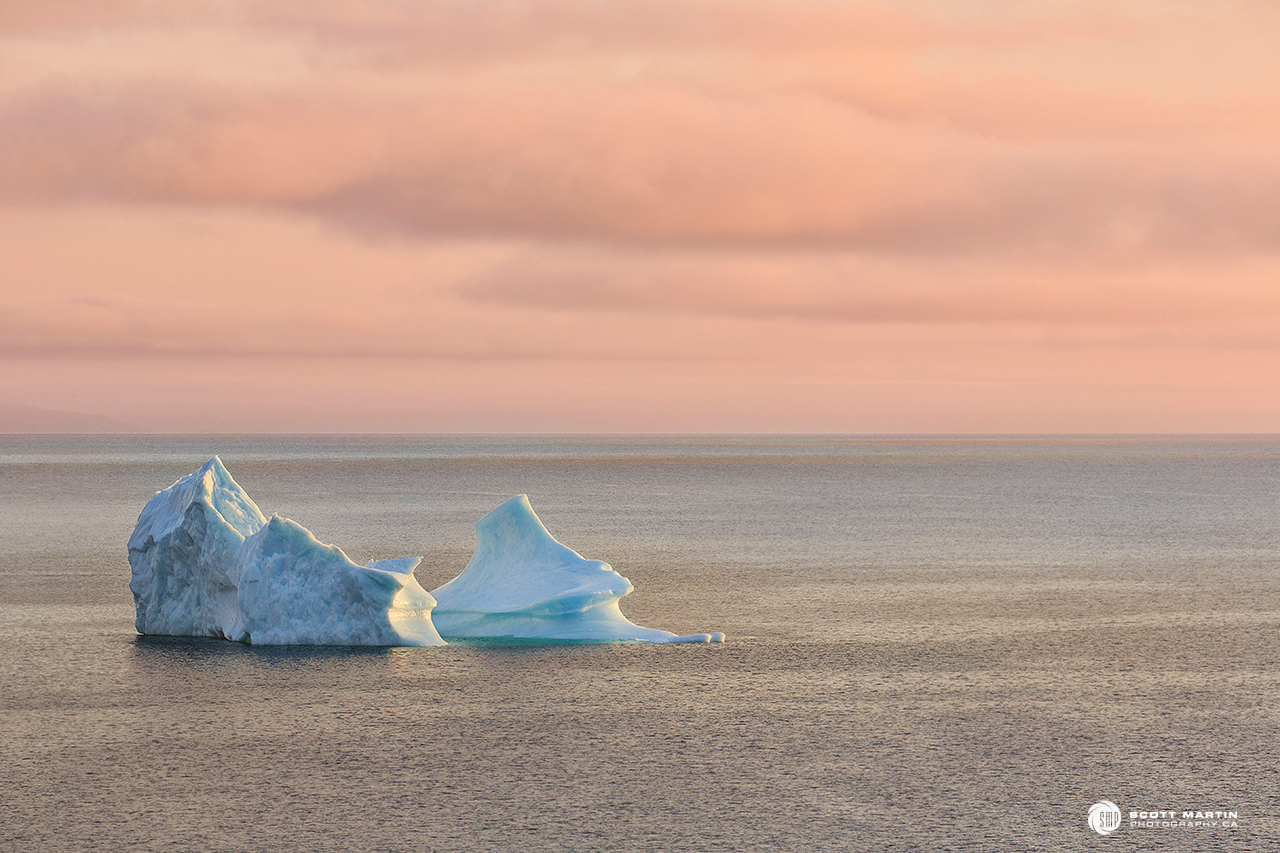
As the sun went down we were chatting with another couple and their daughter and it turned out the father & daughter were the two kayakers from earlier in the day! Ironically, as they were saying they felt more awe than fear as the large chuck of ice fell from the iceberg close to their kayaks, a loud rife sounding noise came from the iceberg and the entire iceberg began to pitch and roll quite drastically. By this time it was about thirty minutes after sunset and it was quite dark, however I just had to take some images, even though an ISO of 8000 was required.
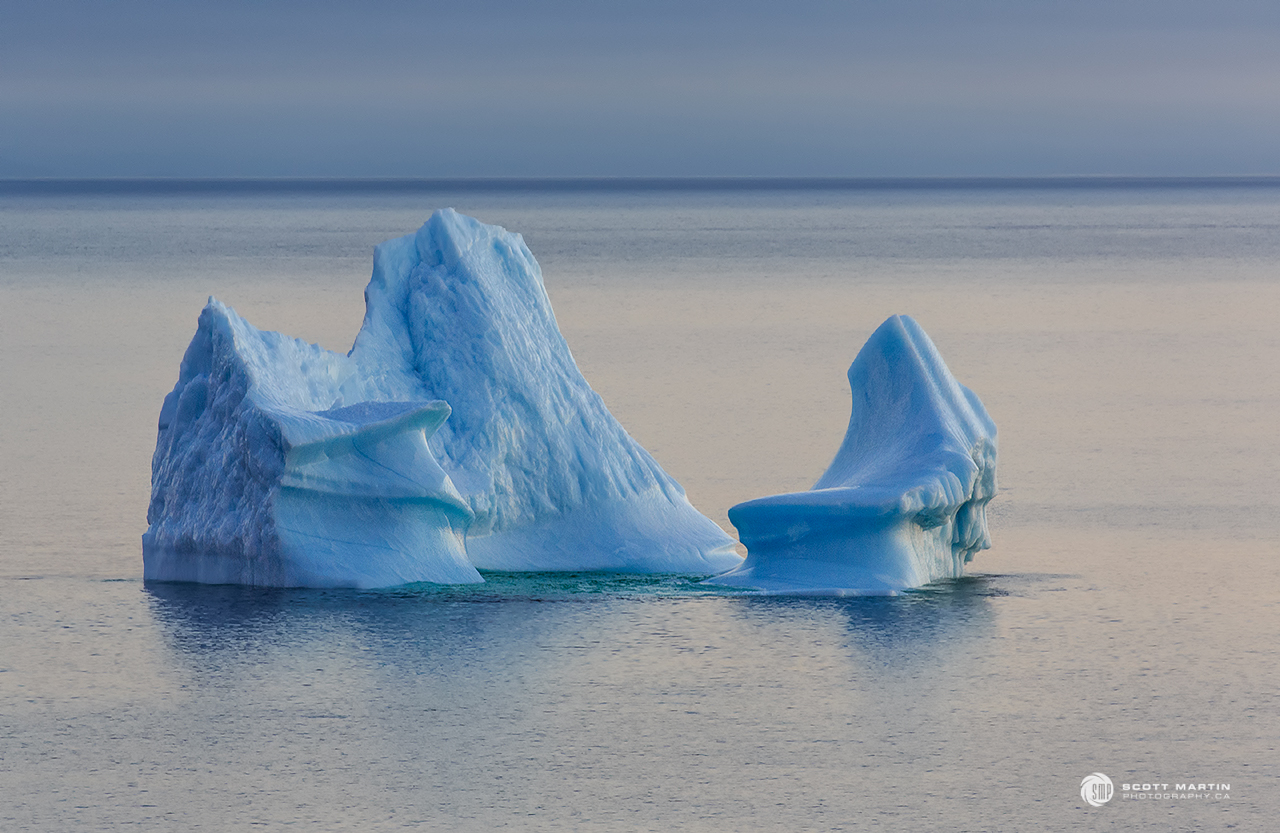
The iceberg slowly begins rotating in a clockwise direction.
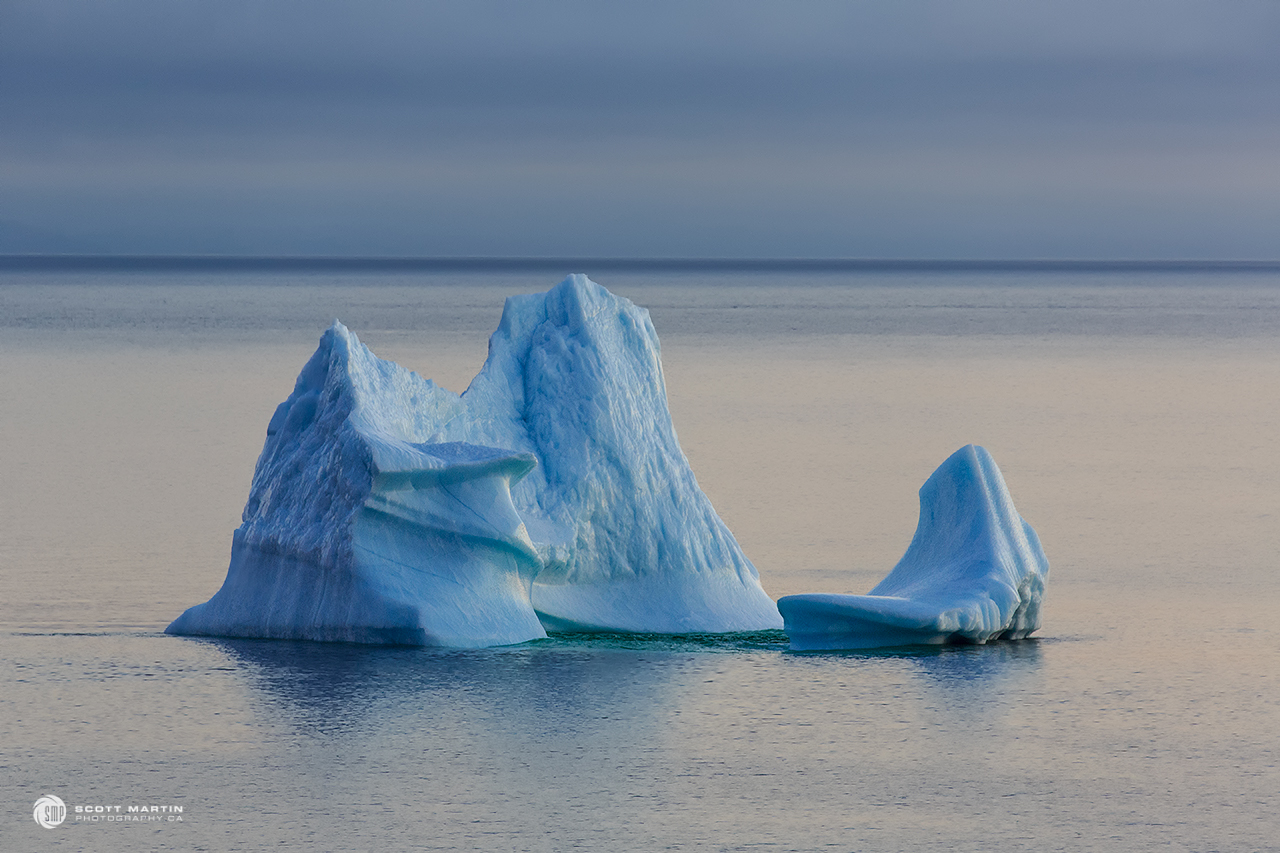
.
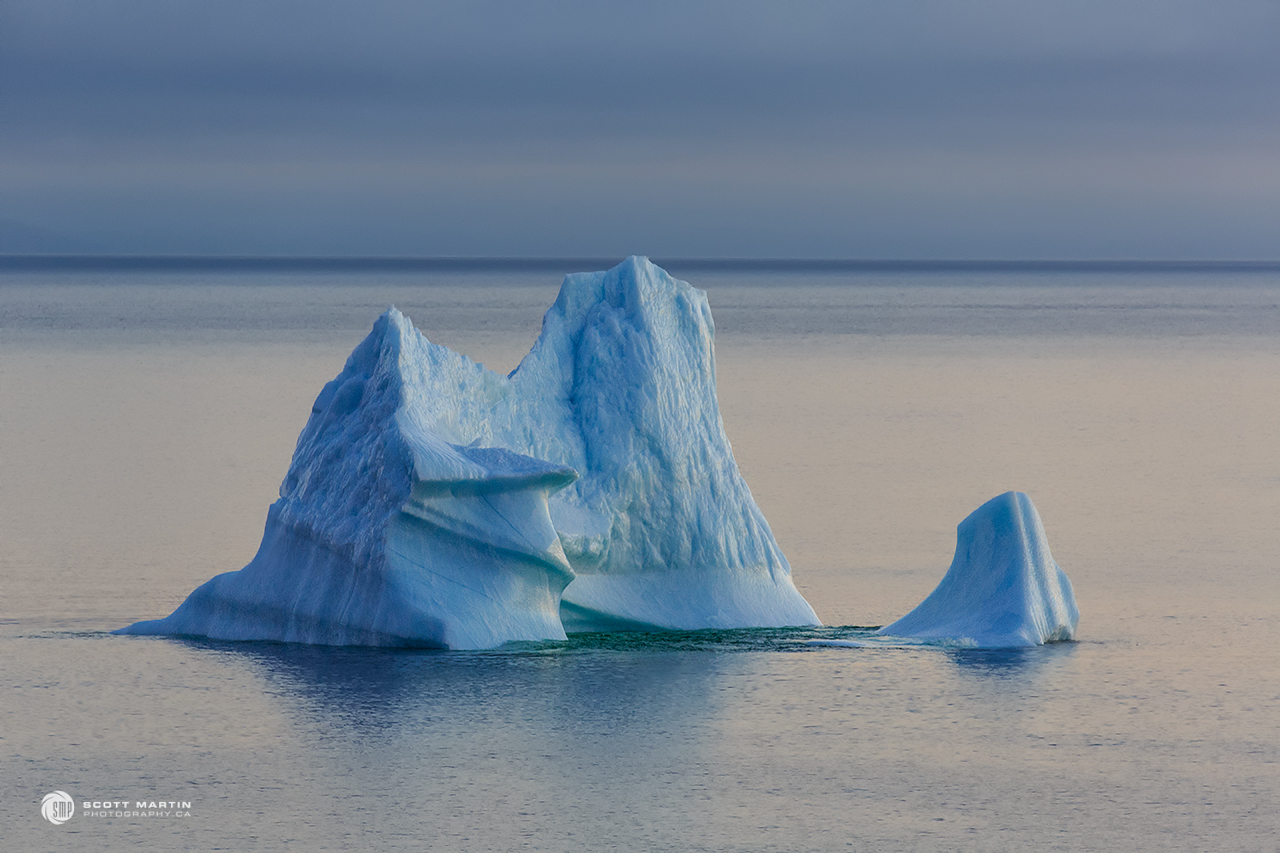
.
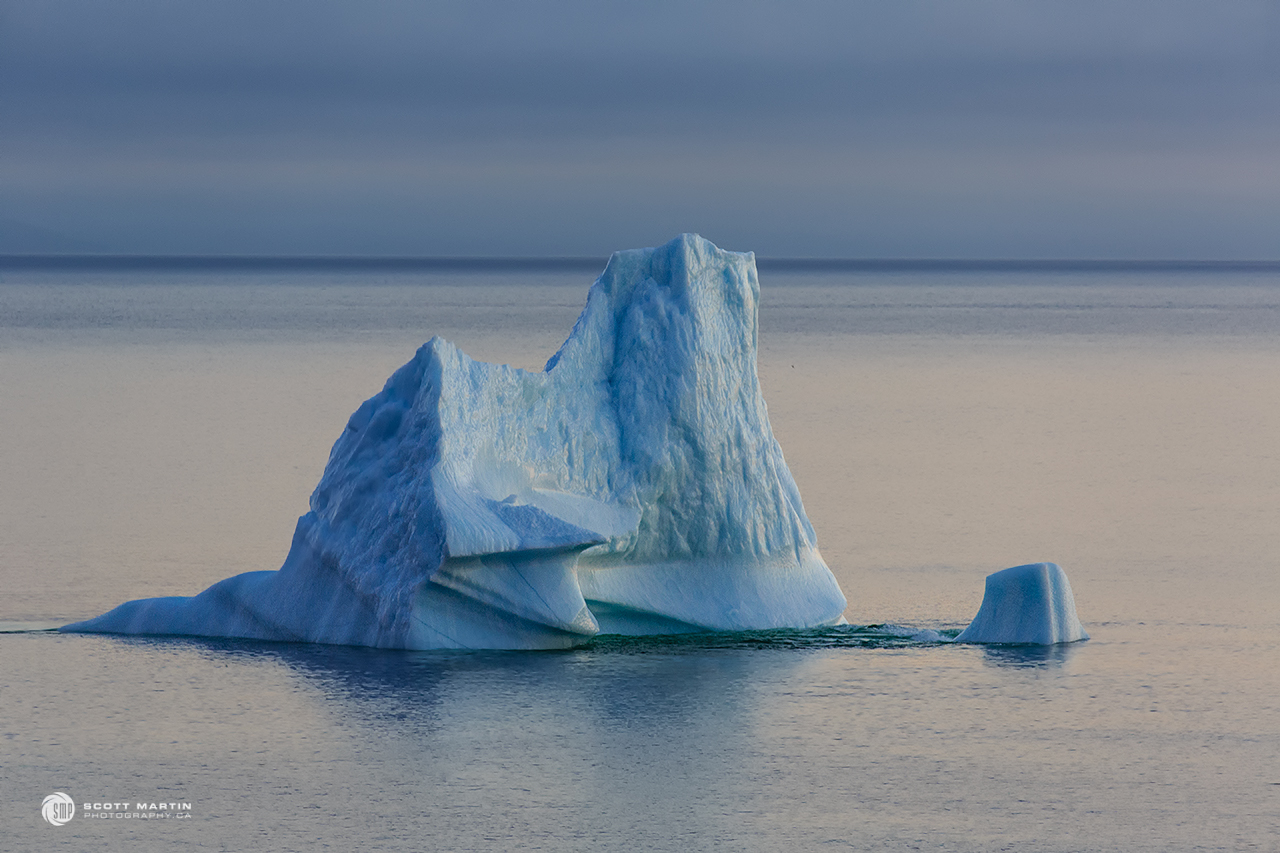
The beautiful modern art looking section of the iceberg is about to disappear forever.
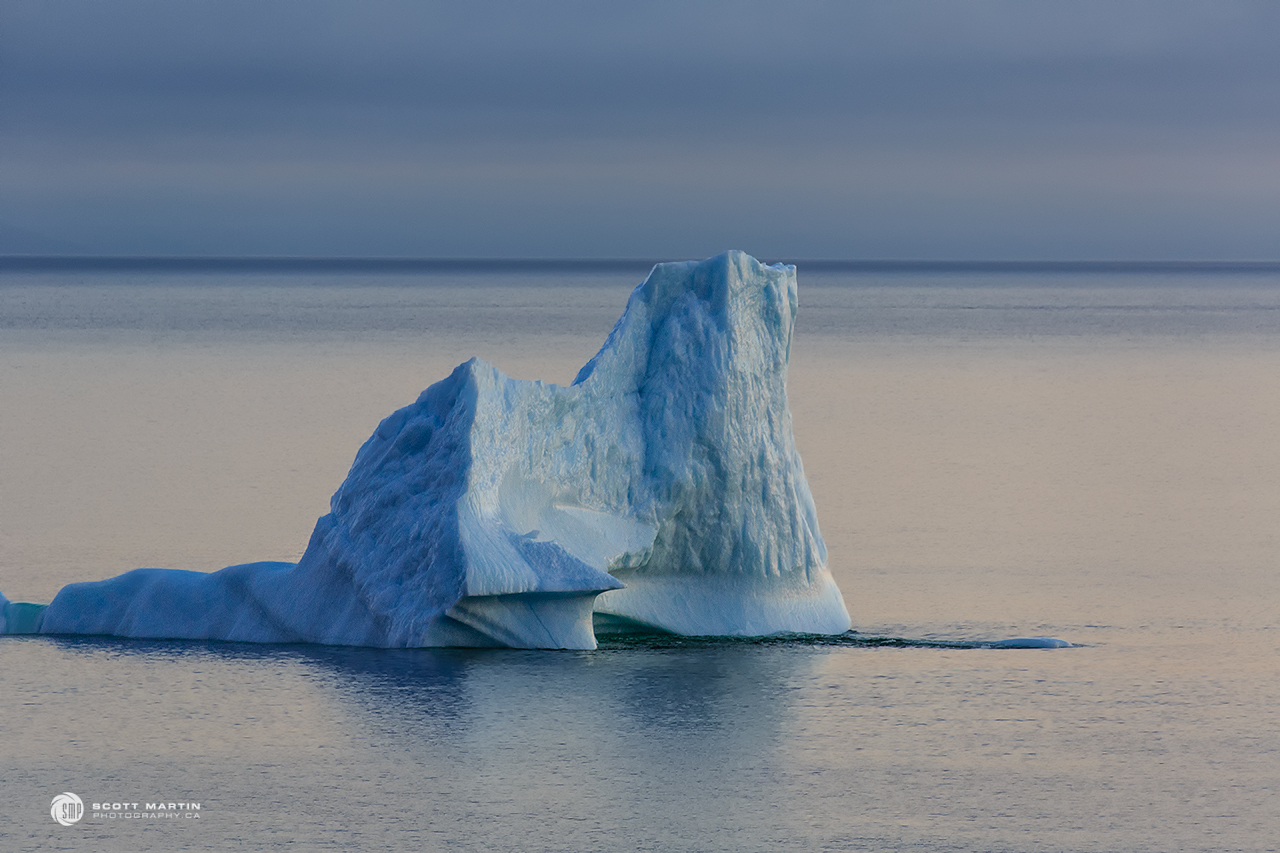
As the iceberg rotates a whole new mass of ice appears on the left side. This section was about 100′ in length.
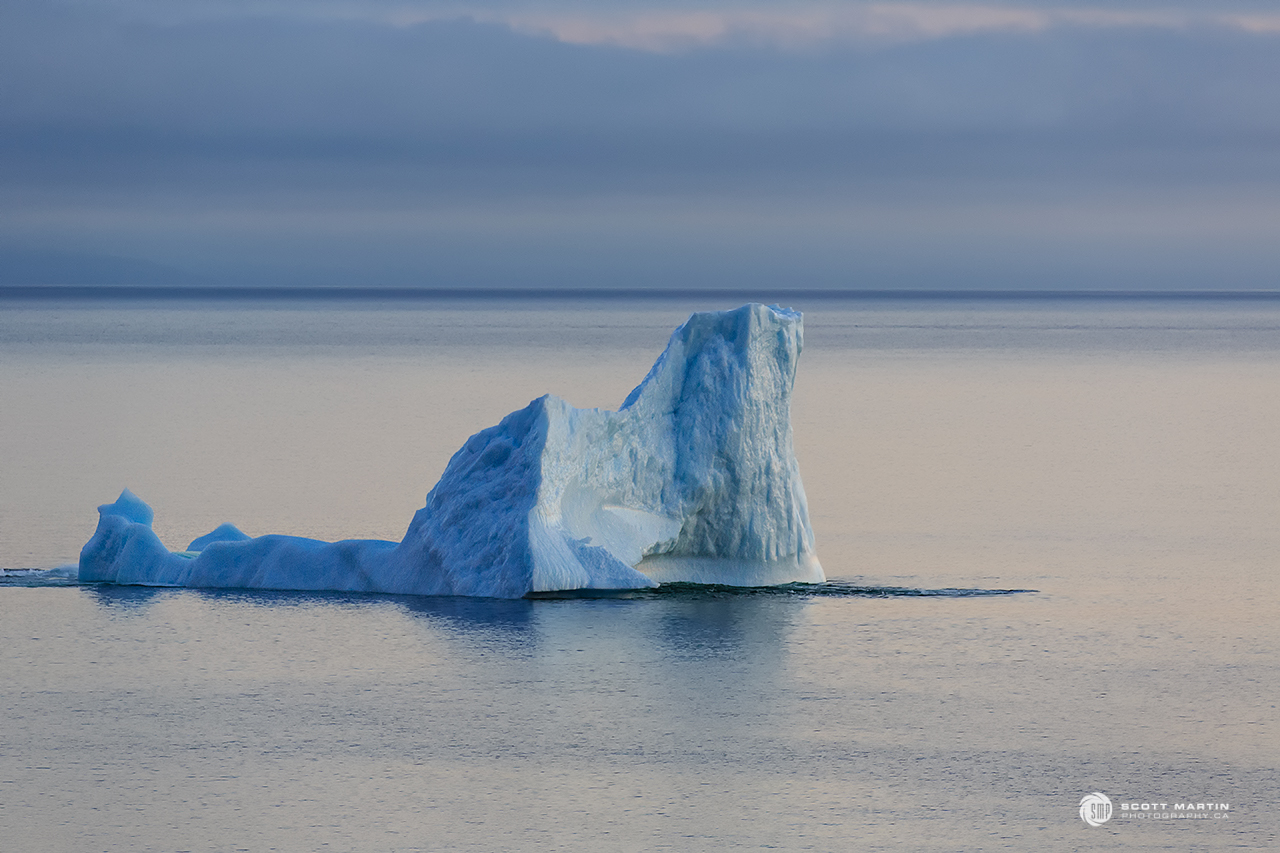
.
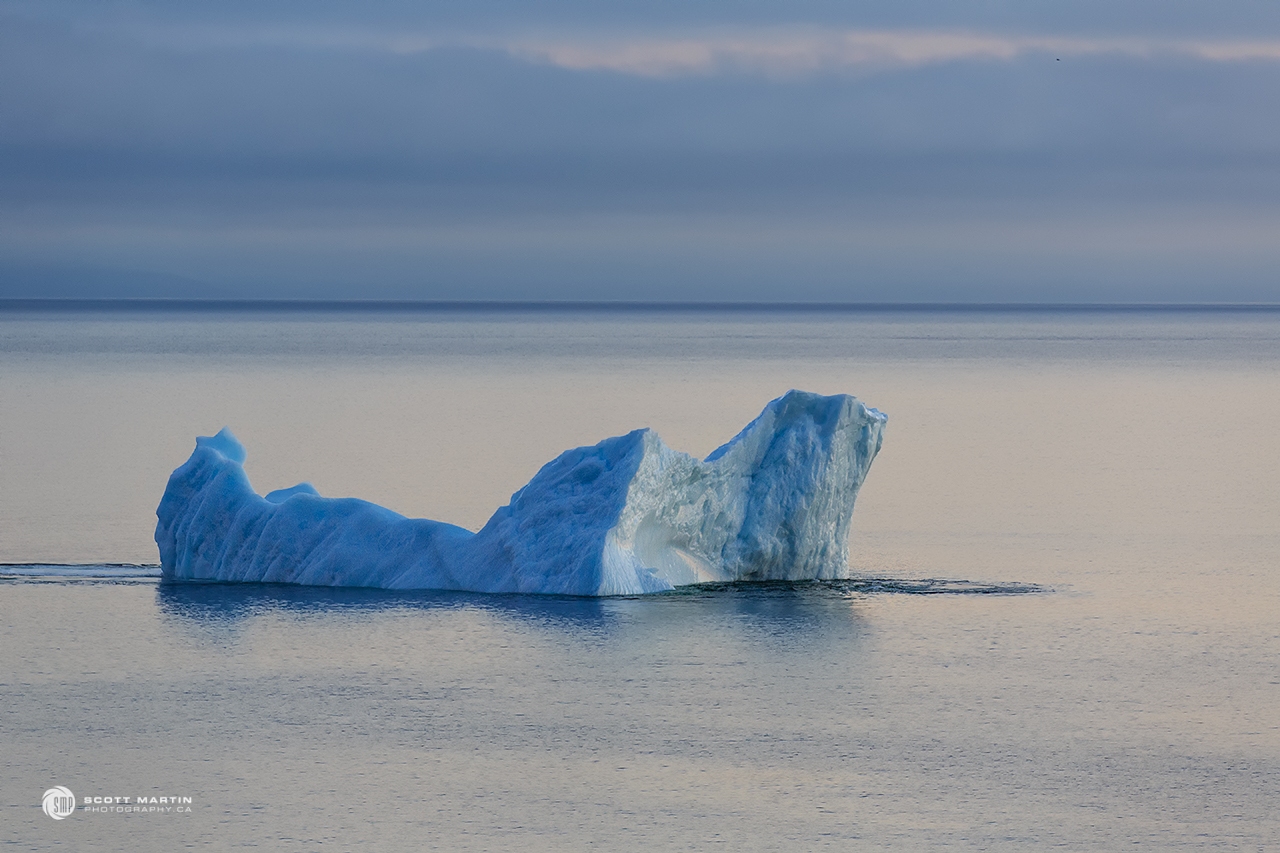
The image above shows the iceberg at its maximum rotation and now it slowly reversed its rotation and began to roll away from us. The unsettling of the iceberg caused another large pice of ice to flake off, as seen on the right side of the following image.
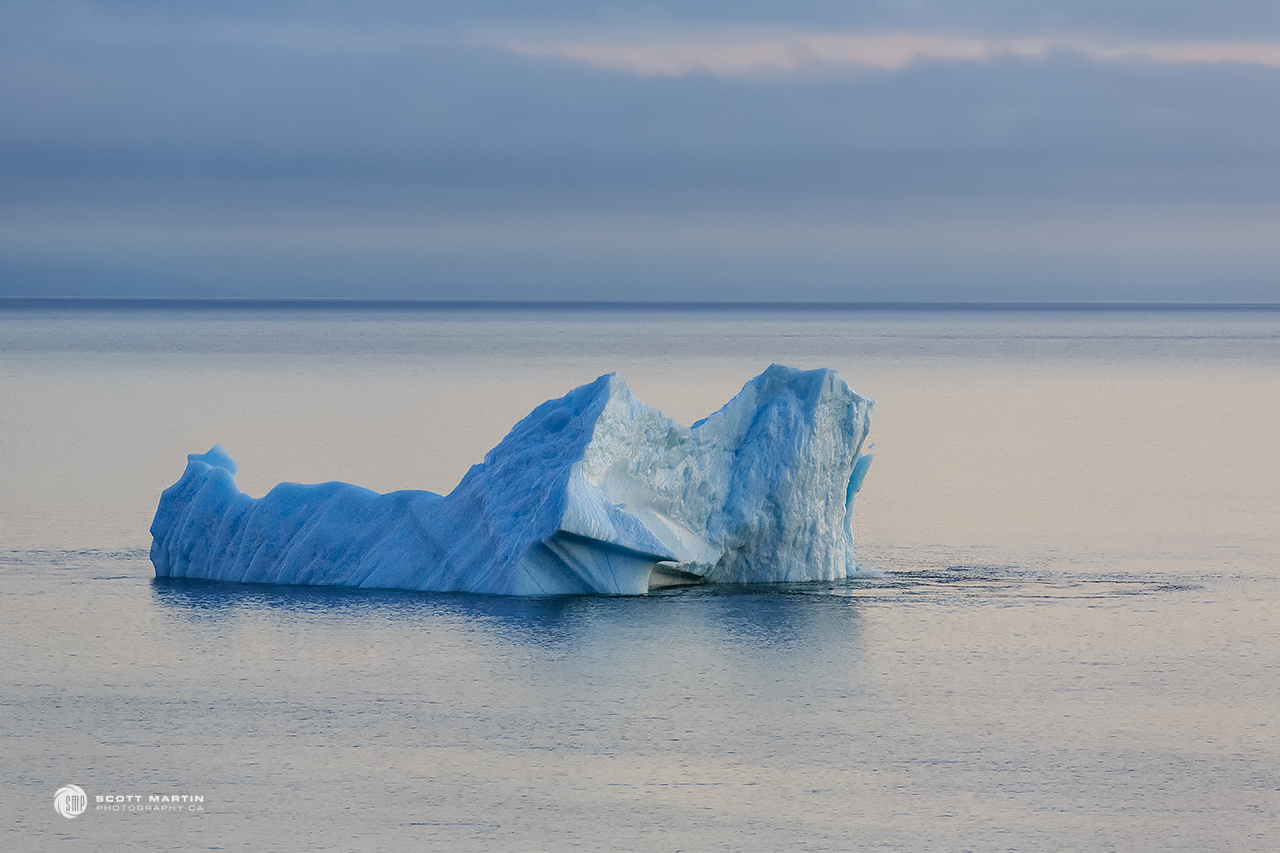
This was a huge pice of ice, at least thirty feet in height. The sound of the fragmentation and ensuing splash was a unique and unforgettable sound.
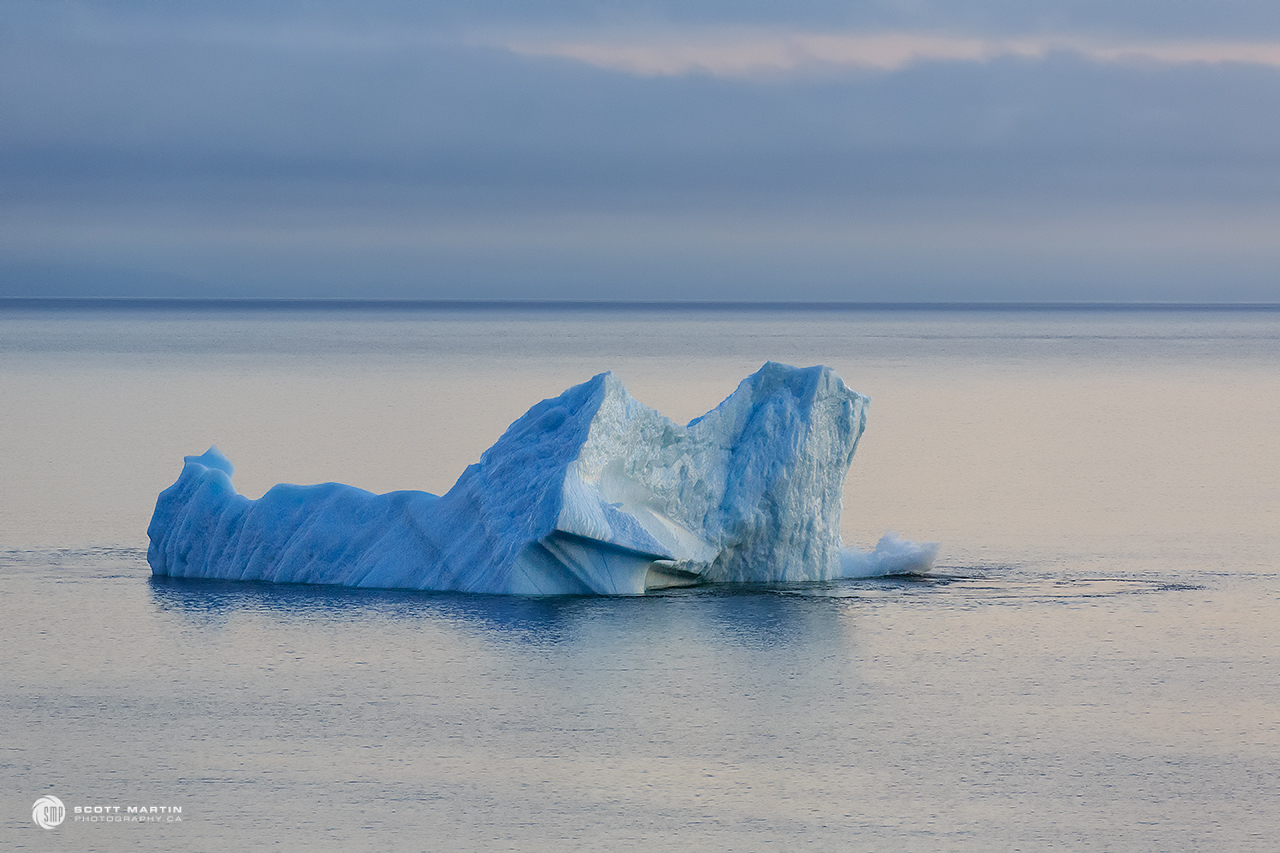
.
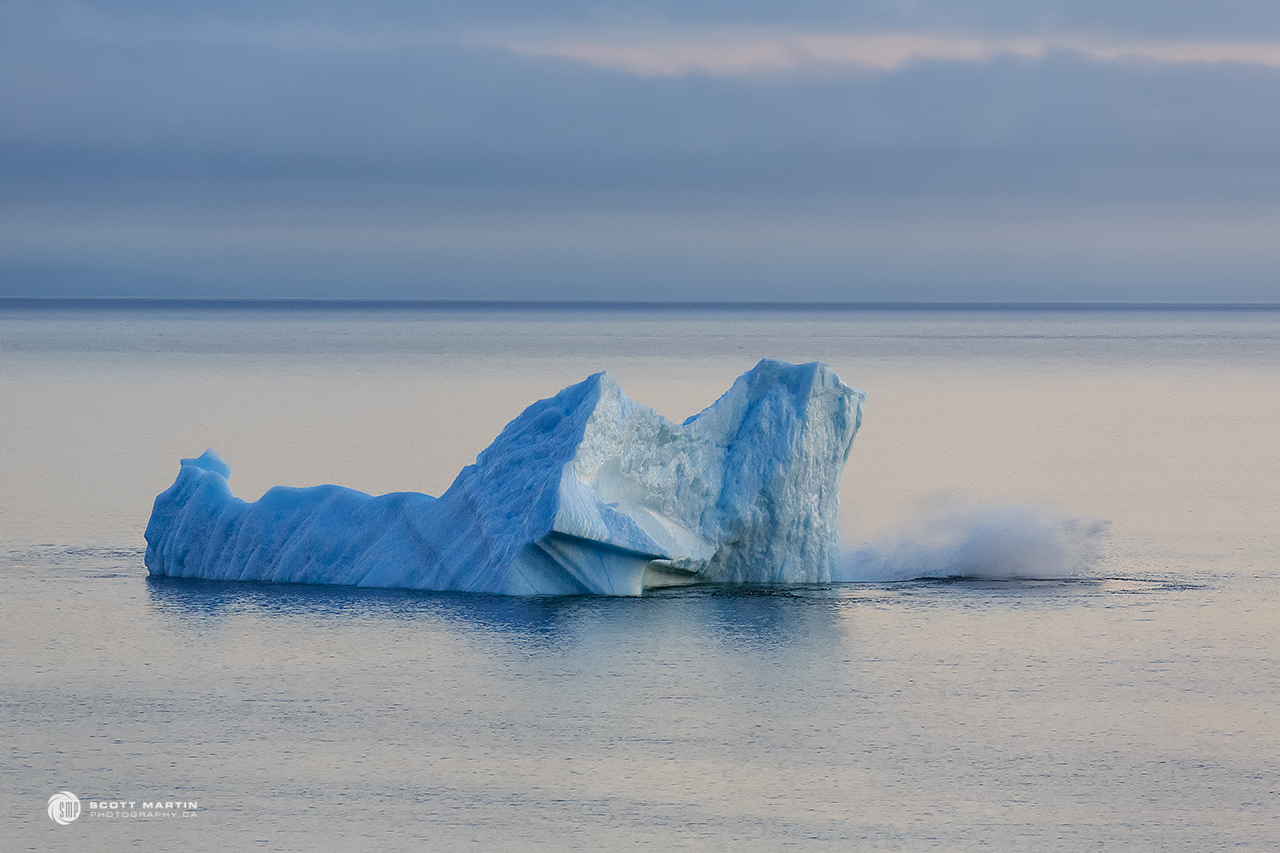
After the enormous splash, the iceberg silenced and the surrounding waters calmed.
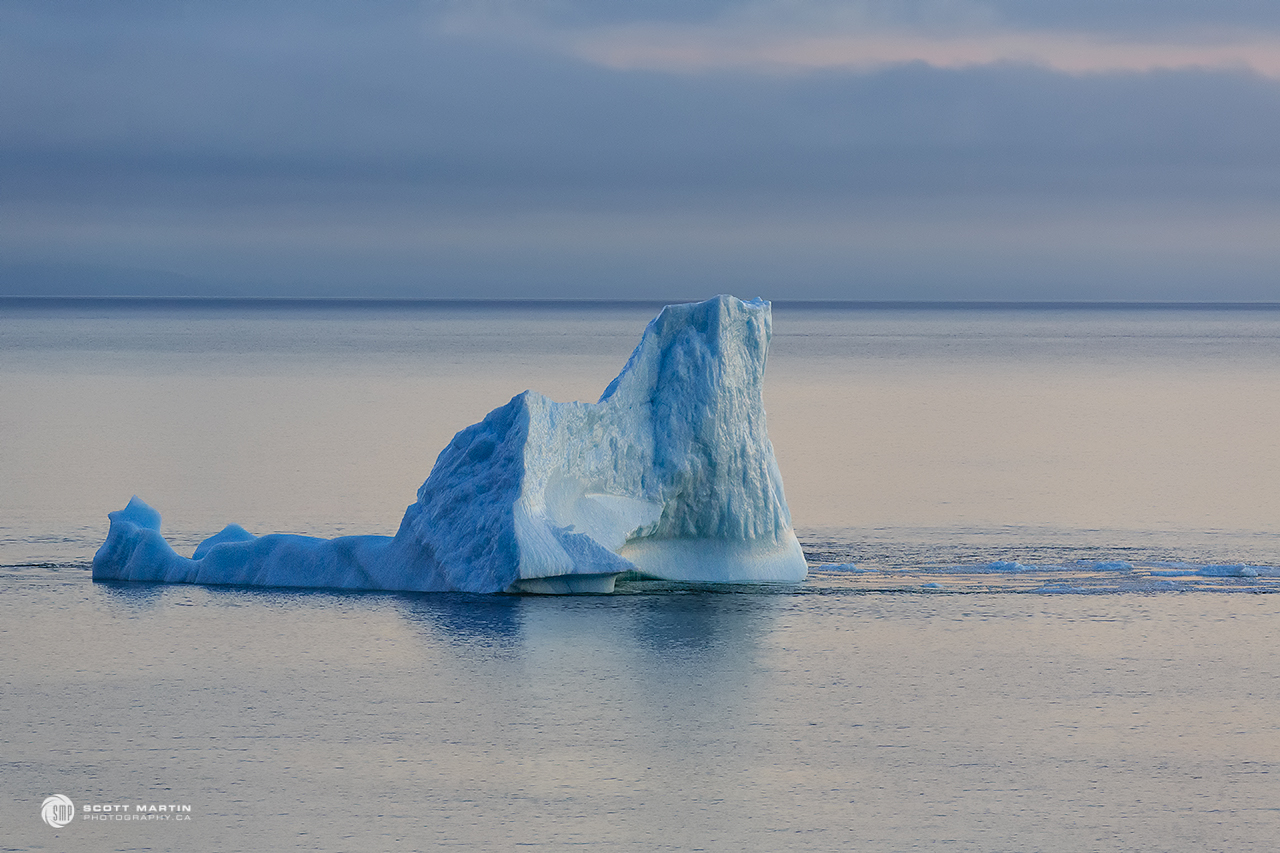
The previous images were taken over approximately ten minutes and by the end of that time the iceberg had loosed itself from the ocean floor 580′ below and slowly started drifting out into the North Atlantic. All of the images in the previous sequence were taken with the camera on a tripod so you can get a sense of how much the iceberg was moving by comparing its profile against the horizon.
When we left our hotel early in the morning, Deb & I had no idea we would be spending the entire day watching an iceberg, but what a day it was. Never having seen an iceberg before and then watching it break apart over the day and move out to sea was a highlight of the trip. We highly recommend when travelling to ‘The Rock’ that you schedule a time of the year you are likely to see some icebergs. They will never disappoint.
More images of icebergs can be found in the Iceberg Gallery while images from ‘The Rock’ can be found in the Newfoundland Gallery.
If you haven’t already done so, please subscribe to the blog and receive notification of future blog posts. The next two or three will be centred on Newfoundland; its rugged geography, old light houses, Puffins and Humpback Whales!
As we come to the end of another year, I’d like to thank all of you who have followed the blog. Your comments, support and encouragement are much appreciated. From our family to yours, a very Merry Christmas and Happy New Year.
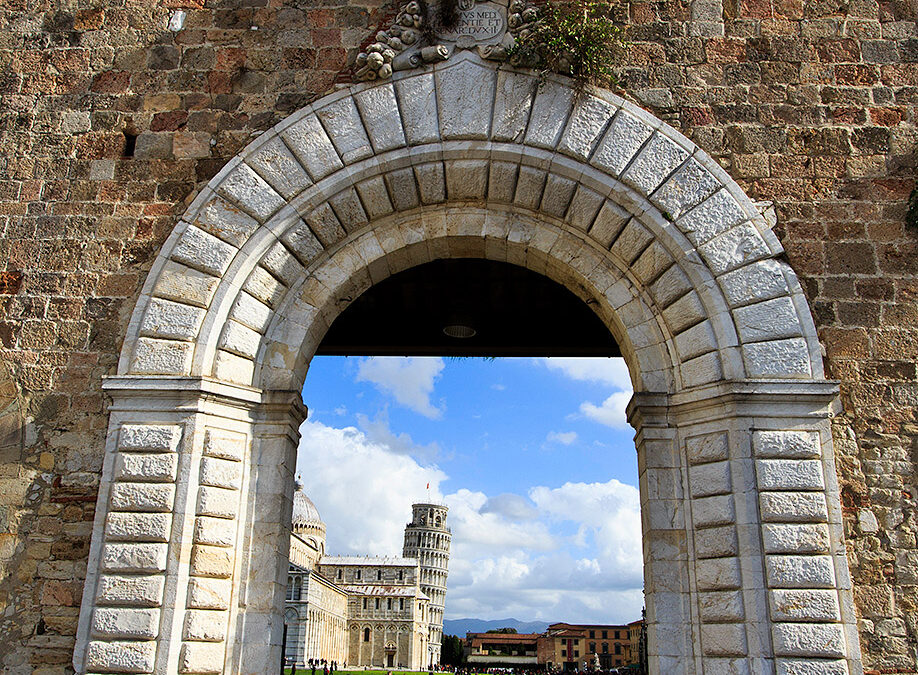
The beautiful country of Italy is home to many unique and well known buildings with the Leaning Tower of Pisa being among the most iconic. As Deb & I left Cinque Terre and headed to the Amalfi coast for a few days in Positano we made it a point to stop and visit the Leaning Tower.
Pisa is a coastal city of over 90,000 people in the famous Italian region of Tuscany. The Leaning Tower of Pisa is a free standing bell tower, or campanile, of the Pisa Cathedral. The partially walled grounds of the cathedral have three primary buildings; the cathedral, the baptistery and the campanile. As we approached one of the gateways to the campus we experienced our first glimpse the Leaning Tower. One of the many joys of travel is the feeling engendered when seeing an iconic landscape or building in person for the first time and this image captures that moment with the famous bell tower.
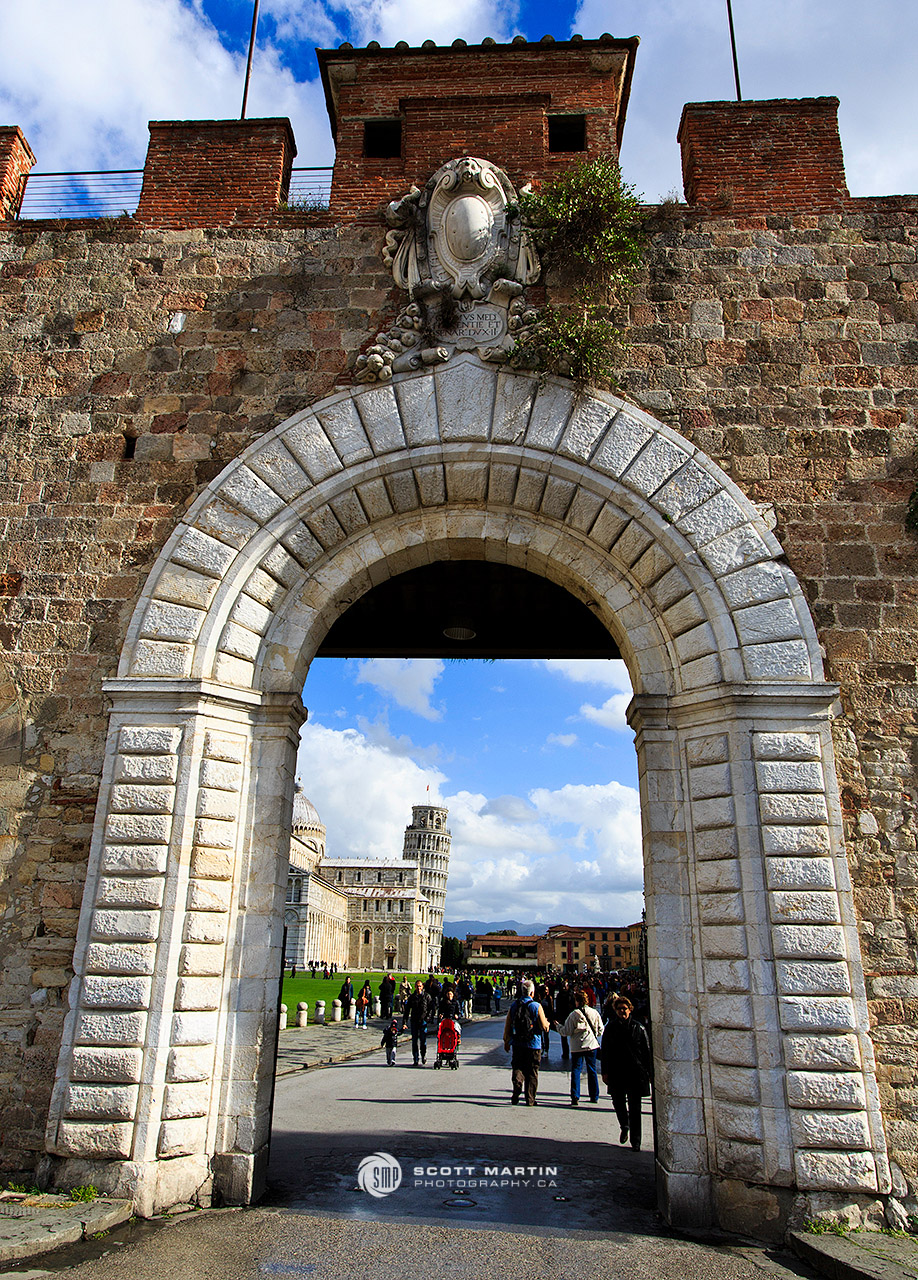
The tower is ~185 feet high and took many many years to complete. The tilting of the tower began to occur during its initial construction primarily due the sandy ground on one side of the tower being too soft to support the extreme weight of the structure (14,500 metric tons).
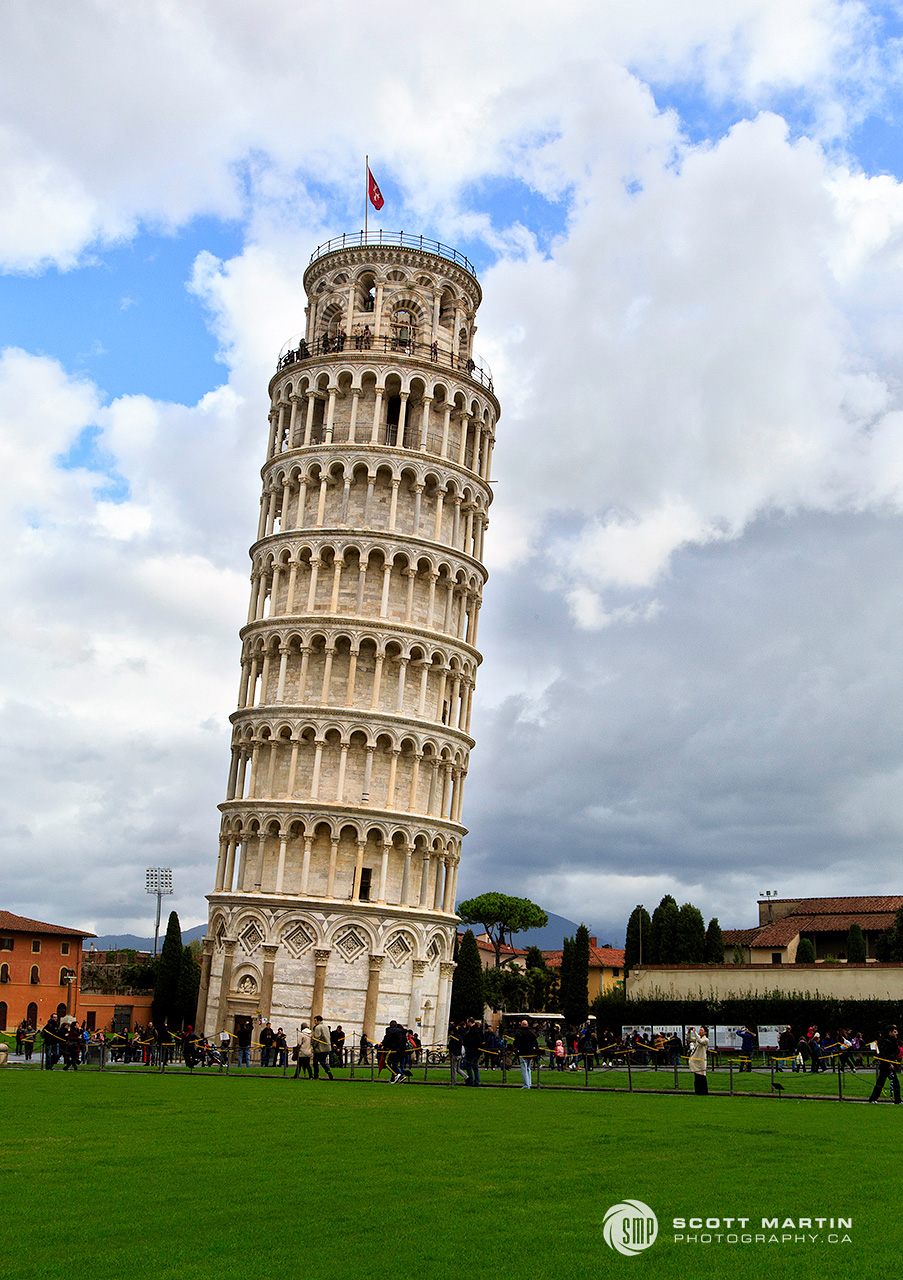
The walls at the base of the tower are made of solid white marble and are an incredible eight feet thick in order to create a sufficient support on which to build the seven stories above. Unfortunately, the ground below didn’t do as well! It’s hard to believe that the below grade foundation is only ten feet deep for a structure that is almost 200′ high. Certainly the design of the tower was flawed from the outset.
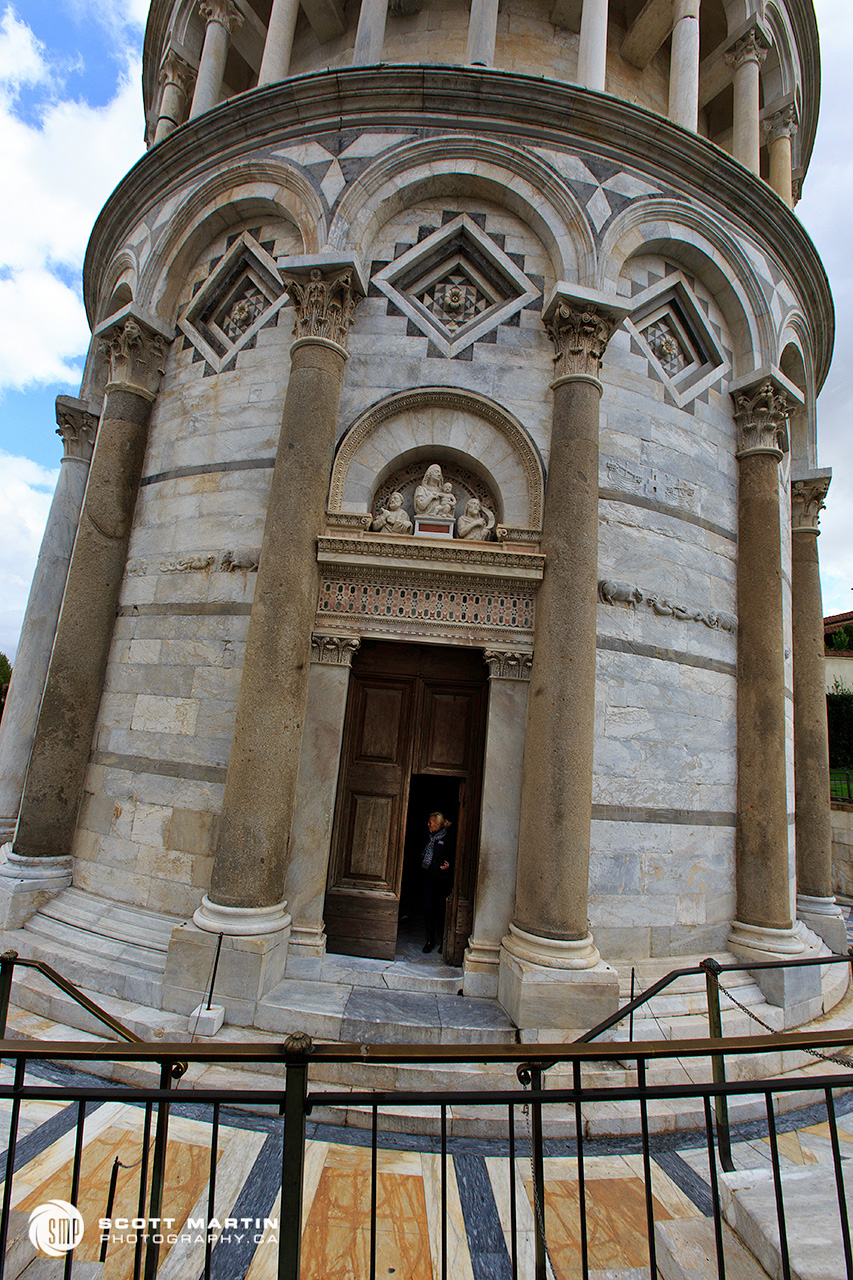
Construction of the tower began on August 14, 1173 and wasn’t completed until 1372 when the bell chamber was finished atop the tower 199 years after the ground breaking. Recent cleaning and surface restoration of the tower removed centuries of dirt & grime from the industrial revolution which had darkened the tower to a dirty grey colour. This next image shows the beautiful white sunlit marble against a stormy dark back ground. It really is a beautiful structure.
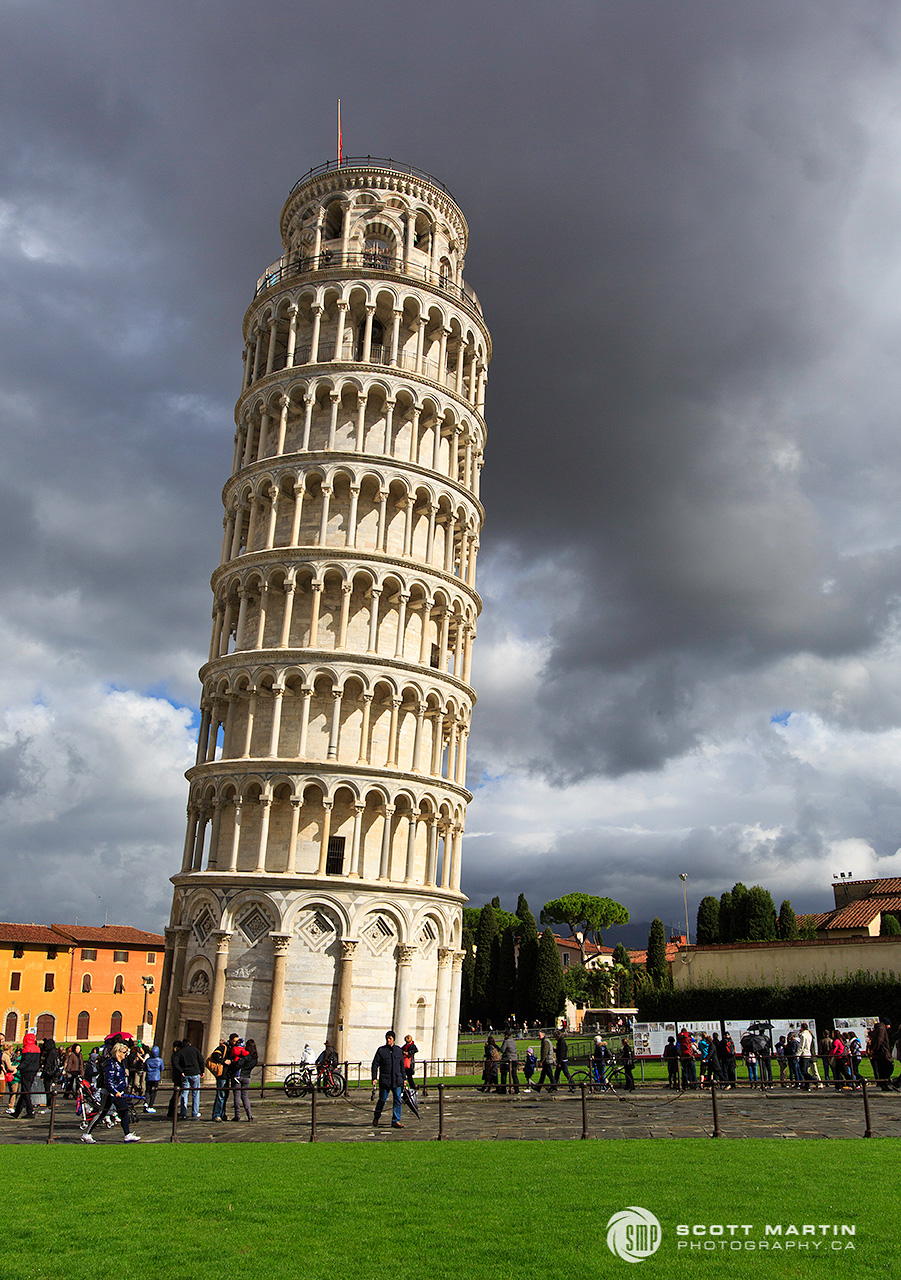
By 1990 the tower’s lean reached 5.5° and the campanile was closed to the public. Steel guy wires were attached to the third level, the seven bells were removed from the bell chamber and nearby apartment buildings were evacuated due to fear of spontaneous toppling of the tower. Between 1990-2001 the tower was straightened and stabilized. This was accomplished by removing 1350 cubic feet (77 tons) of earth from below the high side of the foundation. This restored the lean of the tower to about 3.9° which it was in the late nineteenth century. The decision was made not to place the tower in a vertical orientation largely due to tourism considerations. Its present lean means that the centre point at the top of the tower is 12’10” from the centre point at the base.
Although this next image has not been manipulated, it was taken at a focal length of 16mm on a full frame camera and the native optics of the lens creates an exaggerated perspective of the tower.
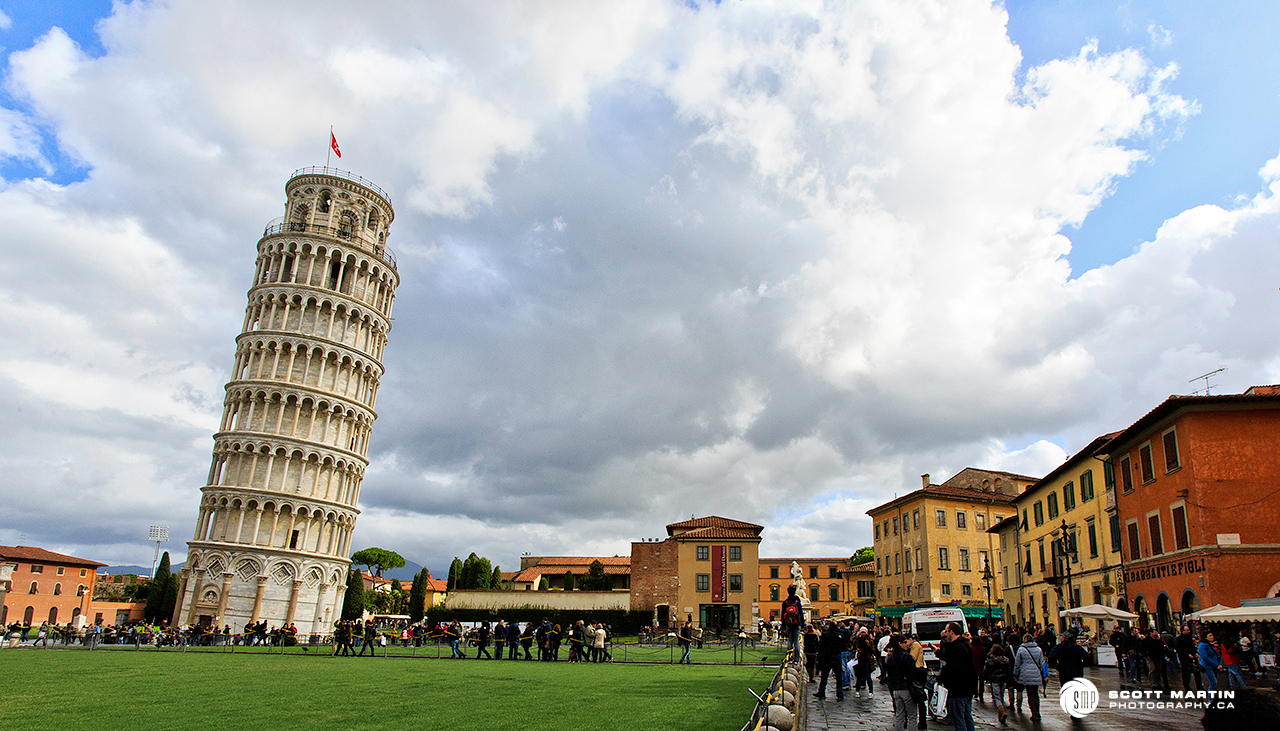
The Pisa Cathedral is an impressive structure in its own right, designed in the shape of a latin cross and constructed of white & grey marble. The cathedral began construction in 1063 and was completed in 1092.
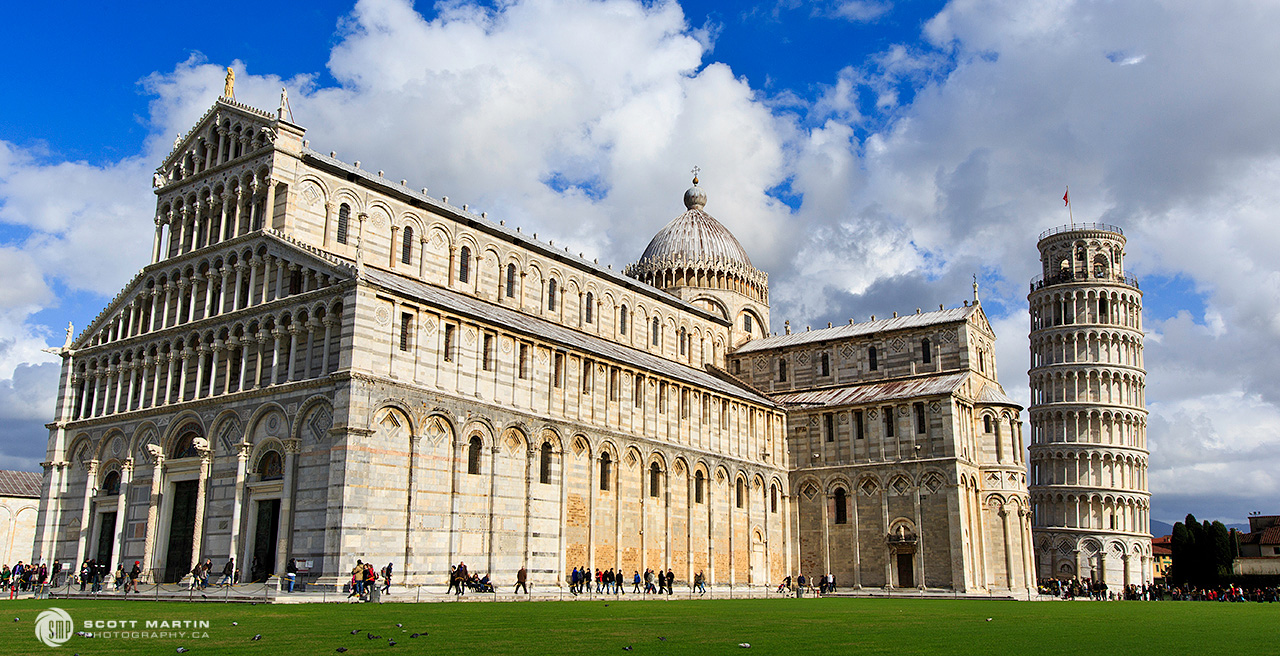
It’s hard to believe when walking through the campus that these buildings are almost one thousand years old.
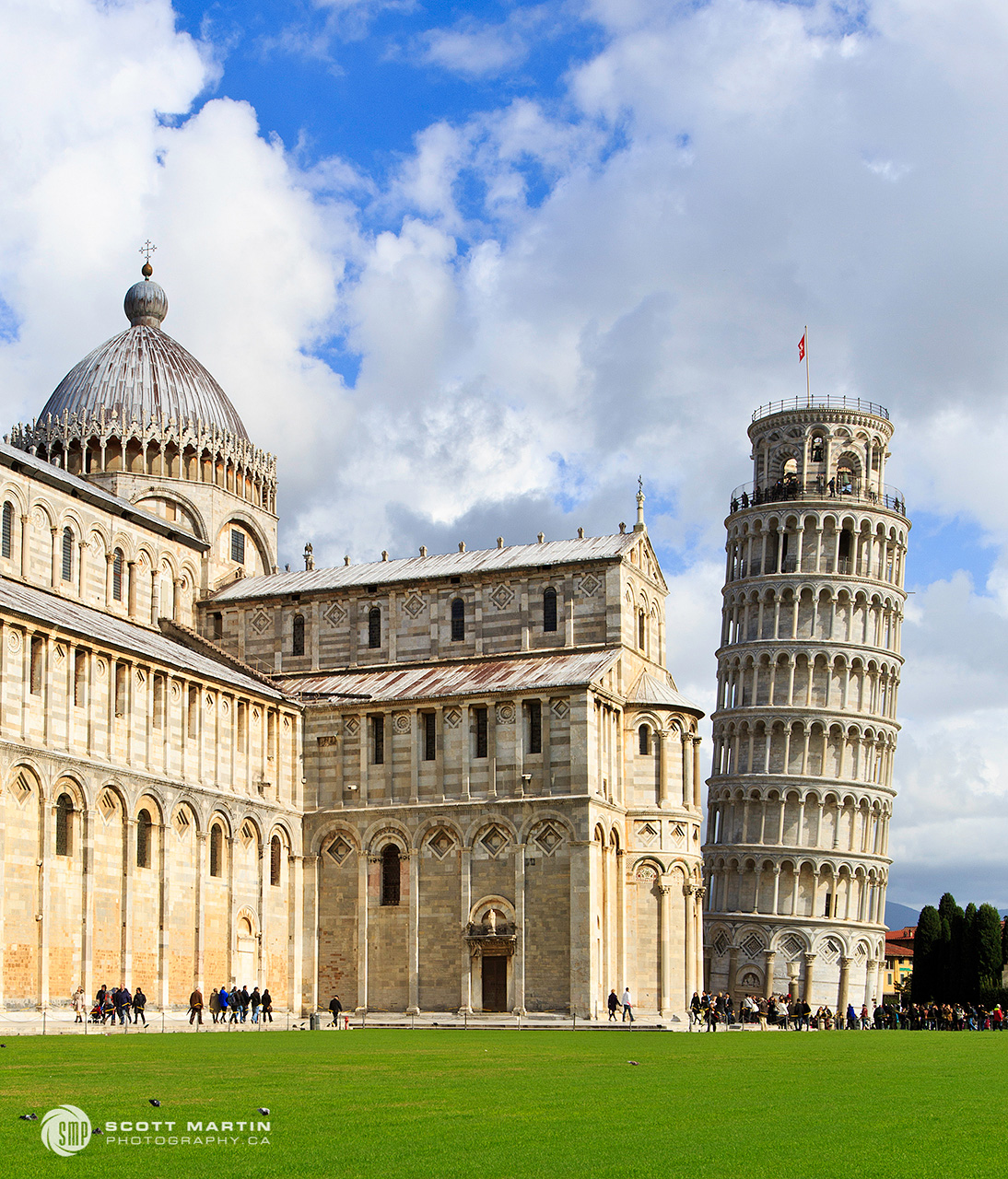
The third major building on the cathedral grounds is the baptistery. It was the second structure chronologically, with construction starting in 1152 and completed in 1363, two hundred and eleven years later. The Pisa Baptistery is the largest in Italy and like the adjacent structures is constructed of marble. The interesting thing to note when looking at the baptistery is the different architectural styles of the building, presumably a result of the 200+ years it took to build. The base of the building is in Roman styling with rounded arches above the columns while the upper sections of the building are of gothic styling with pointed arches atop the columns.
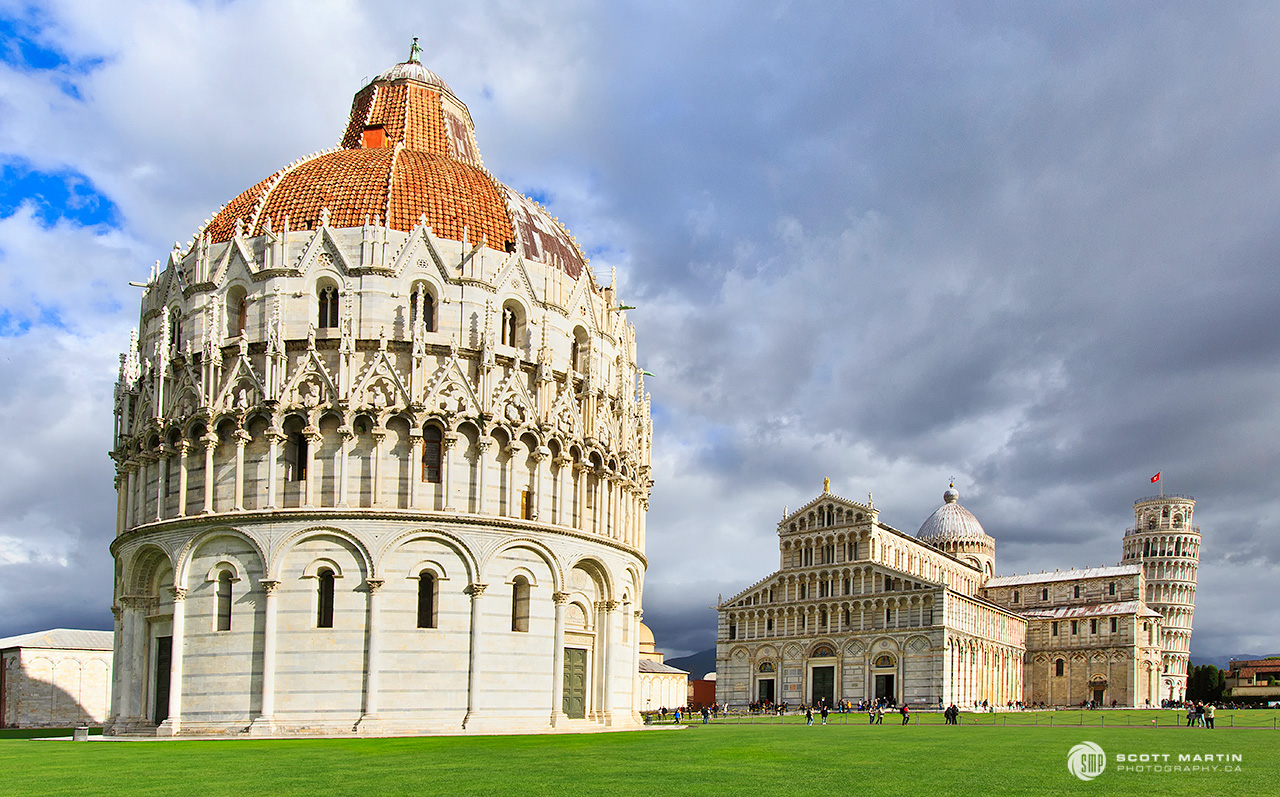
The baptistery also has a relatively small foundation and shares the sandy earth of the cathedral & bell tower so it also leans, however an almost imperceptible 0.6° towards the cathedral.
Although we only spent a few hours visiting Pisa, it was a great time and a pleasure to see and learn a little about its iconic landmark.
Deb & I couldn’t help taking some classic tourist shots of the tower while we were there. As a photographer, one always looks for that ‘original shot’, especially of the well known landmarks…..I’m quite certain these next two images don’t qualify 🙂
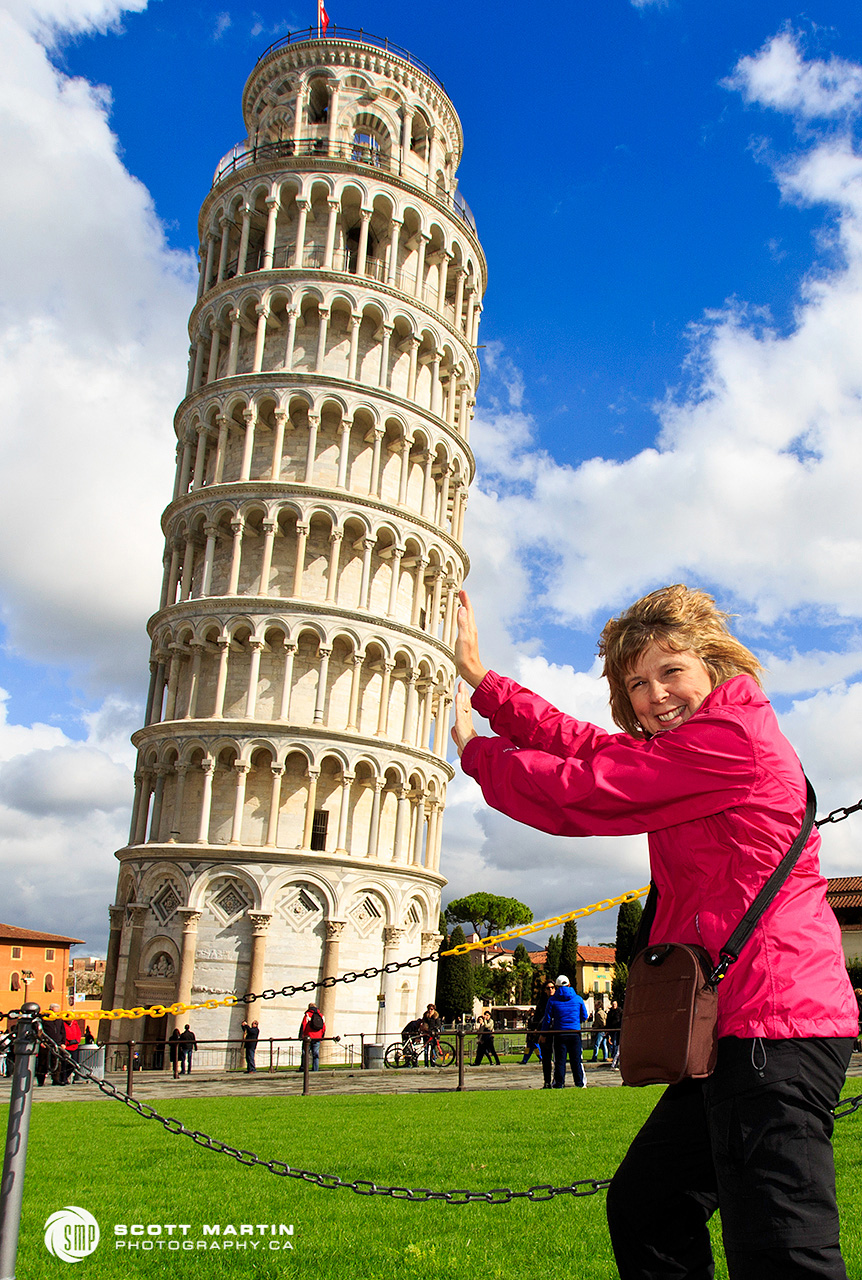
.

Other images from Pisa can be seen by clicking on this link plus there are a number of other galleries from various locations in Europe that are also posted on the website.
All of the images in this post were taken using a Canon 5D Mk III and EF 16-35 f2.8 wide angle zoom lens.
Thanks for taking the time to read through this post and I trust you’ve enjoyed the Leaning Tower of Pisa. As always you comments and questions are much appreciated.
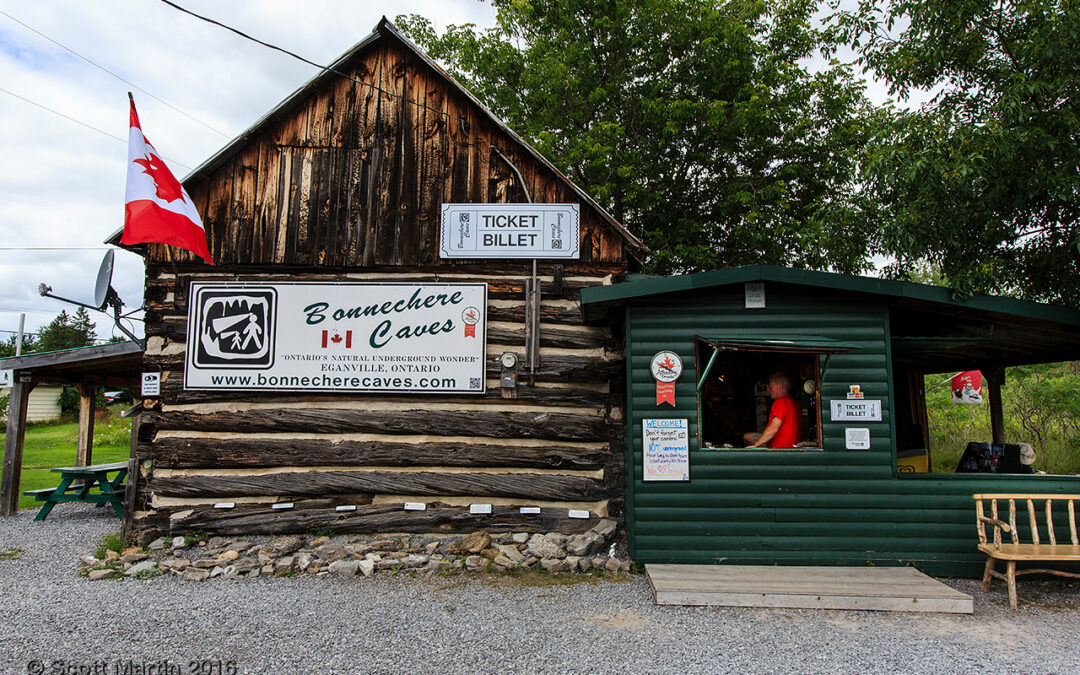
During summer vacation we spent a day with our great friends, Tim & Cindy, touring around Renfrew county. Both Tim and I were born in Renfrew County so it was great to spend a day on the old stomping grounds. Renfrew County is Ontario’s largest county so there is much to see and plenty to do, certainly more than what can be packed into one day.
Food stops were a delight with ice cream at Brumm’s Dairy in Pembroke then off to Eganville for fries at the Jolly Fryer and latte’s and espresso at Engine House Coffee. How can you beat fries, ice cream and coffee?
From a photographic perspective the highlight of the day was capturing the Bonnechere Caves and the Bonnechere River which rages through the area providing incredible rapids and waterfalls to photograph.
Although the Bonnechere Caves have been there a lot longer, they have been open to the public since 1955 when Tom and Ruth Woodward purchased the land and explored and developed them for public access. Check out their website via this link if you want to learn more about the caves and their history.
The atmosphere at the caves is laid back and welcoming. Tours leave from the parking lot every half hour and they operate daily from Victoria Day to Thanksgiving. Our tour guide was excellent with a perfect blend of history, education, story telling and lots of humour. It was excellent and brought back fond memories from when I last visited the caves 45 years ago.
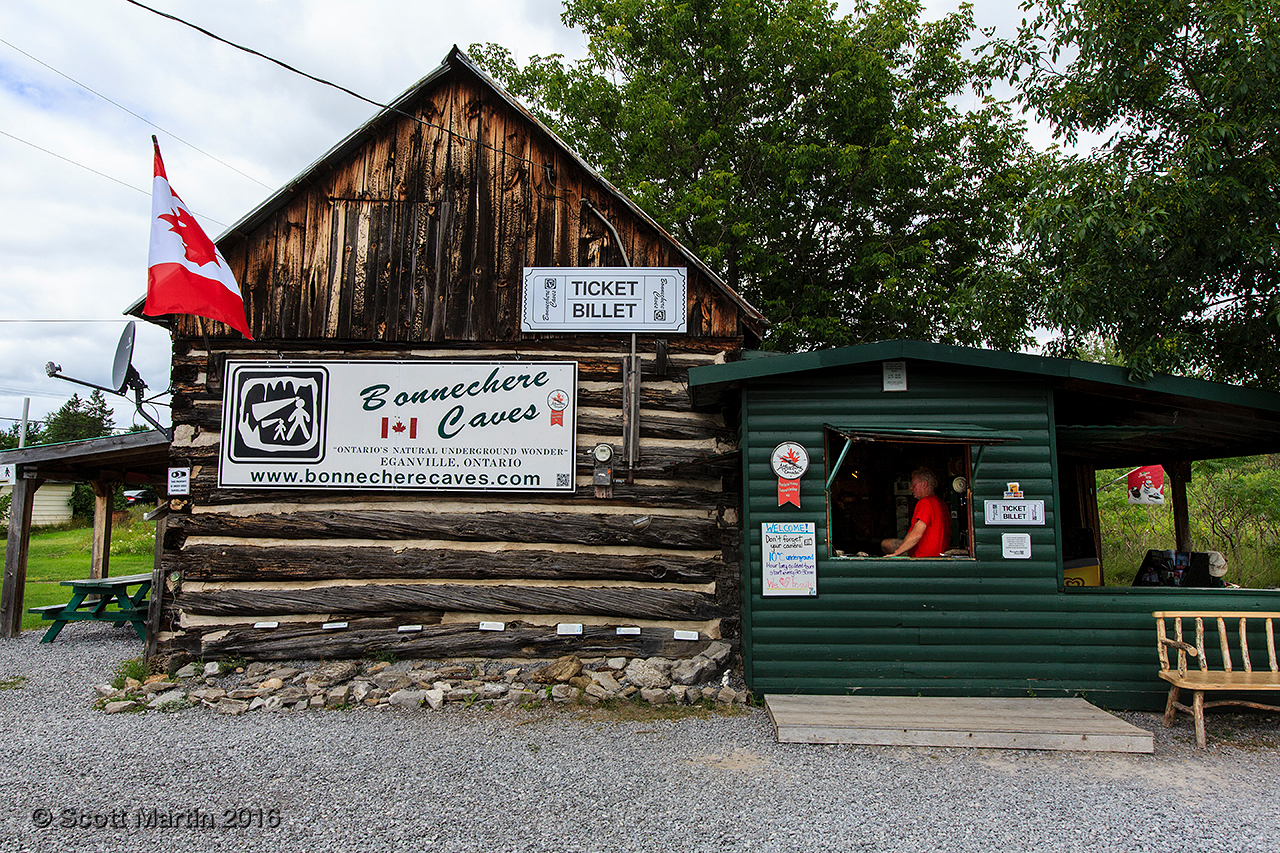
Our group being introduced to samples of the many fossils that are found in the area.
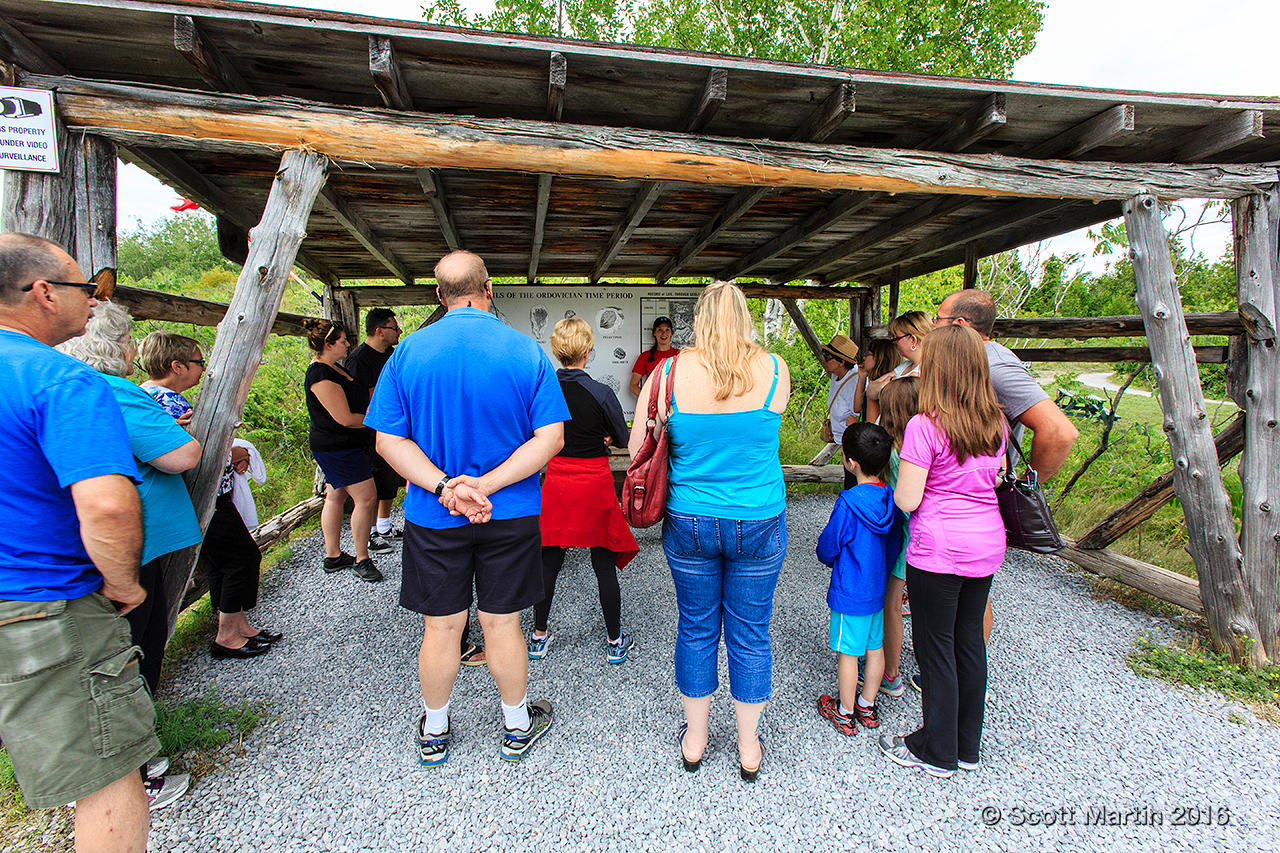
This is the stalactite formation known as the beehive, for obvious reasons!
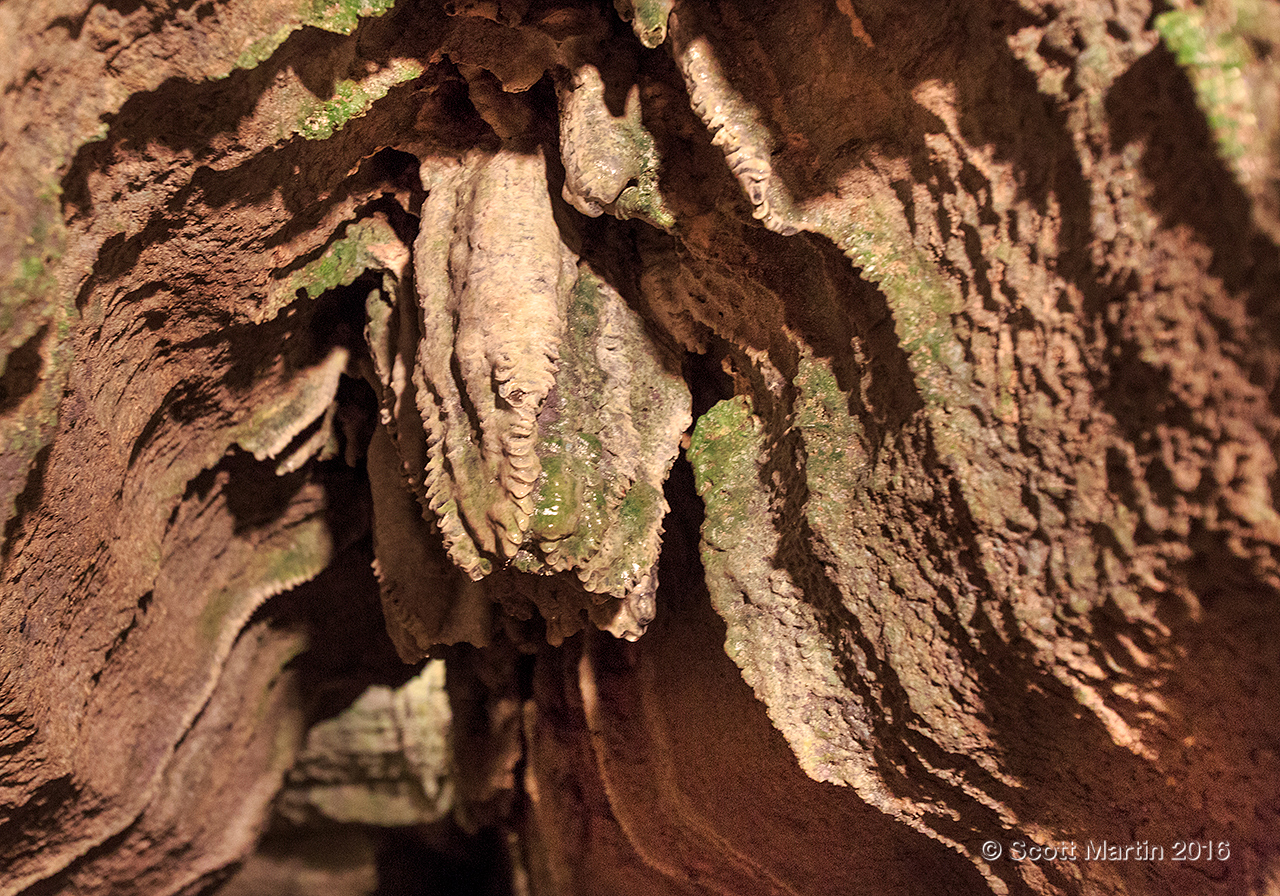
These next images show various views of the caves as we proceeded through on our tour. I was thankful they allowed me to take a tripod and take as many images as desired. Most of the pictures in the caves were taken at a fairly high ISO with shutter speeds ranging from three to five seconds.
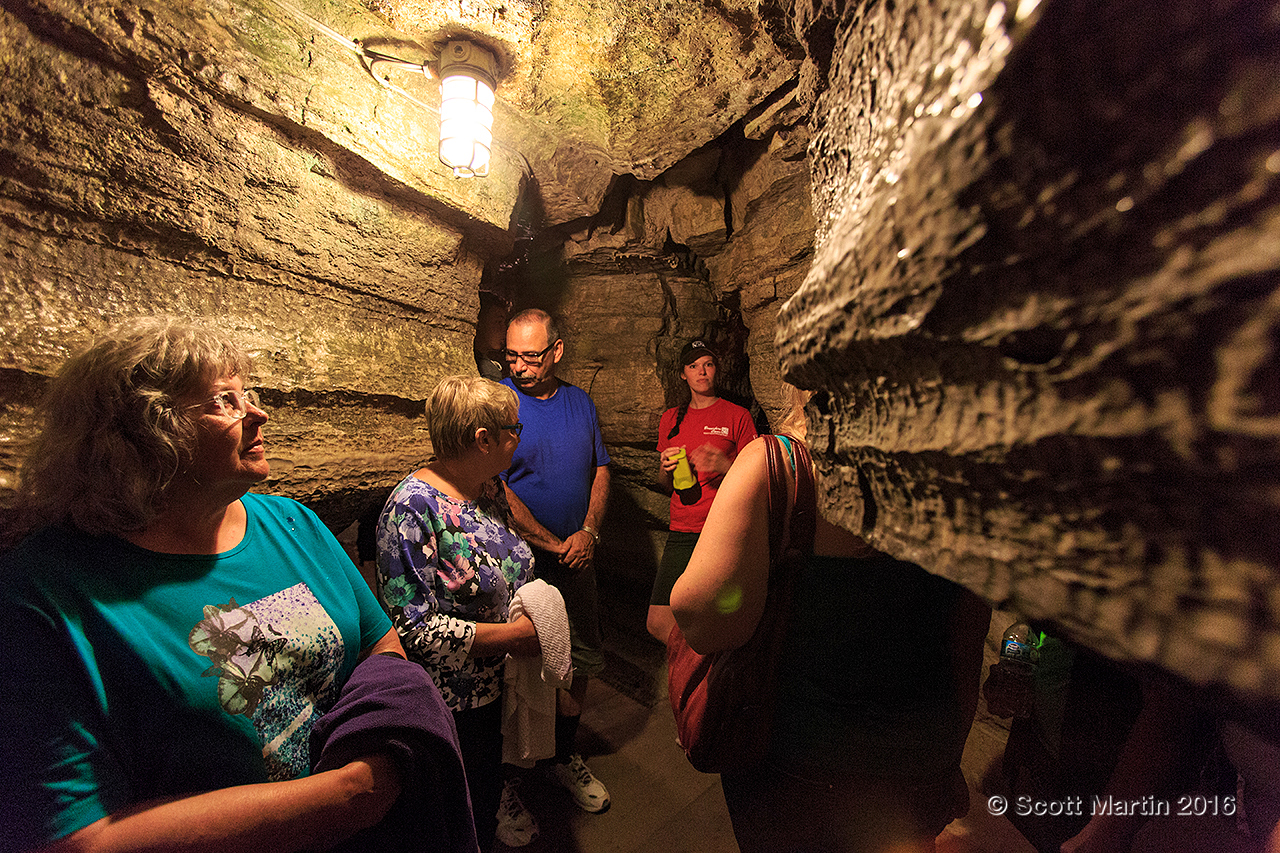
.
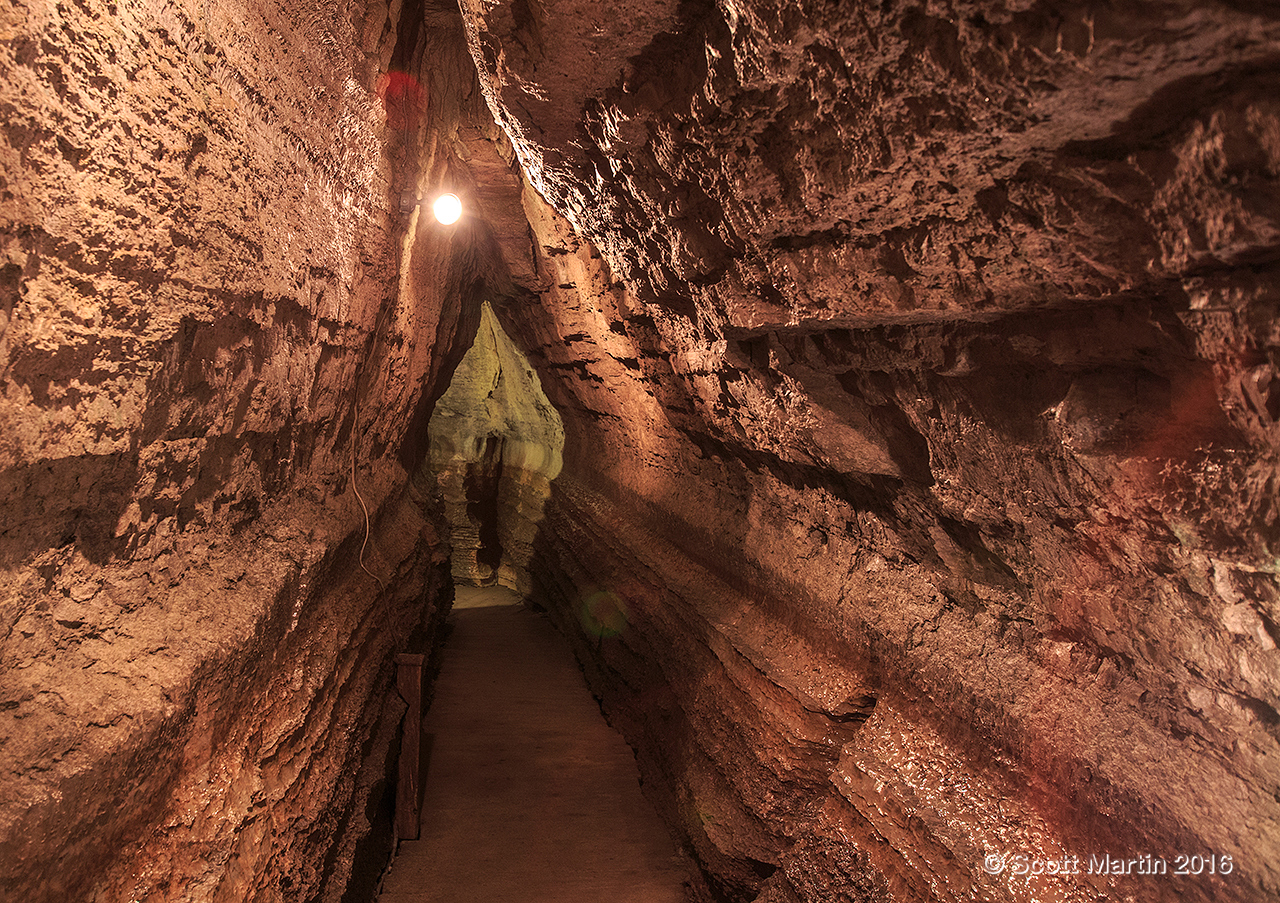
.
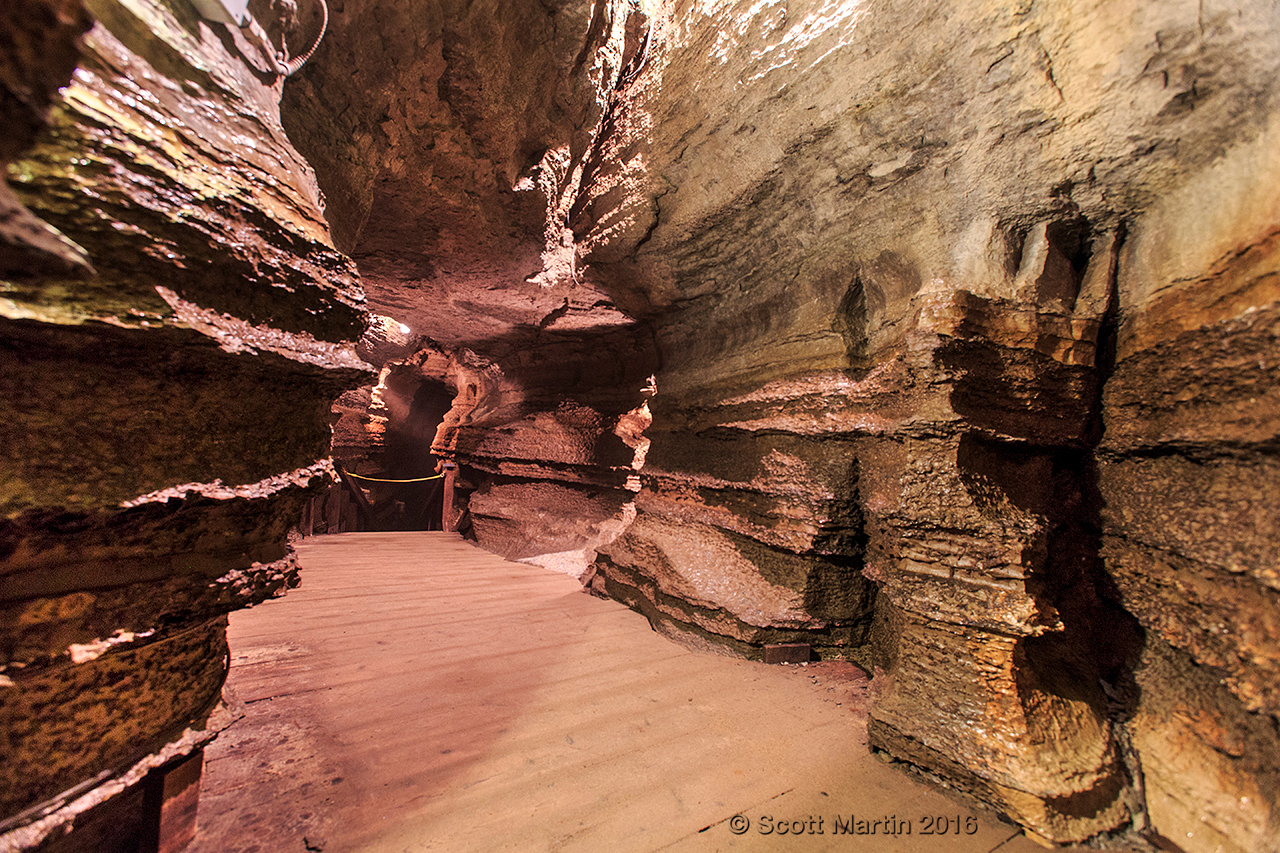
.
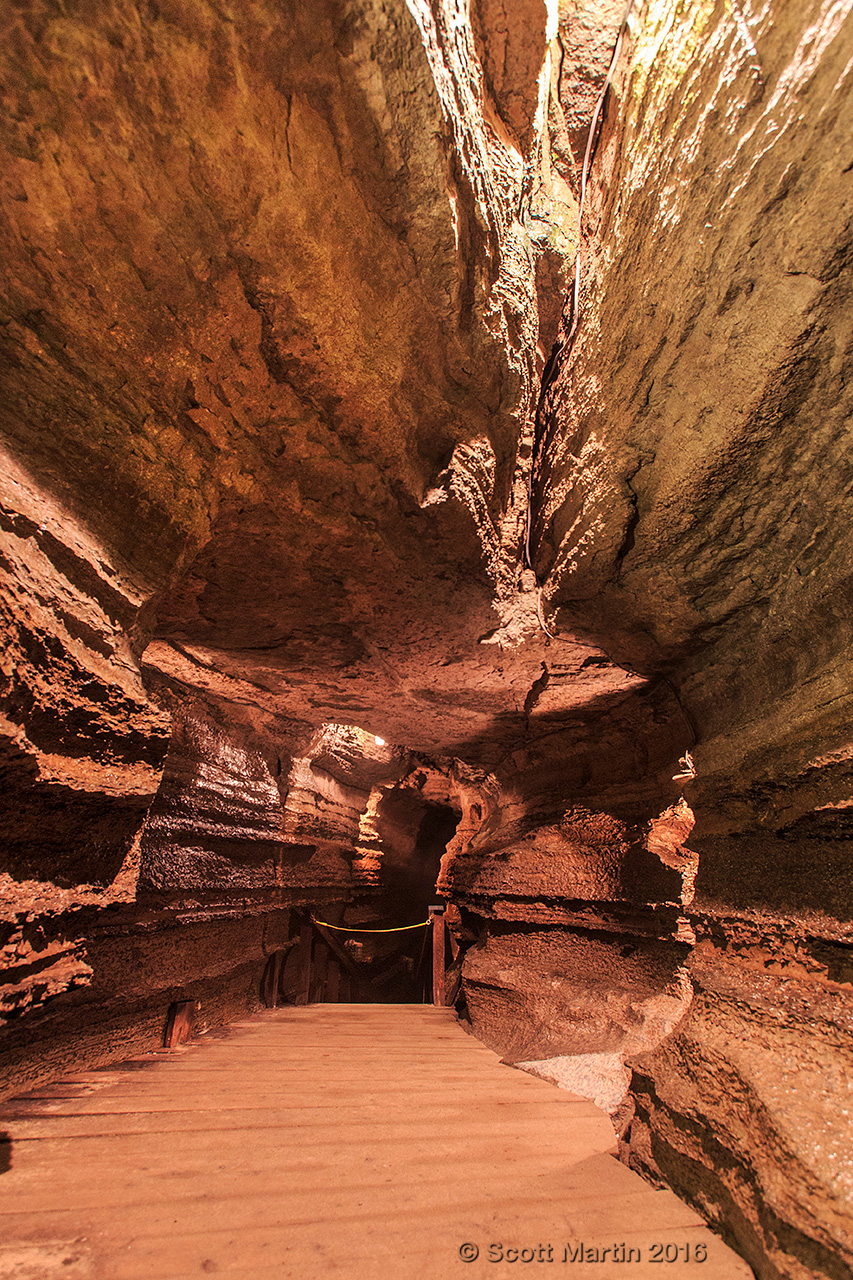
.
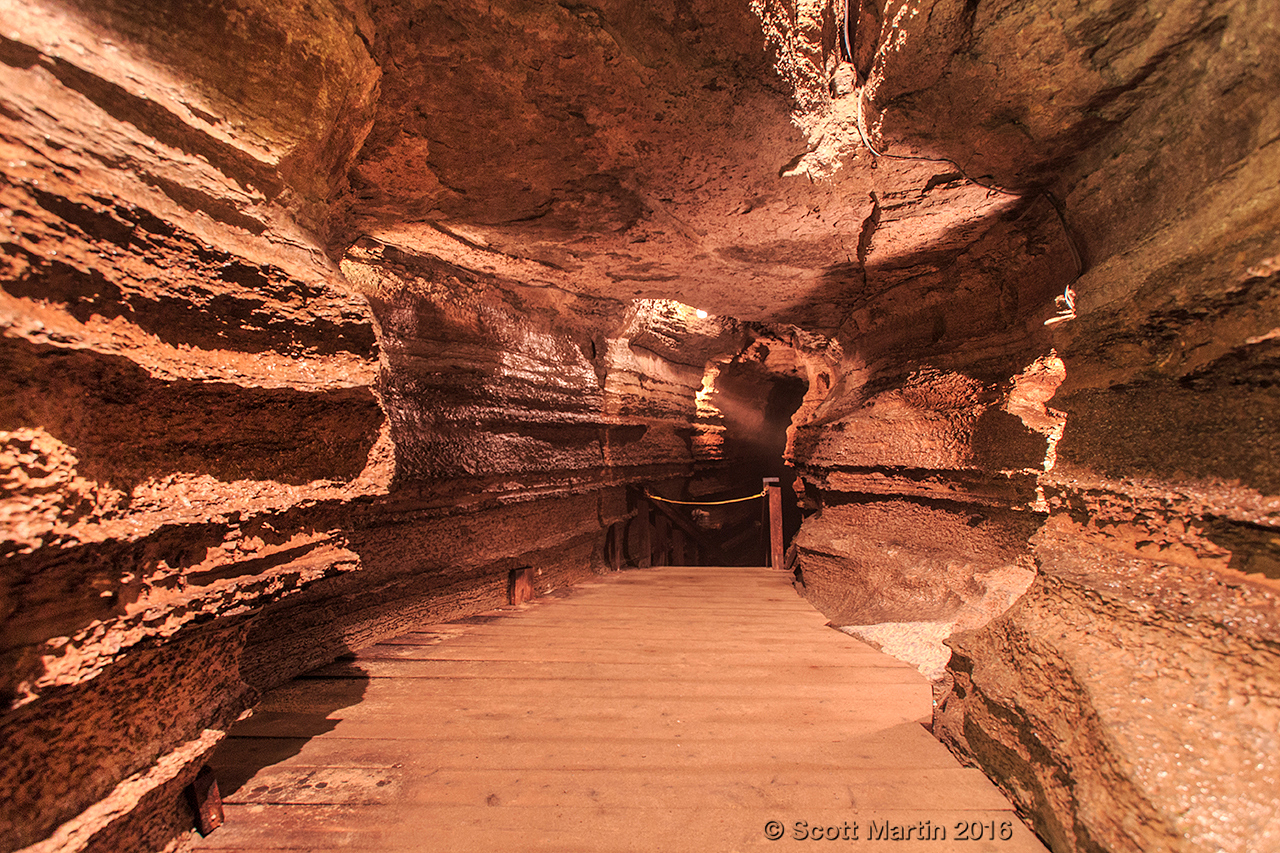
.
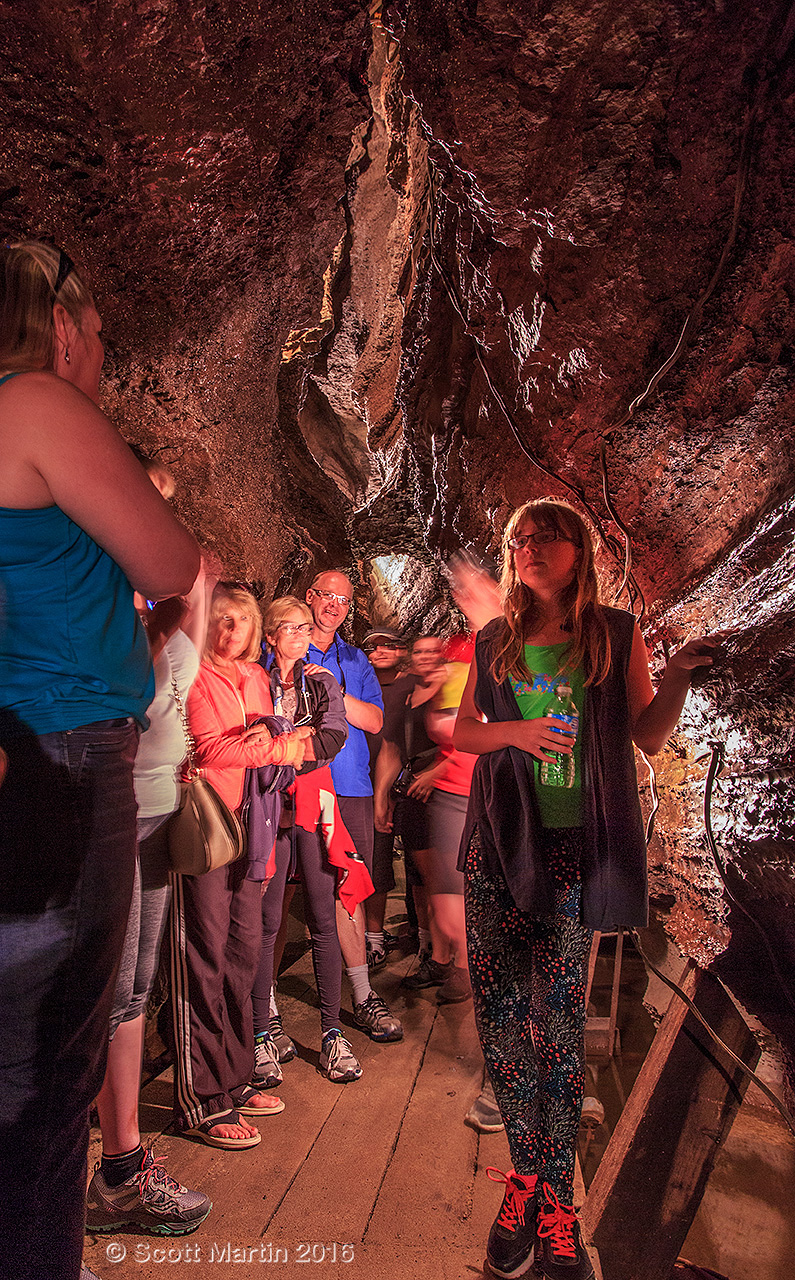
This last shot of the caves shows an area that suffered a collapse….fortunately this was at the end of the tour. As an introduction it would have been unnerving 🙂
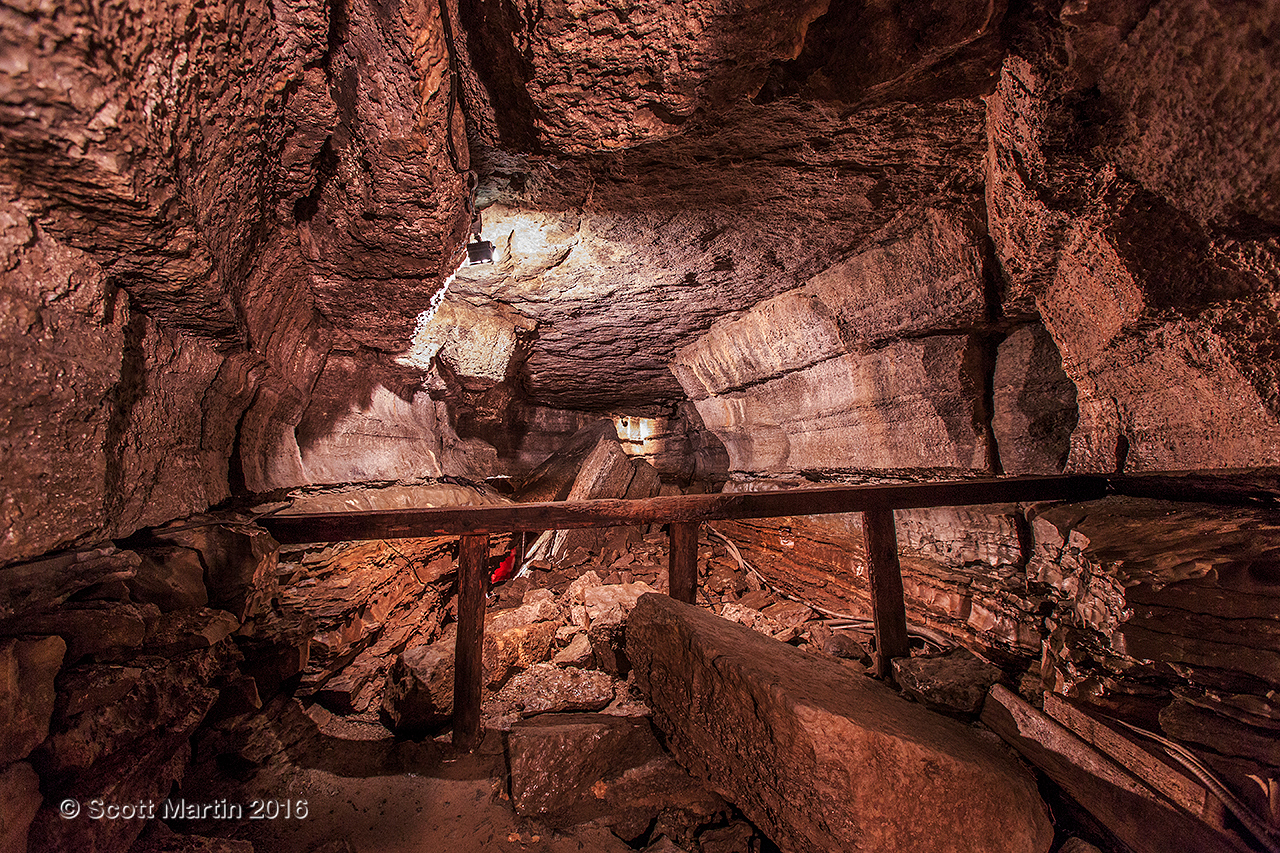
After touring the caves we crossed the bridge to the opposite side of the Bonnechere River and made the short hike to the river’s edge and rushing waters that awaited.
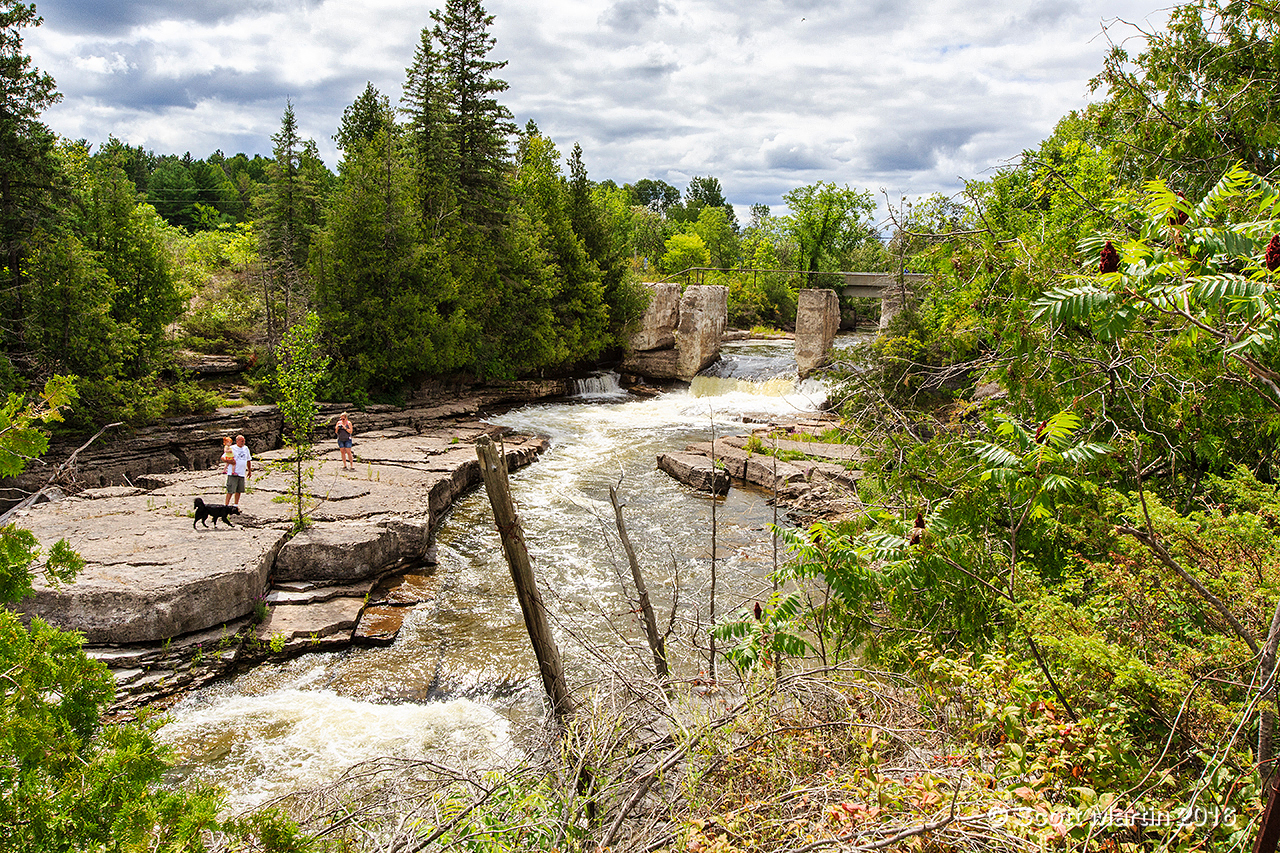
Even the hike to the river was enjoyable with many interesting formations in the relatively soft limestone formed by the Bonnechere River when water levels were much higher.
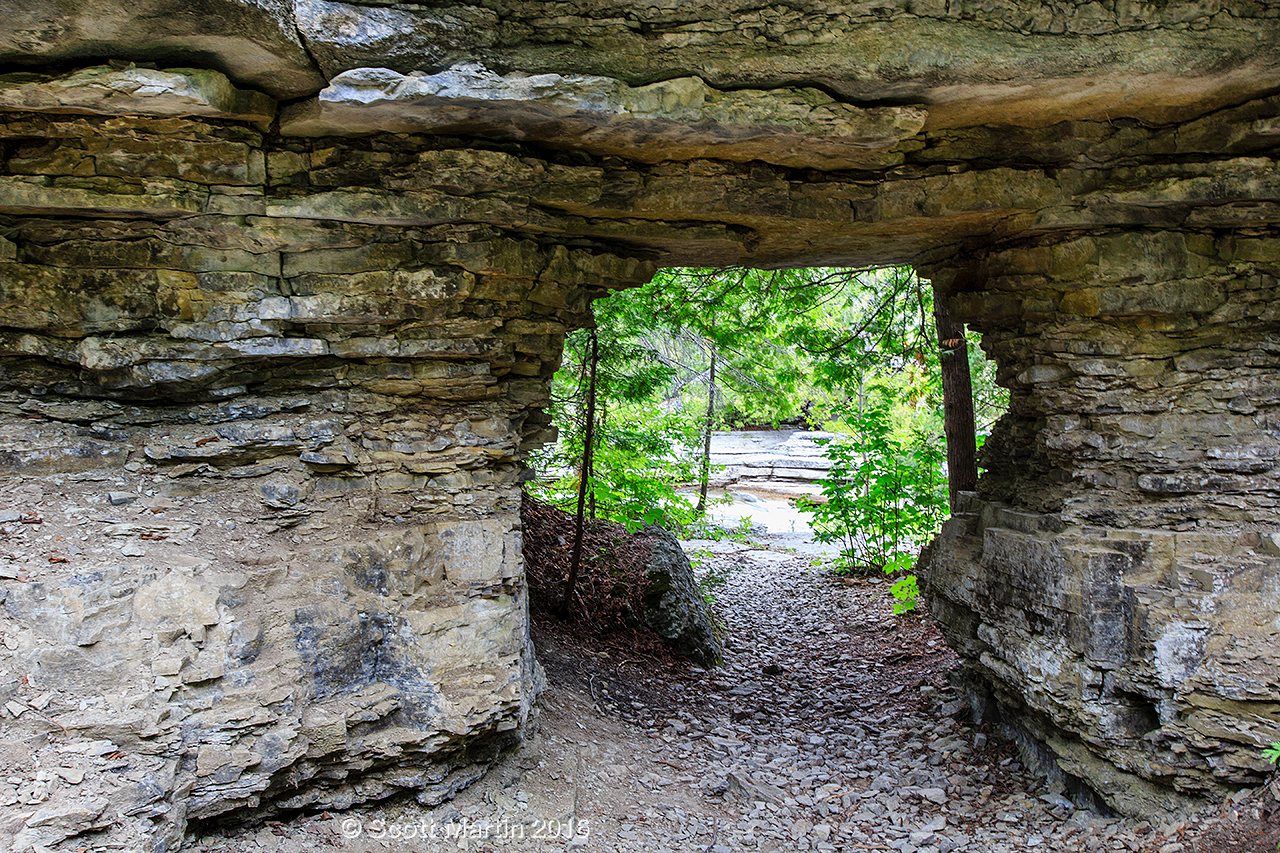
When photographing rivers, rapids and waterfalls, shutter speed is the factor that has the most influence on the image. It is shutter speed that will determine whether the water movement is stopped with perfect focus, freezing the action of the water perfectly, or creates an image in which the water appears etherial with smooth white waters flowing over the rocks beneath conveying the motion and power of the flowing water.
As a matter of practice, first determine the composition you desire and position the tripod accordingly; secondly determine the aperture required to create the necessary depth of field (generally a smaller aperture is preferred in order to keep all elements in focus – anywhere from f/11 to f/22 is usually fine, especially when using wide angle lenses). Finally choose a shutter speed that creates the amount of motion you wish in the water. This is often a matter of trial and error until the proper exposure time to create the desired effect is achieved.
In this next series of images we will look at the effect shutter speed has on the moving water. Everyone’s favourite image will be different based on their subjective preferences and I’d be interested in knowing your choice. Leave a comment with your preference and we will see if there is a clear winner or whether the variety of choice is large. Remember the shutter speed of your favourite and use that speed as a starting point the next time you are photographing rushing waters.
A. 1/100 second
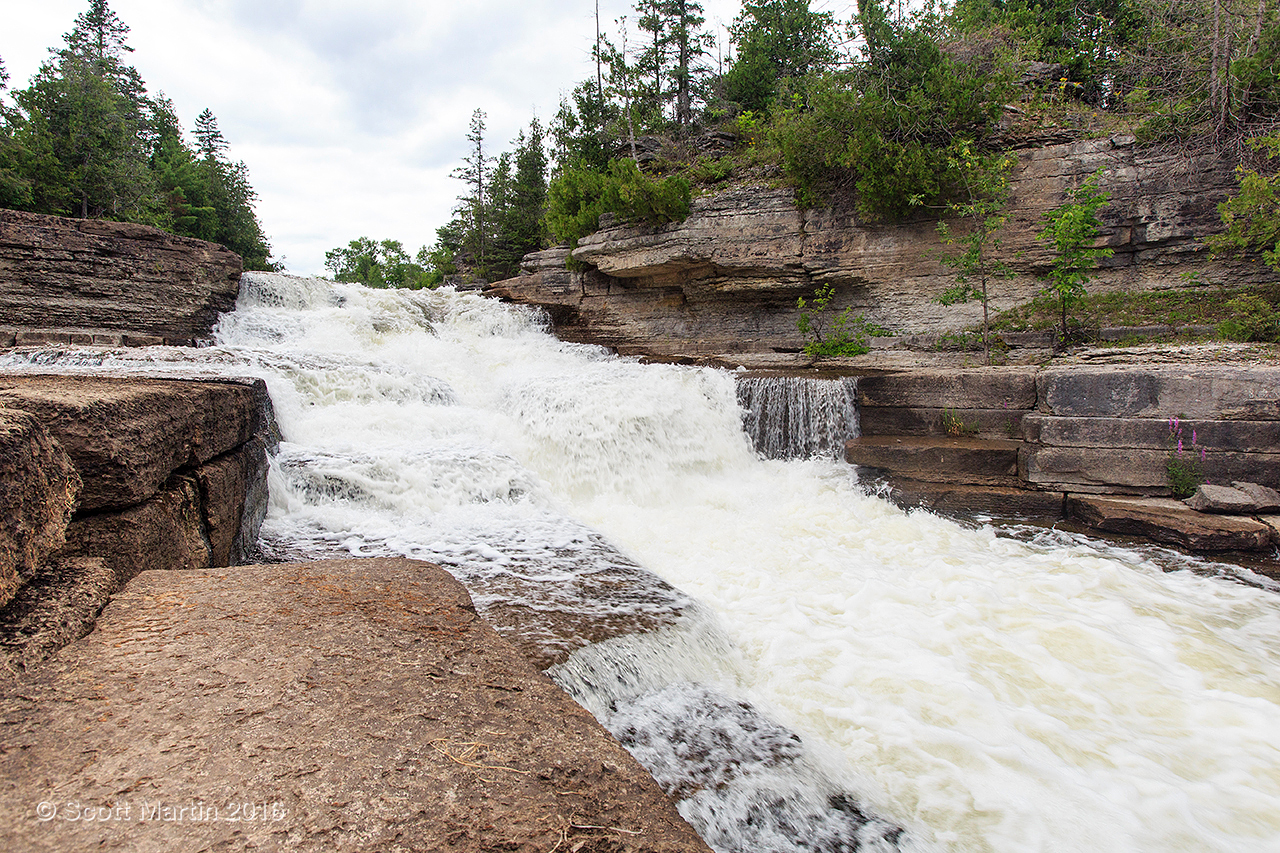
B. 1/2 second
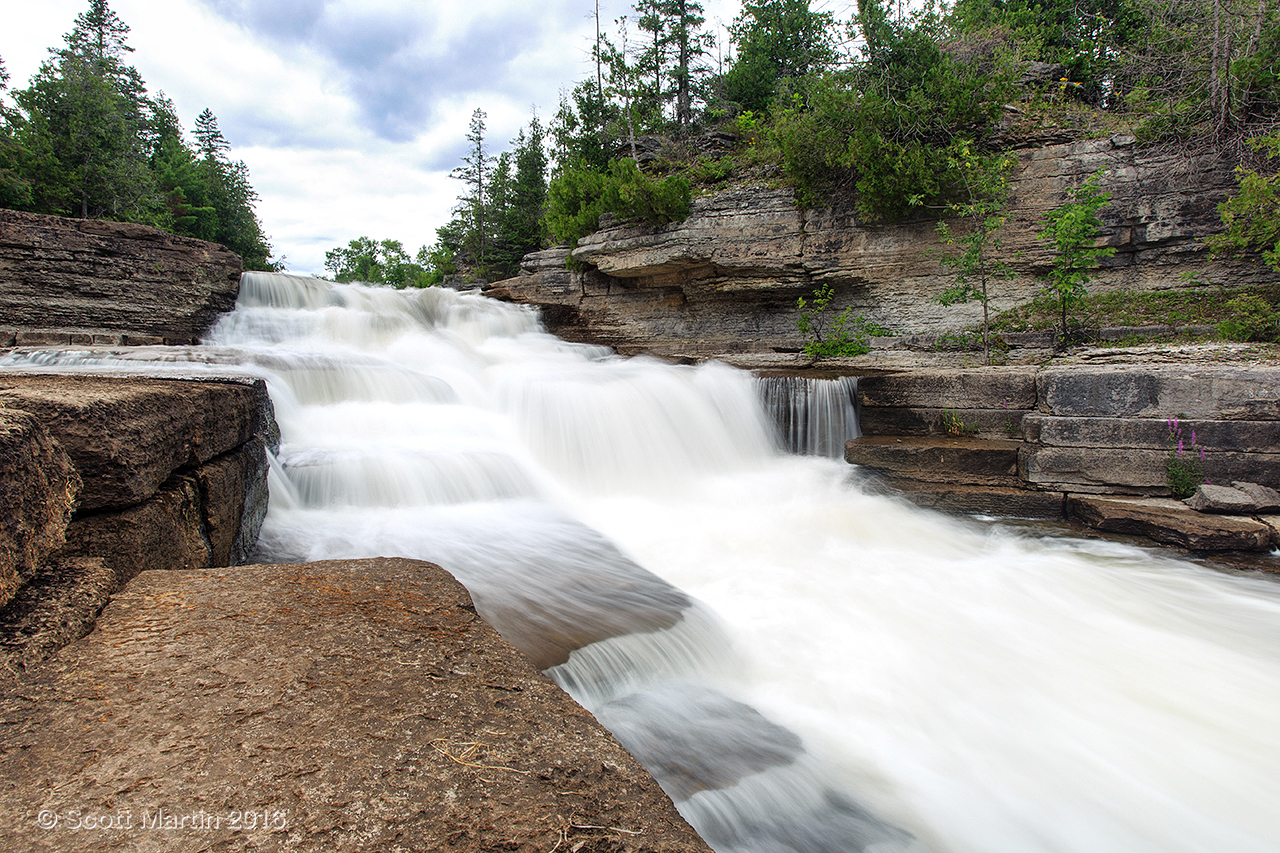
C. 2 seconds
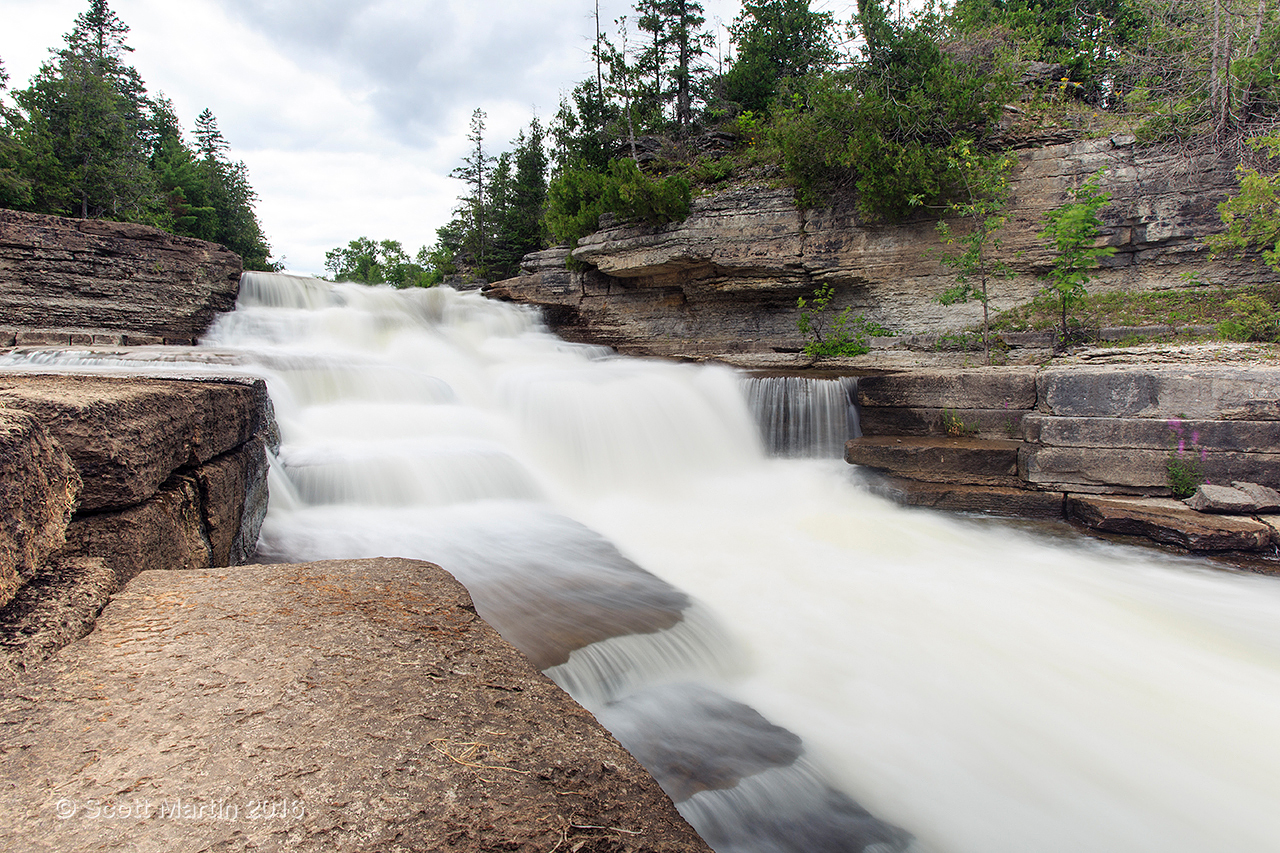
D. 4 seconds
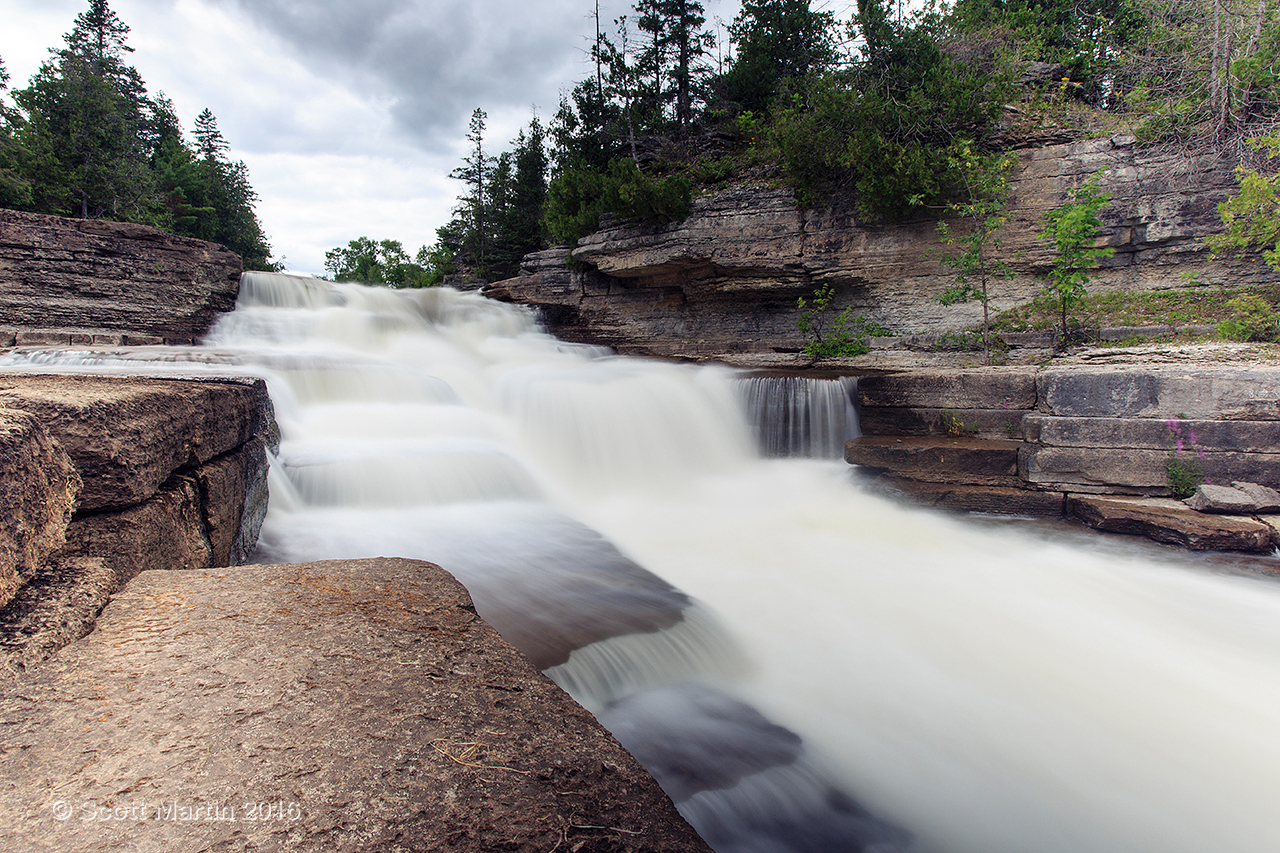
Although there was a cloudy sky when these images were taken, you may be wondering how we were able to achieve such slow shutter speeds. During the daylight even with an aperture of f/22 and an ISO of 50 you can not typically get to exposures of much more than 1/4 to 1/2 second. To achieve slower shutter speeds you require filters for the lens that reduce the light entering the lens. If you have a polarizing filter, you can use that to gain about 1.5 more stops. Otherwise you require Neutral Density filters to further reduce the light reaching the sensor. Neutral density filters come in many forms and are found in every landscape photographer’s tool box. For the pictures in this post I used a Singh-Ray Vari ND filter which is a great filter that allows you to vary the amount of light reduction from 2 to 8 stops which is extremely helpful.
We will close today’s blog with a few more shots of the Bonnechere River. I will include some similar scenes at different shutter speeds for your critique which I always appreciate.
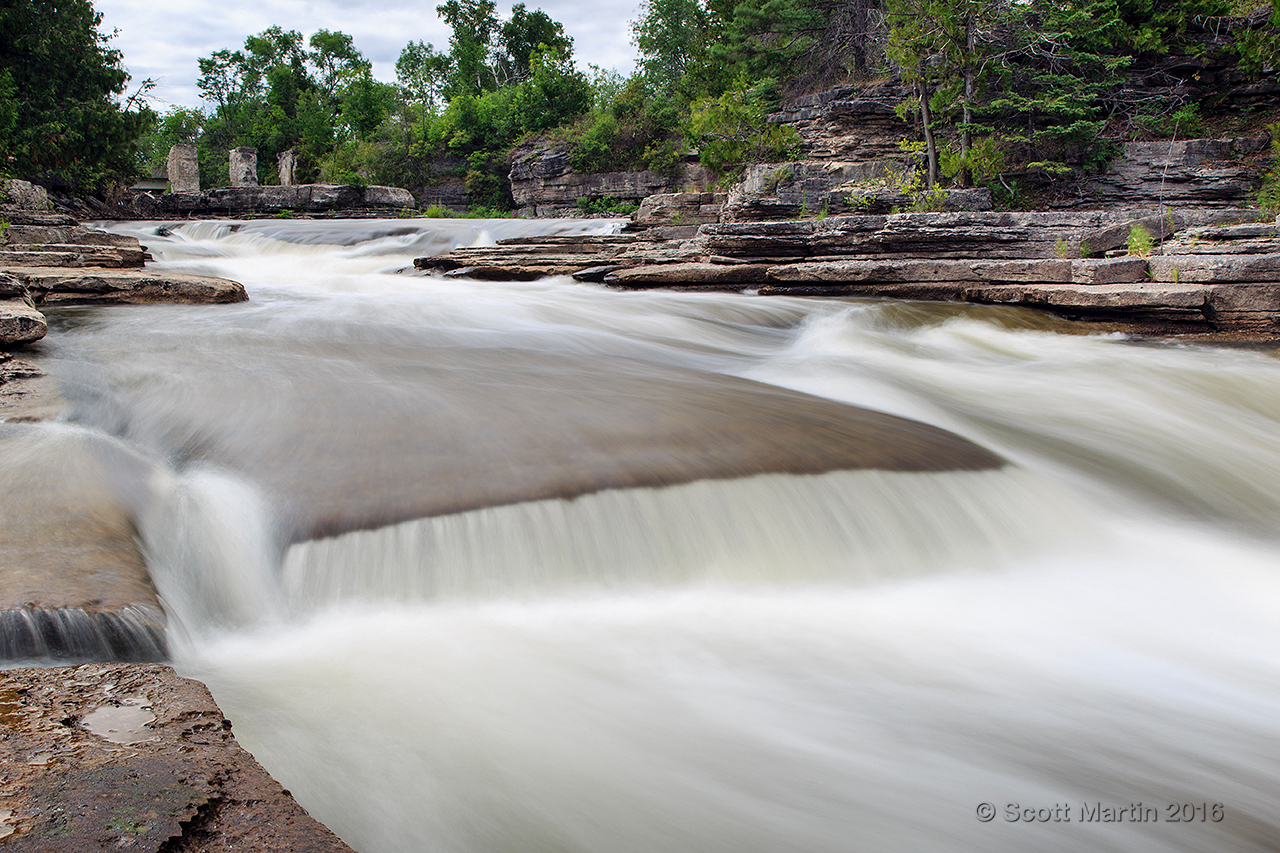
For long exposure shots including people, ask them to hold as still as possible and always use a flash to help freeze any motion (I used a +3 flash exposure compensation for this pic).
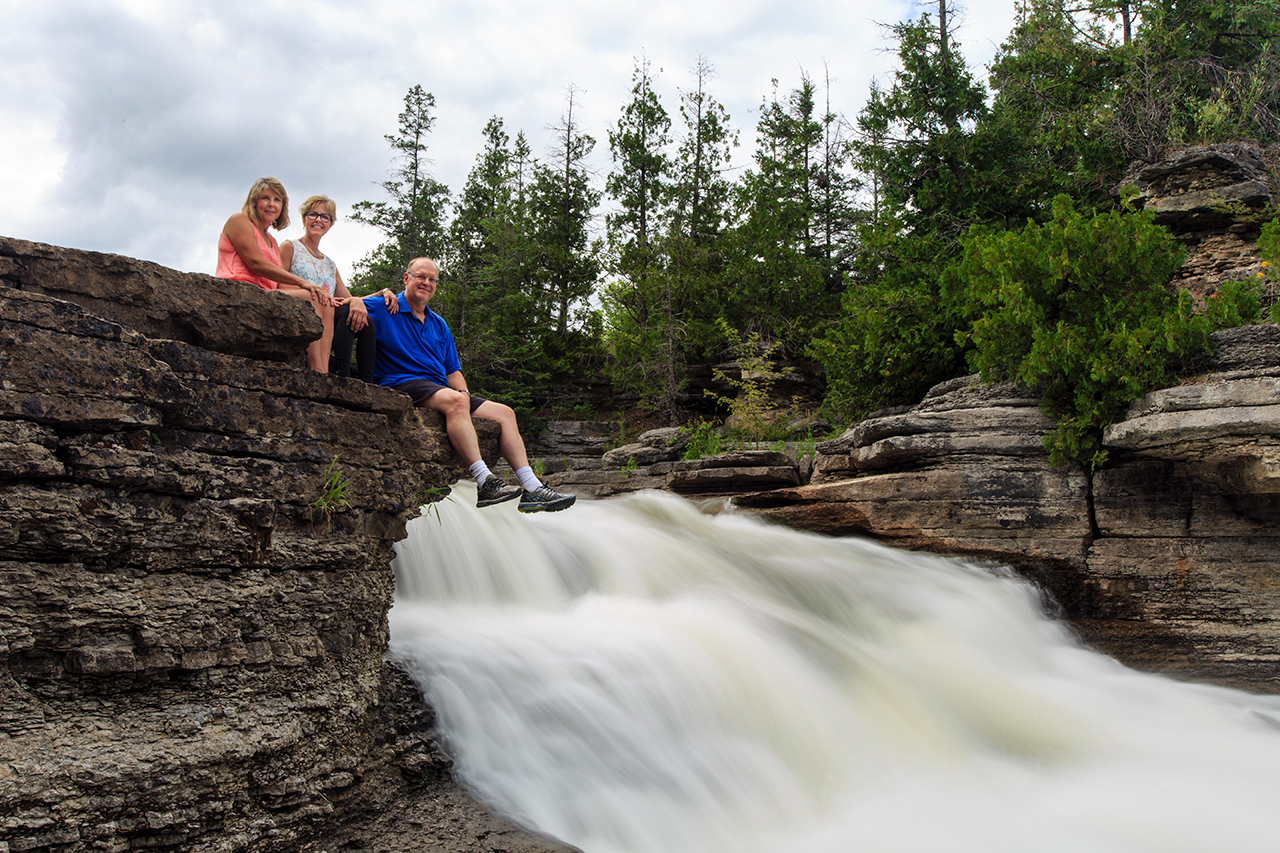
.
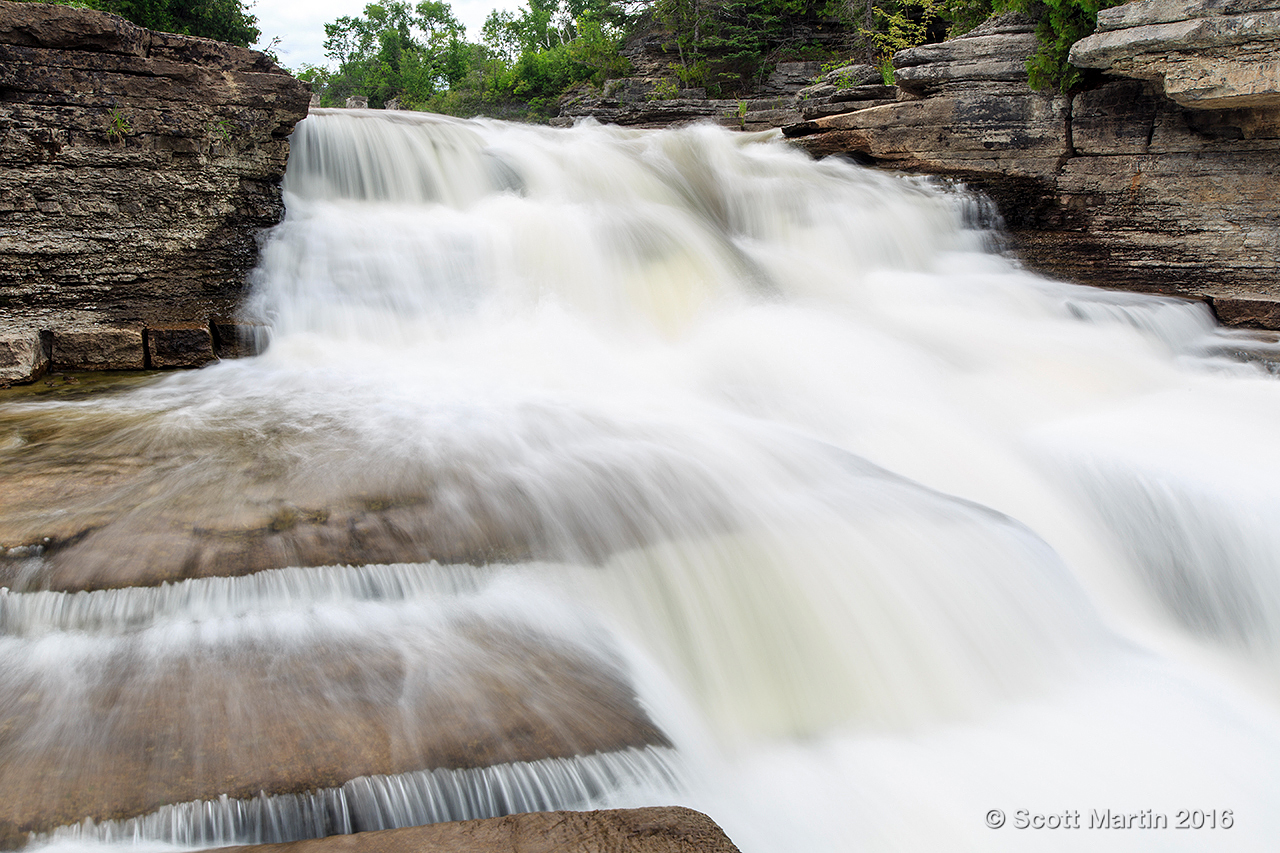
.
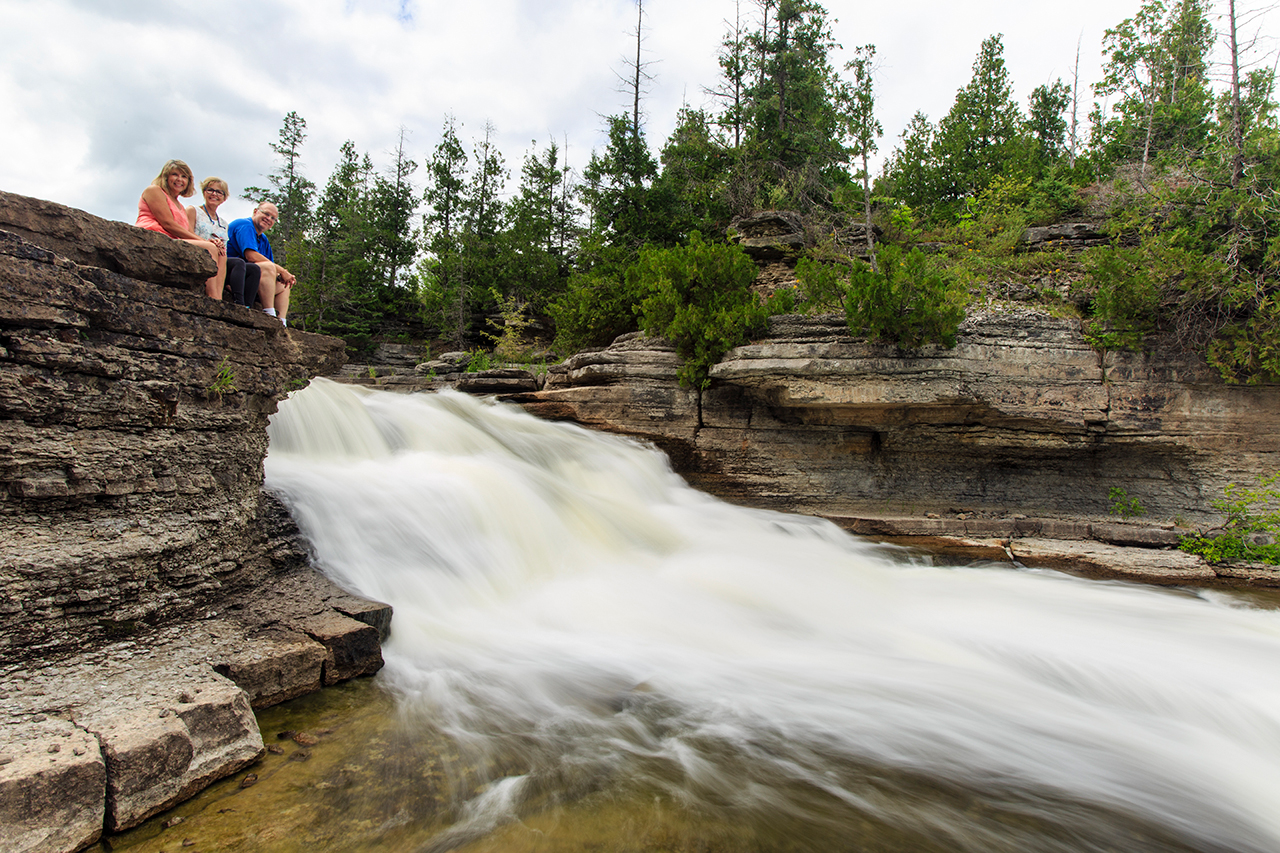
.
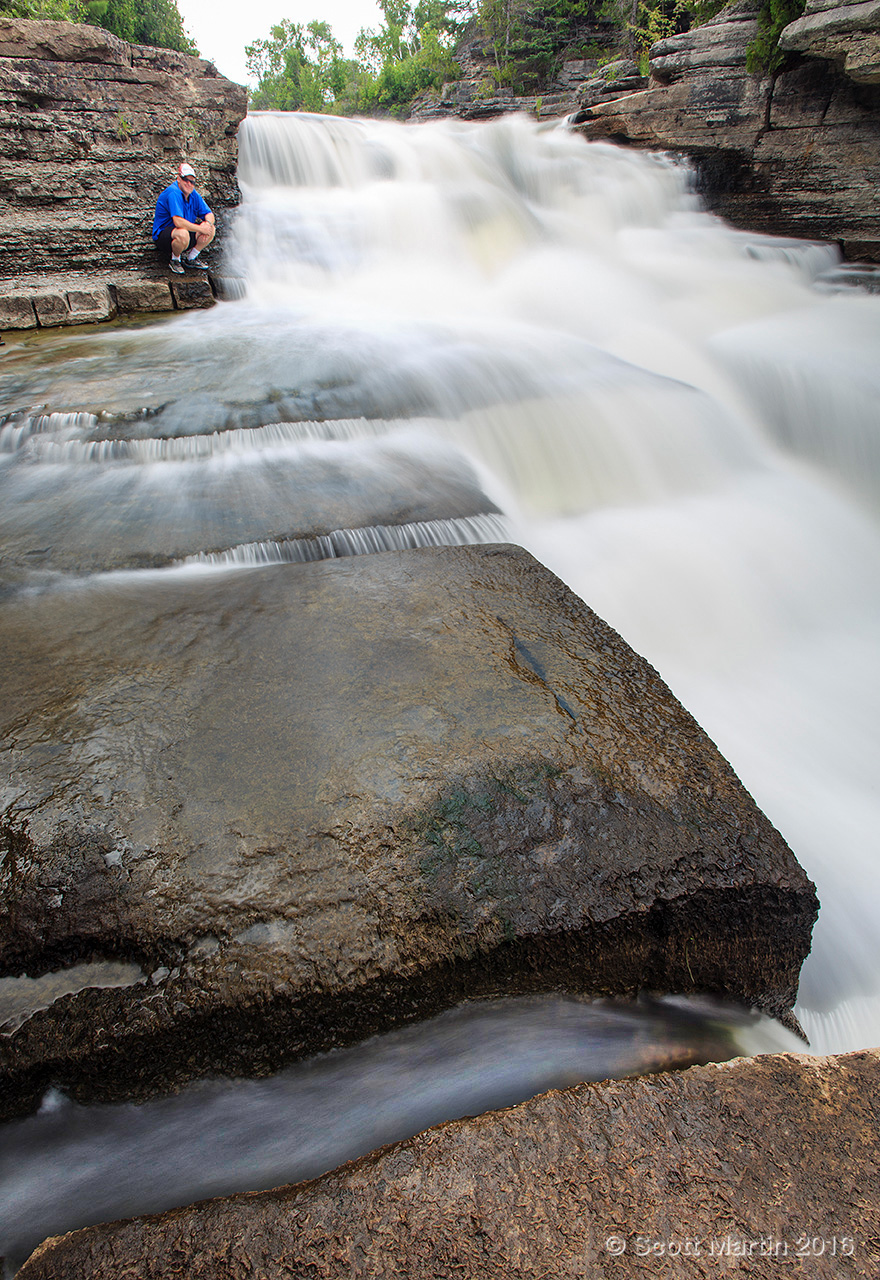
.
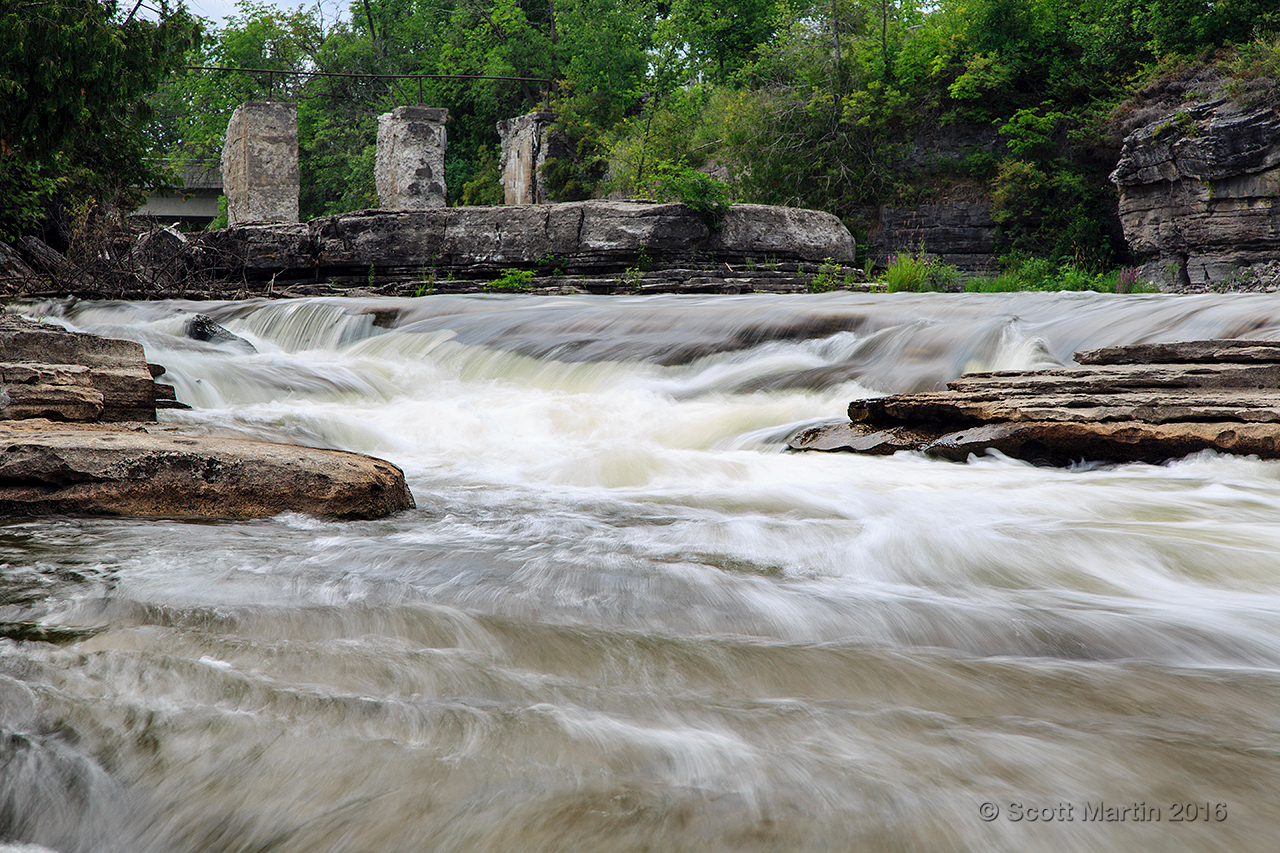
.
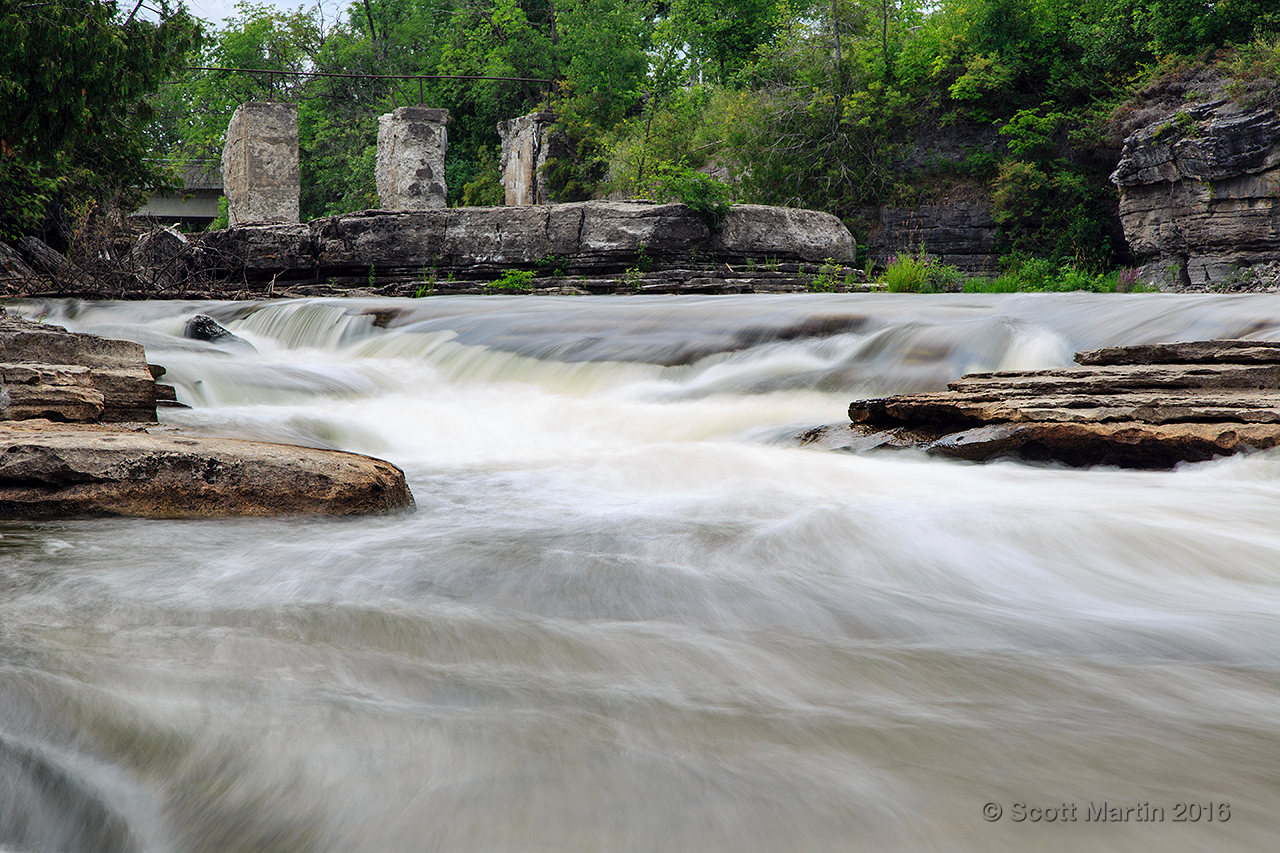
1/3 second
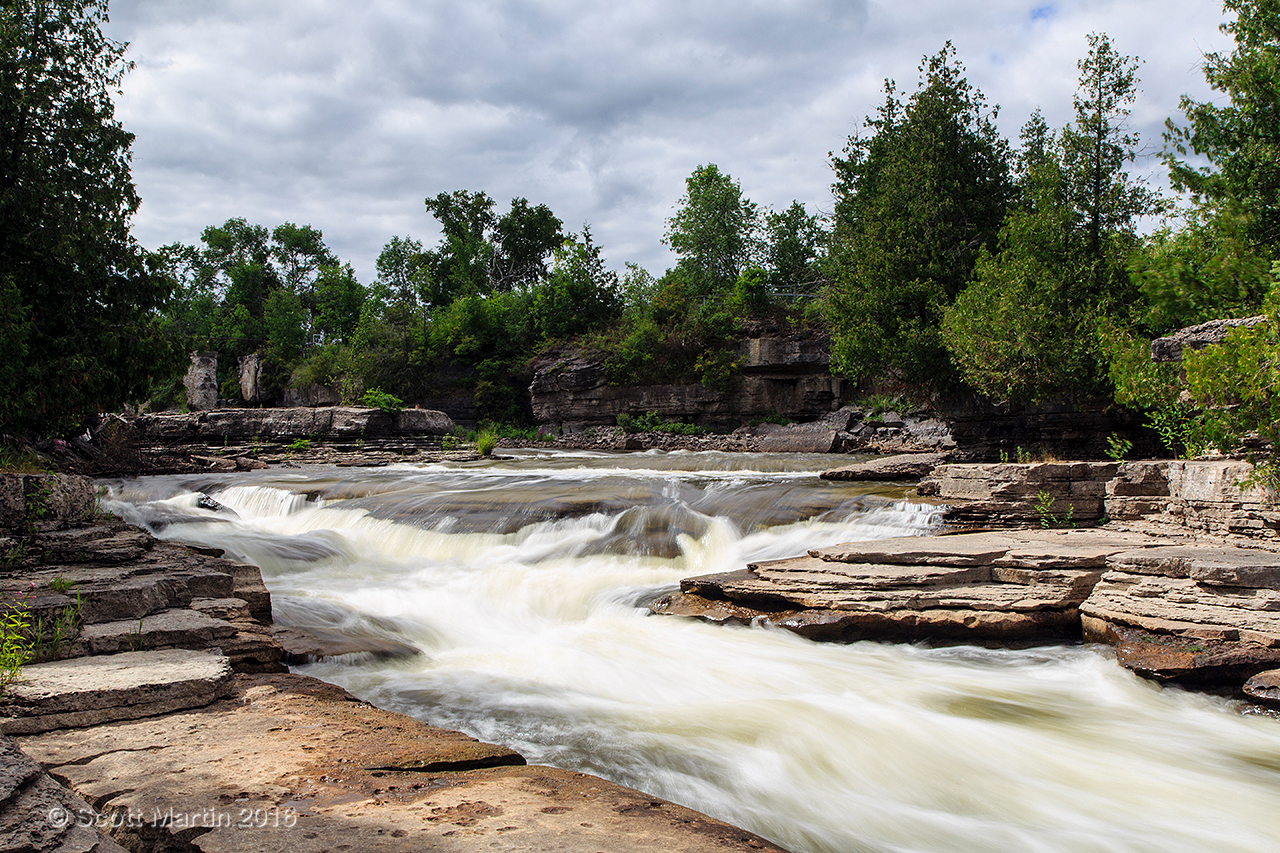
1 second
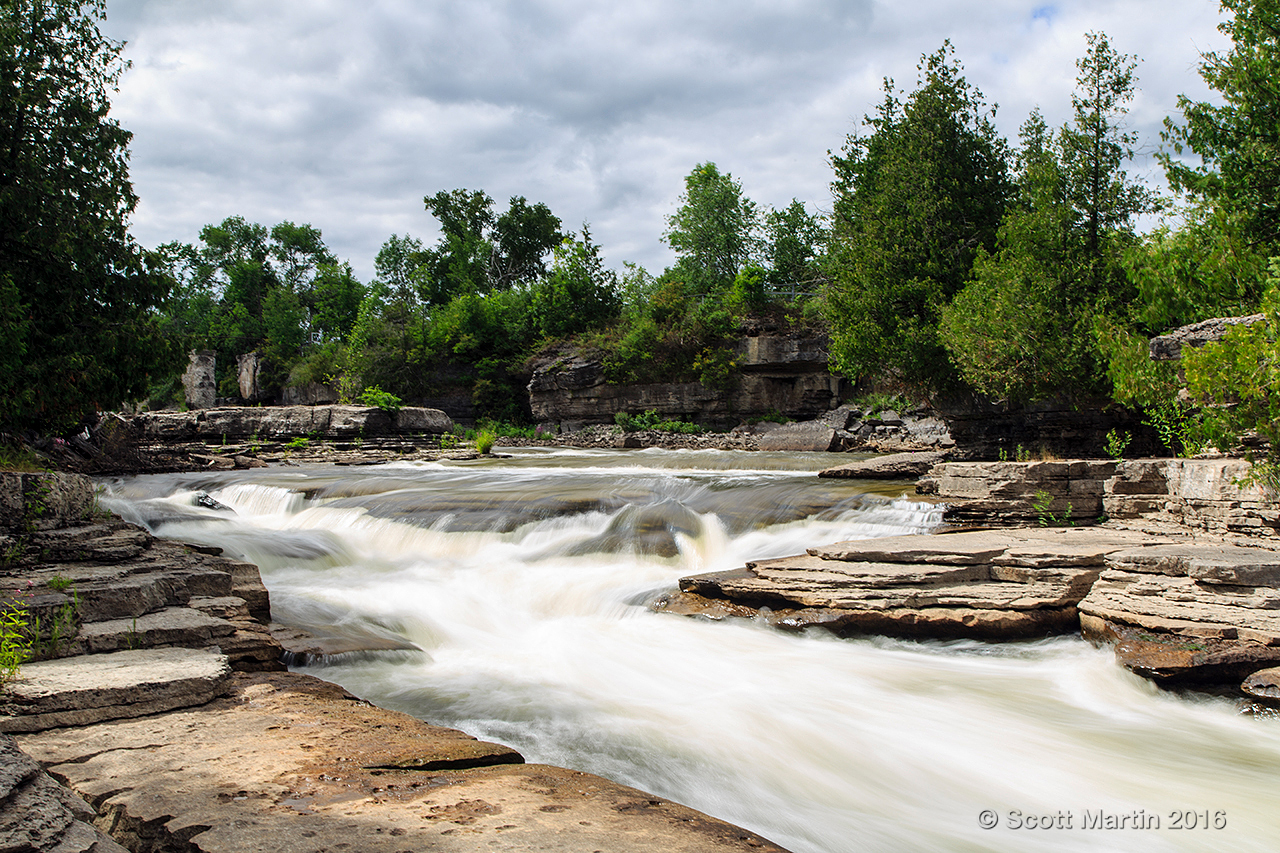
5 seconds
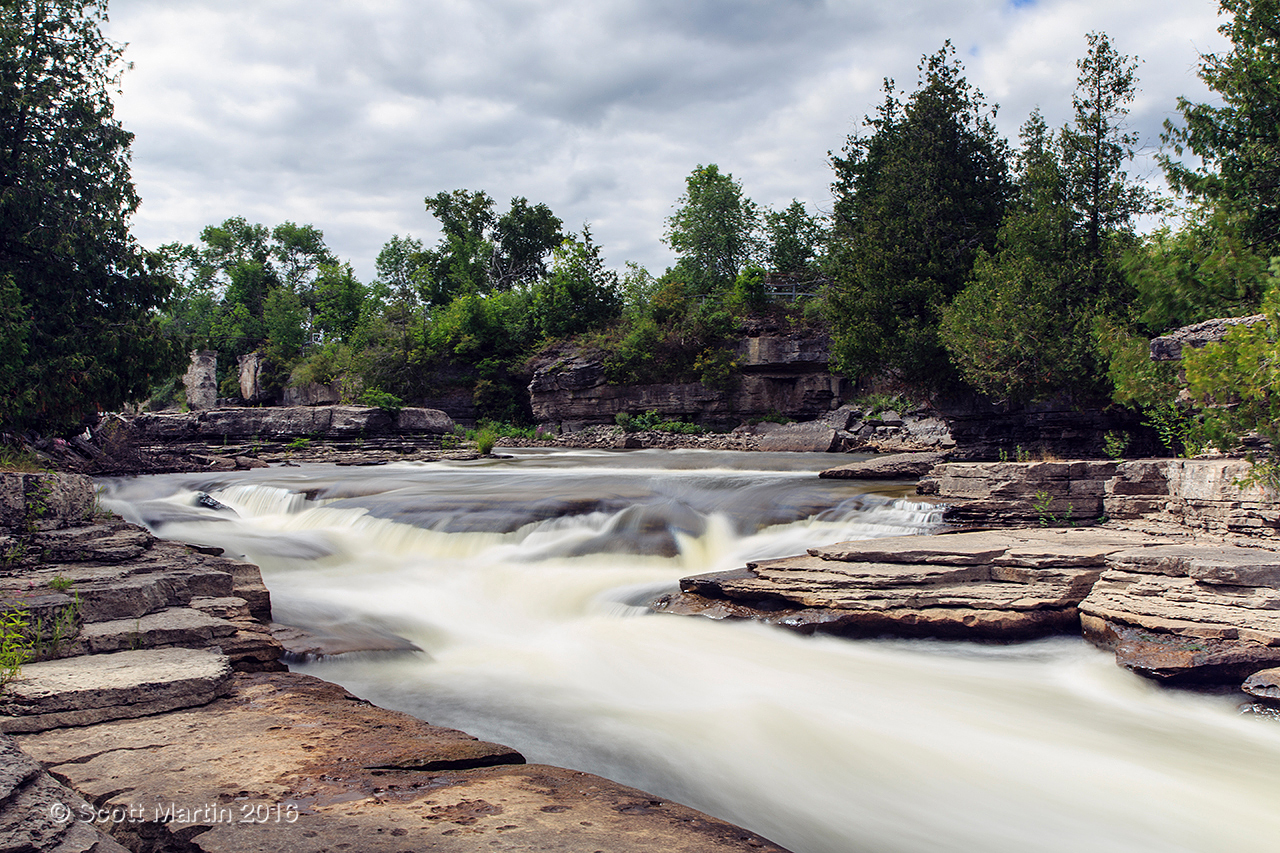
10 seconds
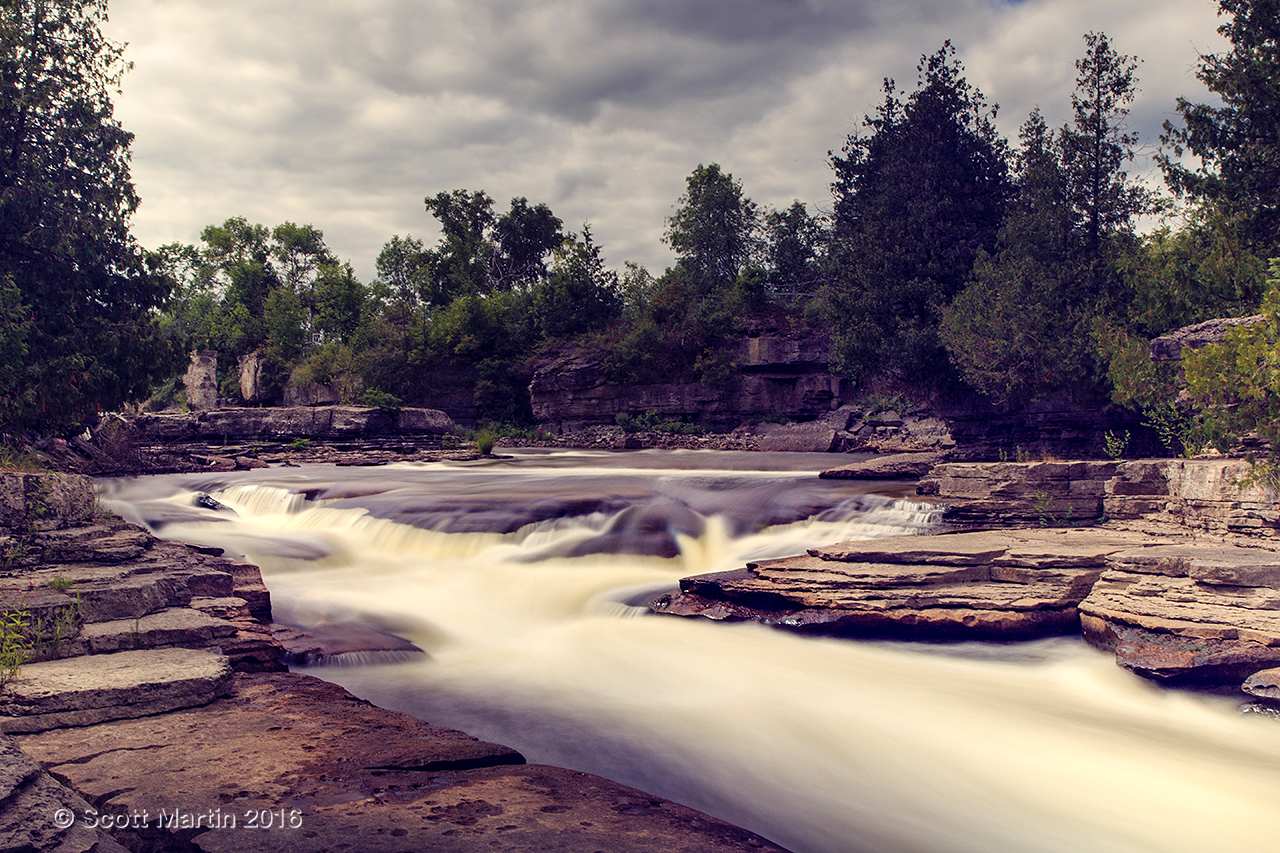
I trust the pictures from this post will encourage you to plan a trip to the Ottawa Valley and include the Bonnechere Caves and the Bonnechere River on your itinerary. It will take about half a day to see them both but if the light is nice you could certainly spend another half day exploring the river in search of that perfect shot.
All of the images in today’s blog were taken with a Canon 5D Mk III and either a 16-35mm or 24-105mm lens using a Gitzo GT1545T traveler tripod and Markins Ball head. More images of our day can be seen in the Bonnechere Caves, Eganville ON gallery.
As always, thanks for taking time to visit the blog. It is much appreciated.
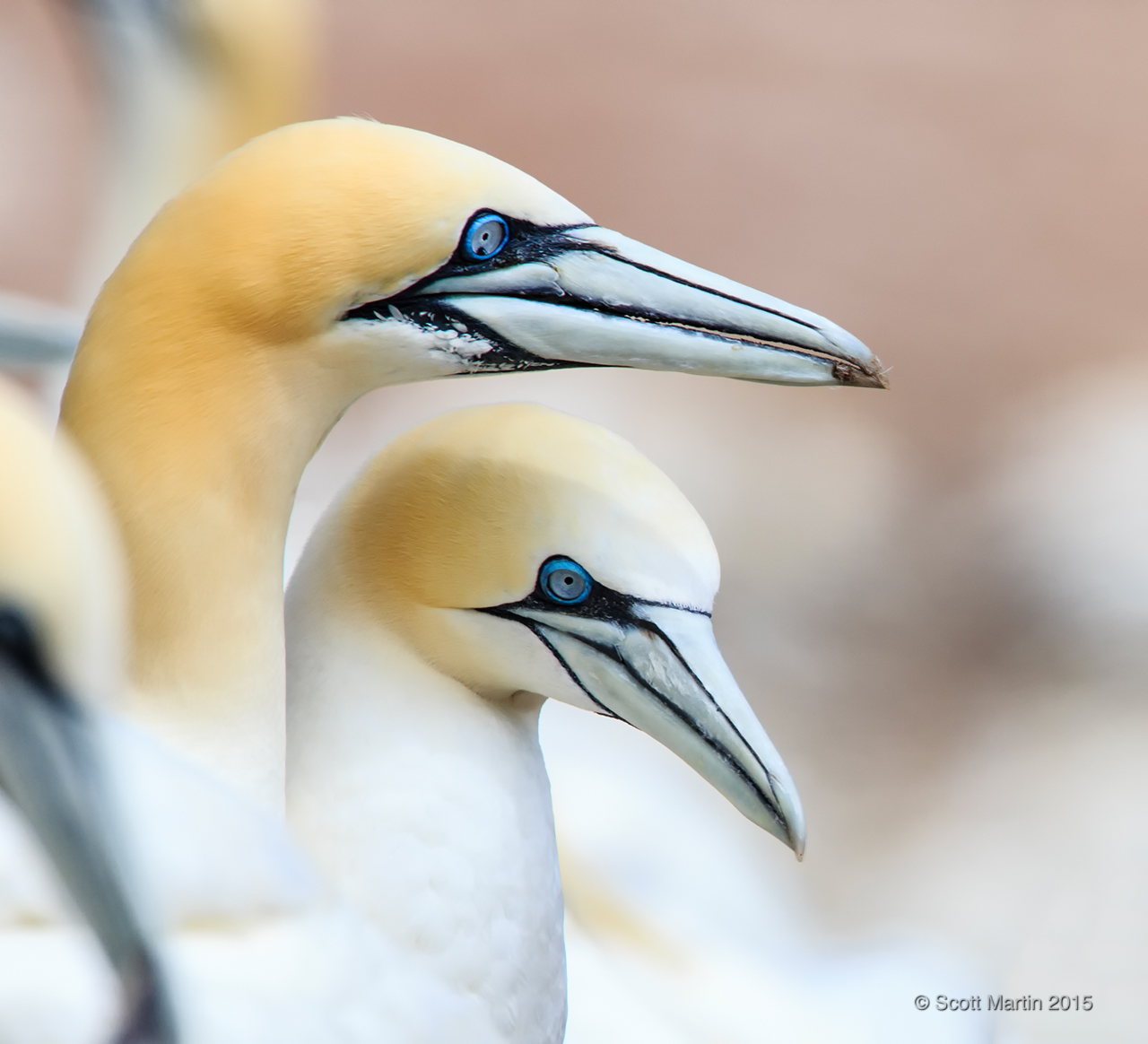
Last summer Deb and I enjoyed a day on Bonaventure Island, four kilometres off the tip of the Gaspé Peninsula near the quaint little town of Percé, Quebec. The purpose of the trip to Bonaventure Island was to photograph the Northern Gannet, a large pelagic bird that for years has made Bonaventure Island the largest nesting site in the world for Gannets. With just over 52,000 nests (2012) among five colonies on the island, there are approximately 150,000 gannets on Bonaventure Island from mid-June to mid-September each year. This was actually the second summer that we travelled to Percé hoping to photograph the Gannets. On our first trip we were met with three days of high winds and heavy rains that created seas so rough that the boats could not leave the harbour for the short trip to Bonaventure Island. We were thankful to have perfect conditions on our second annual attempt!
The land masses of Bonaventure Island and Percé Rock were amalgamated in 1985 to become The Bonaventure Island and Percé Rock National Park. The island is also designated as a Migratory Bird Sanctuary. Access to Bonaventure Island is via ferry from the main dock in Percé, which is one of the most beautiful spots in Eastern Canada offering spectacular views of Percé Rock and Bonaventure Island. If you arrive early enough in the morning, you can purchase a $20 ticket to join the first ferry of the day which transports park staff to the island. It is a direct, 20 minute trip providing first access to the island and the 2km hike across the island to reach the Gannet colonies on the far side of the island. The regular ferry is $35 and takes an hour however you travel around Percé Rock and the far side of Bonaventure Island allowing you to see the Gannet colonies on the 300′ cliffs of the island. Deb and I were the only photographers on the staff ferry so the lead time allowed us to enjoy about 90 minutes alone at the Gannet colonies before the tourists and other photographers arrived.
Having the whole day set aside to spend on Bonaventure Island enabled us to plan for many different types of shots including some video. Although we probably took too much gear with us, we used it all and were thankful we made the effort to lug it across the island. Our gear for the day included a Kata backpack filled with a Canon 5D Mk III plus 16-35mm, 24-105mm and 100-400mm lenses as well as a Fuji X-E2 body, 8mm fisheye and 18-55mm lenses. Attached to the backpack was a Gitzo traveller tripod with Markins ball head. Balanced on my shoulder was a Canon 1Dx and 500mm telephoto lens attached to a Jobu carbon fibre monopod and gimbal head. It took about 45 minutes via the shortest trail to reach the Gannet colonies. It was a great hike on a well travelled path cutting directly across the island starting at sea level and rising to about 300′ over the 2km walk.
The hike is mostly in heavy forest and as we approached the far side of the island the scents and sounds of the Gannets greeted us long before the actual birds did. Both the smell and the sound were like nothing Deb & I had experienced before however we quickly acclimatized to both!
The Northern Gannet’s behaviour is quite paradoxical and some of these ironies will be highlighted throughout this post. I think this great pelagic bird is best summed up by Lucie Lagueux, a world renowned expert on the Gannet, who states “What surprises me most about the gannet is its overwhelming ambivalence. Although it is a sea bird, perfectly adapted to life in a marine environment, it spends more than six months on dry land. While its anatomy and behaviour make it eminently suited to cliff-nesting, it does not seem to be able to resist the temptation of the plateau. The gannet is a territorial bird, yet it lives in a very dense colony. It is an aggressive bird, yet its aggressiveness has but one goal: to ensure proximity to other gannets. Finally it is a very predictable bird – in most cases, the gannet’s reaction to a given situation can be easily anticipated. Yet sometimes it exhibits behaviour which is quite inexplicable”. This perfectly describes our observations of the Gannets during the time we spent with them.
When arriving at the colonies for the first time one is astounded by the sheer number of birds. It is difficult to appreciate what 100,000+ birds looks, sounds and smell like and although these images won’t do any of them justice, perhaps this video will help!
The density of the colony is shown below and its remarkable that Gannets returning from fishing excursions can find the exact location of their nest, however they always do. To put the density into perspective, the typical nesting site is 75 cm in diameter and adjacent nesting sites measure 80 cm centre to centre. Nest density is 2.3 nests per square metre.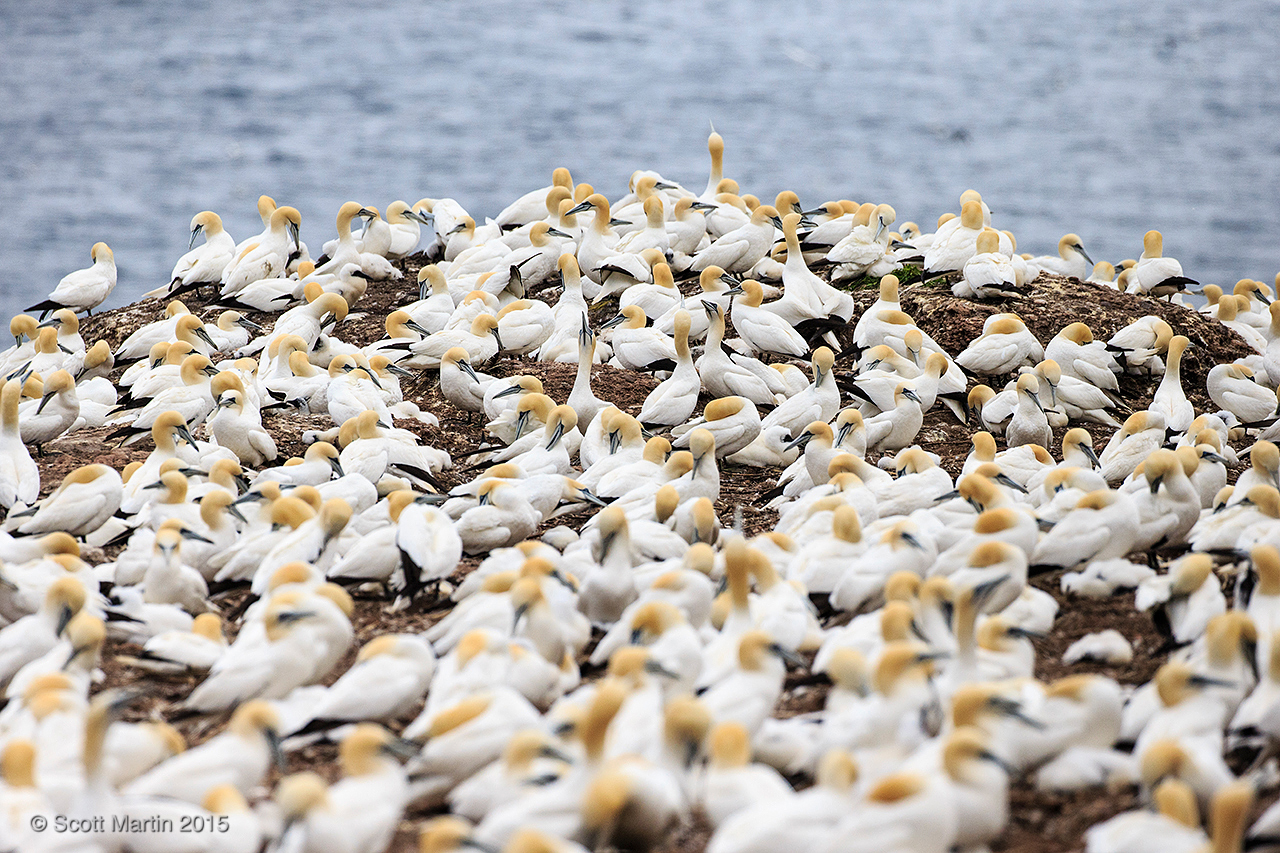
Finding the right nest is a challenge for the Gannet and you can in this next image the reception that the landing Gannet receives from its neighbours.
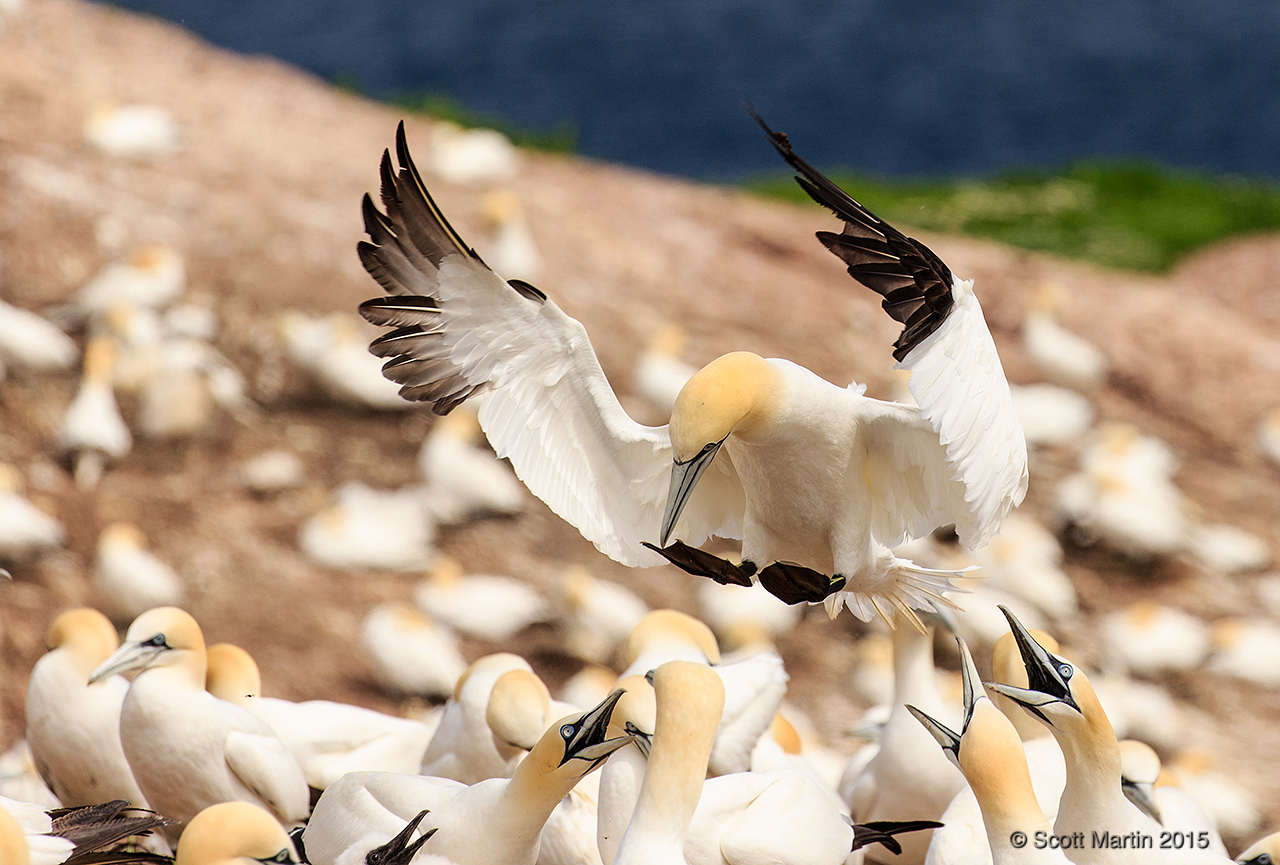
The Northern Gannet is a large pelagic bird weighing on average 3.2 kg with a wing span of 1.8m. Gannets have average lifespans of twenty years however have been known to live for as long as forty. It is a beautiful bird, especially in breeding plumage when the head and crown take on a warm golden hue and the feet are accented with bold green lines.
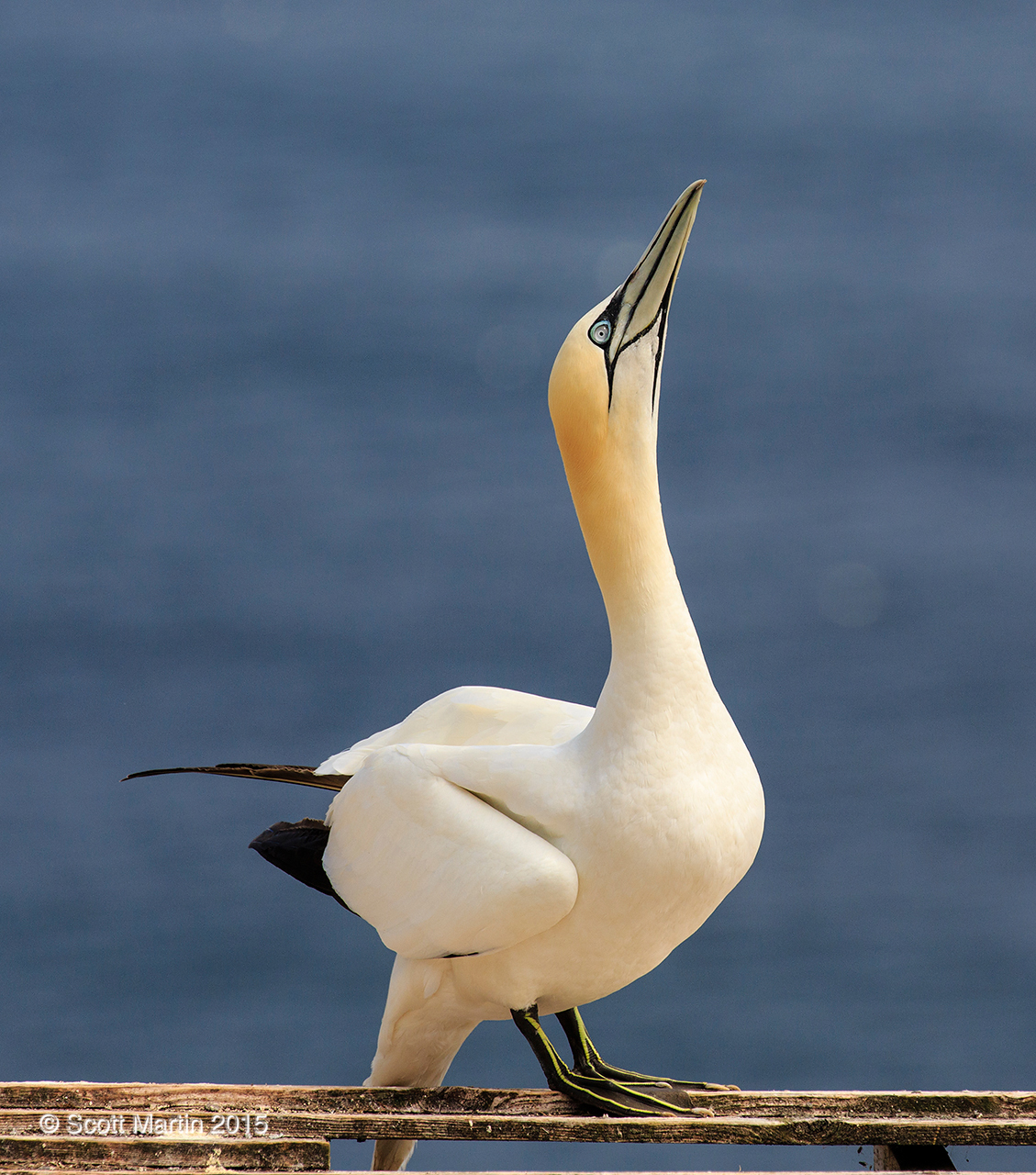
Gannets are also beautiful in flight and their large wing span and thin wings make them excellent gliders. The white underside of the gannet also provides them great camouflage while hunting.
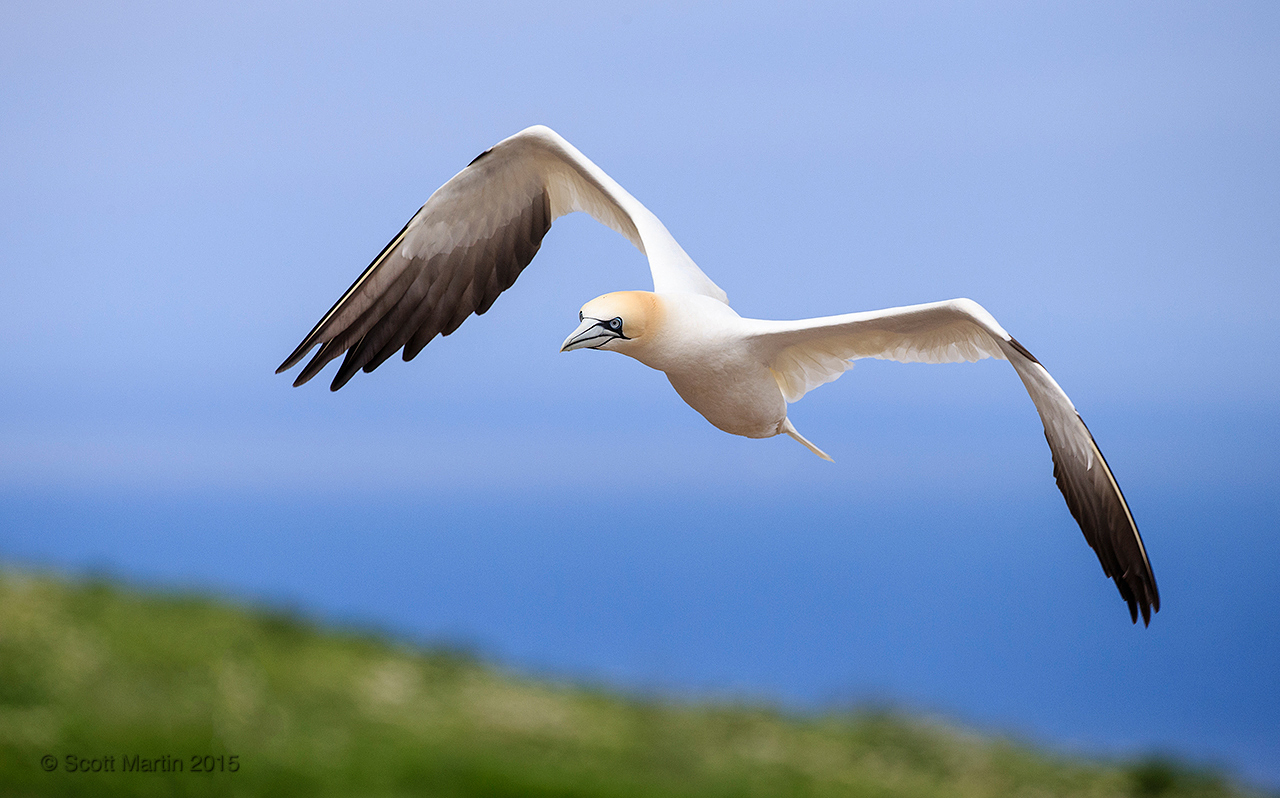
Nests are manicured mounds on the ground that are very sparse yet well defined as seen below. The highly territorial Gannet defends the nest fiercely even though they are very close to their neighbours.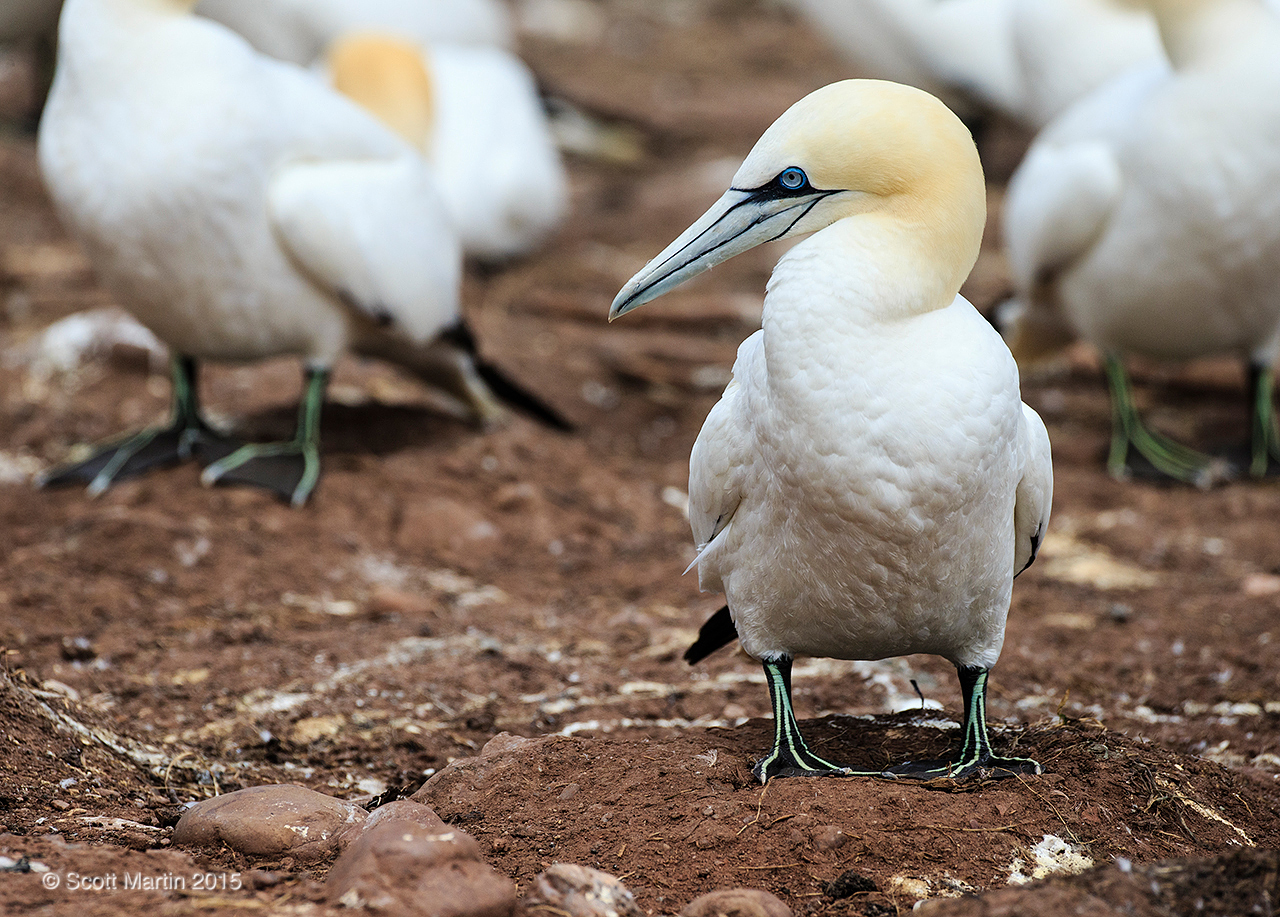
The female Gannet easily lays a single egg as egg size is small compared to the size of the adult bird. Incubation lasts approximately 43 days during which the egg is surrounded by the webbed feet of the parent who’s increased blood flow to the feet keeps the egg warm.
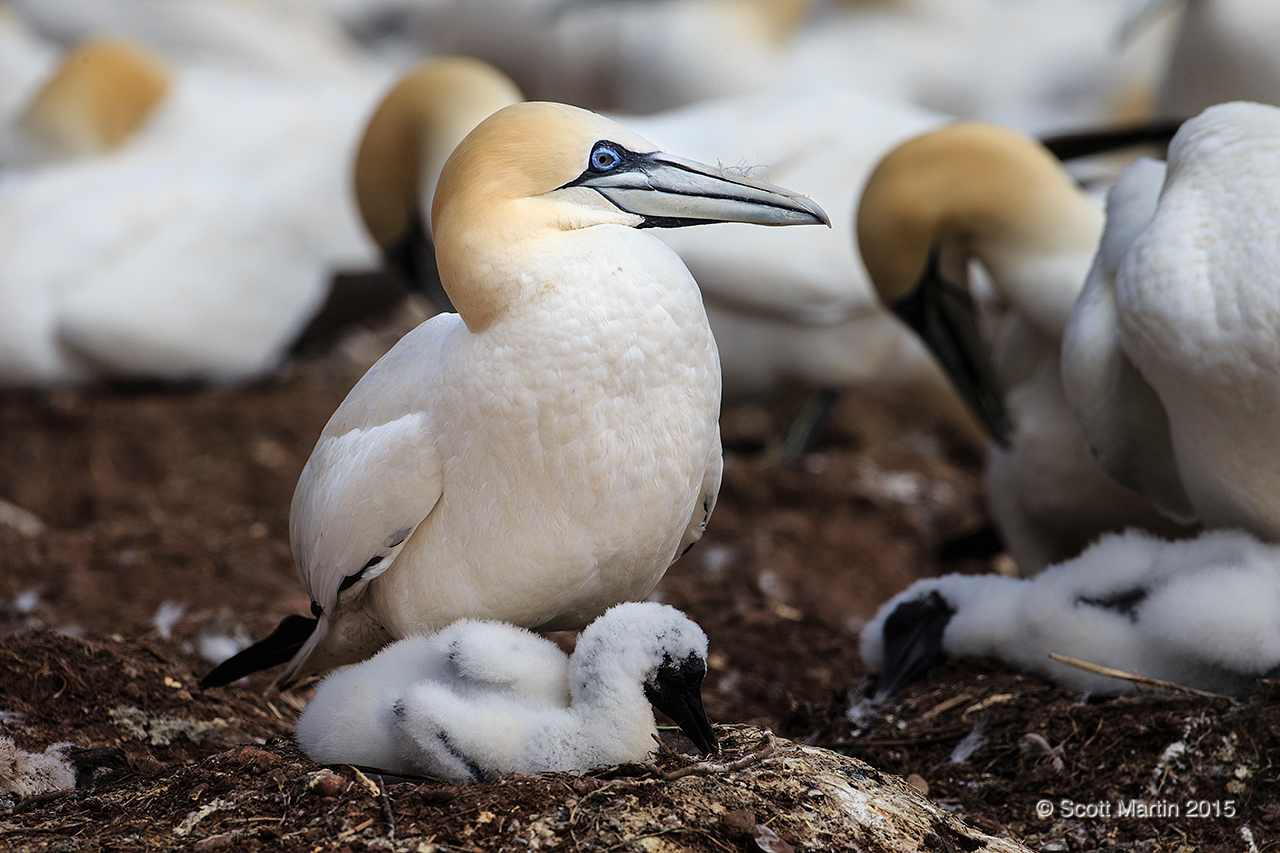
Parents take turns between guarding their chick and fishing to provide food for the newest family member. They transfer partially digested fish to the young bird and it grows rapidly for the 75 days before it fledges.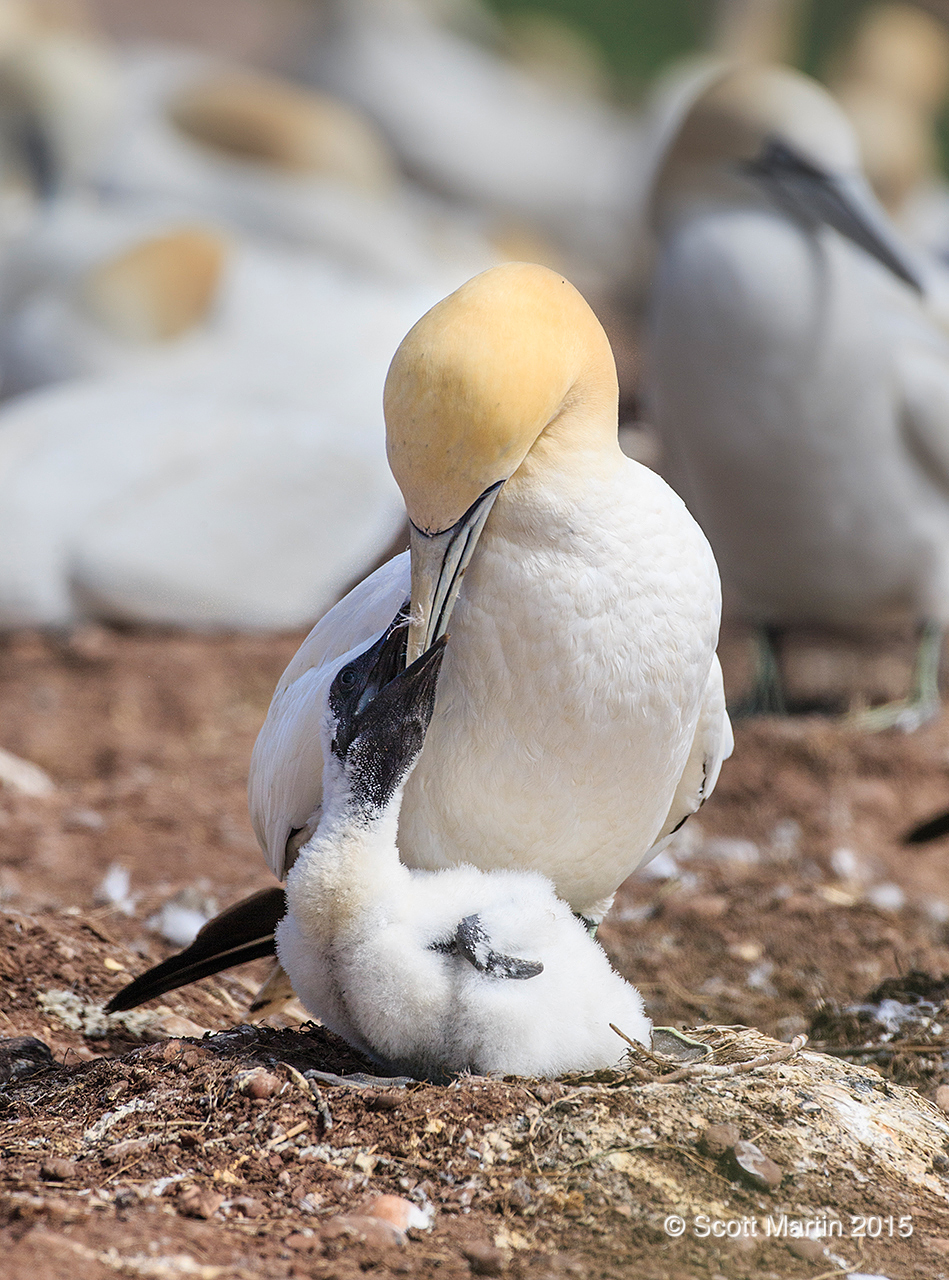
Young birds remain on the nest until they fledge. As they expend little energy while confined to the nest and are continually being fed they actually grow to become larger and heavier than their parents. In fact they weigh almost 1 kg more than the adults when they leave the nest at 10-12 weeks of age. When they fledge they leave the nest and their parents for good and are on their own from that day until they mate at five years of age (younger birds will return to a colony at the age of two or three, but remain at the periphery of the colony and do not pair up or nest until age five). It is quite humorous to see a large young Gannet with its significantly smaller parents just before fledging.
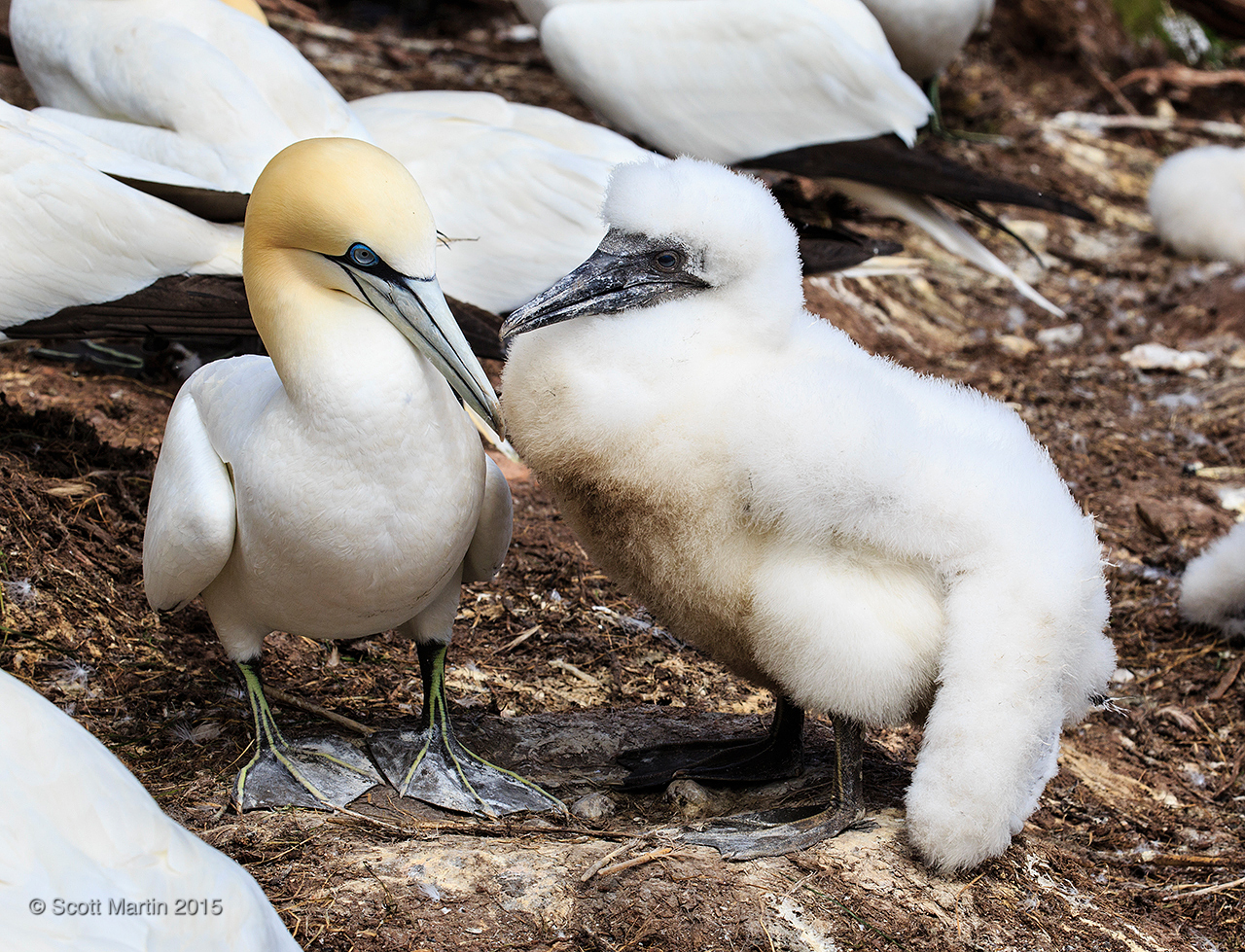
New born Gannets can not be left unattended by its parents as neighbouring Gannets will attack them and should a young bird move off the nest it will surely be destroyed. This is one reason, the first year mortality rate of Gannets is over 60%. This next image shows the fate of a young bird that has inadvertently moved off its nest while its parent vainly tries to come to the rescue. You can see the remains of another chick in the foreground….a poignant visual display of life and death on a Gannet colony. When Gannets lose an egg or young chick they will often lay a second egg and have a second brood during the breeding season. For this reason you can concurrently observe chicks of all different sizes and stages of development within the colony.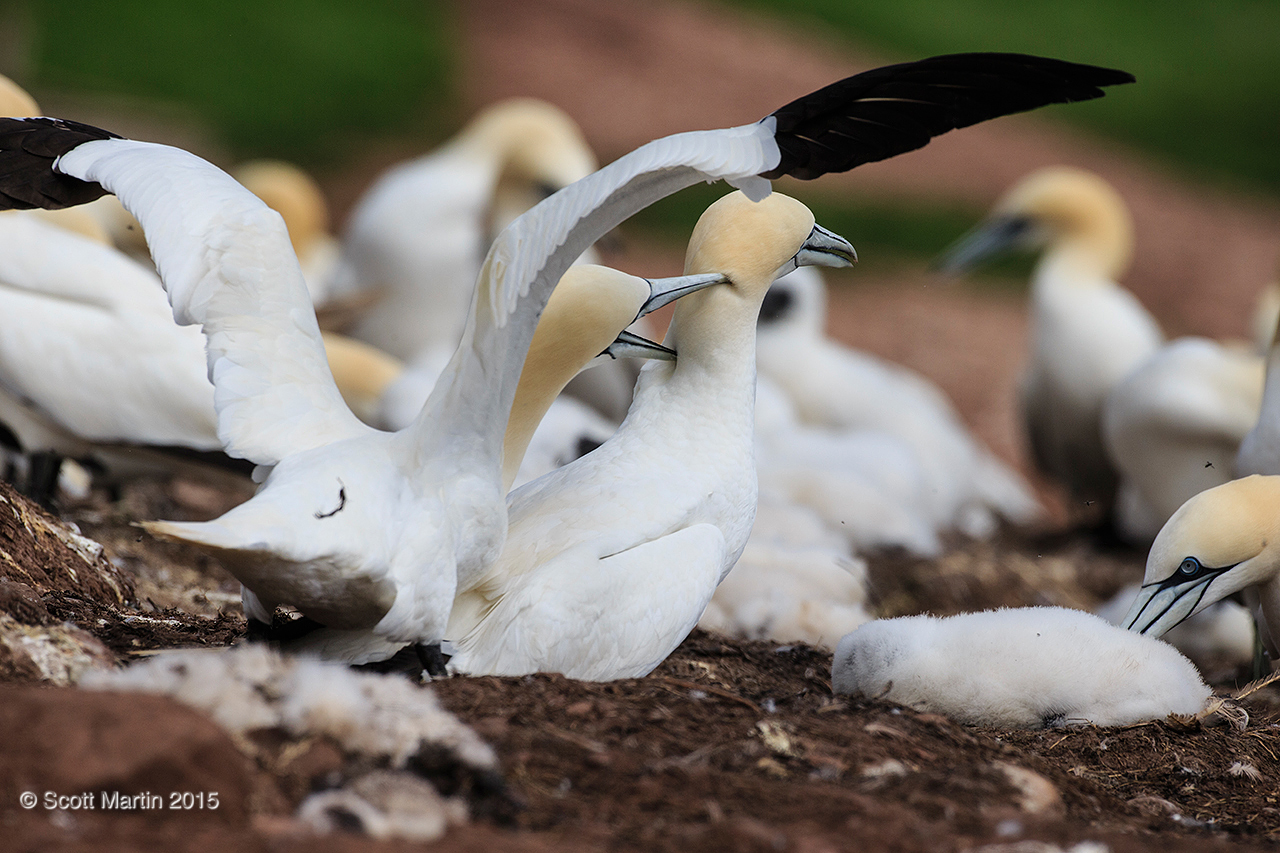
Gannet behaviour is unique and fascinating to observe. The high density of birds in the colony make communication a survival necessity and the Gannets do so through tactile, visual and auditory channels. Gannet behavioural displays provide interesting photo opportunities for the bird photographer. I would highly recommend before travelling to Bonaventure Island that you take time to study Northern Gannets and familiarize yourself with their behaviour. This will allow you to better recognize what is unfolding in the colony and help you compose and capture the signature Gannet behaviours.
Fencing is perhaps the most easily recognized behaviour and is an important mating ritual. Gannet pairs extend their necks with beaks pointed skyward and delicately touch their bills together in a fencing motion. This activity always takes place at the nesting site. Fencing provides an excellent opportunity for that classic Gannet shot as shown in these next images.
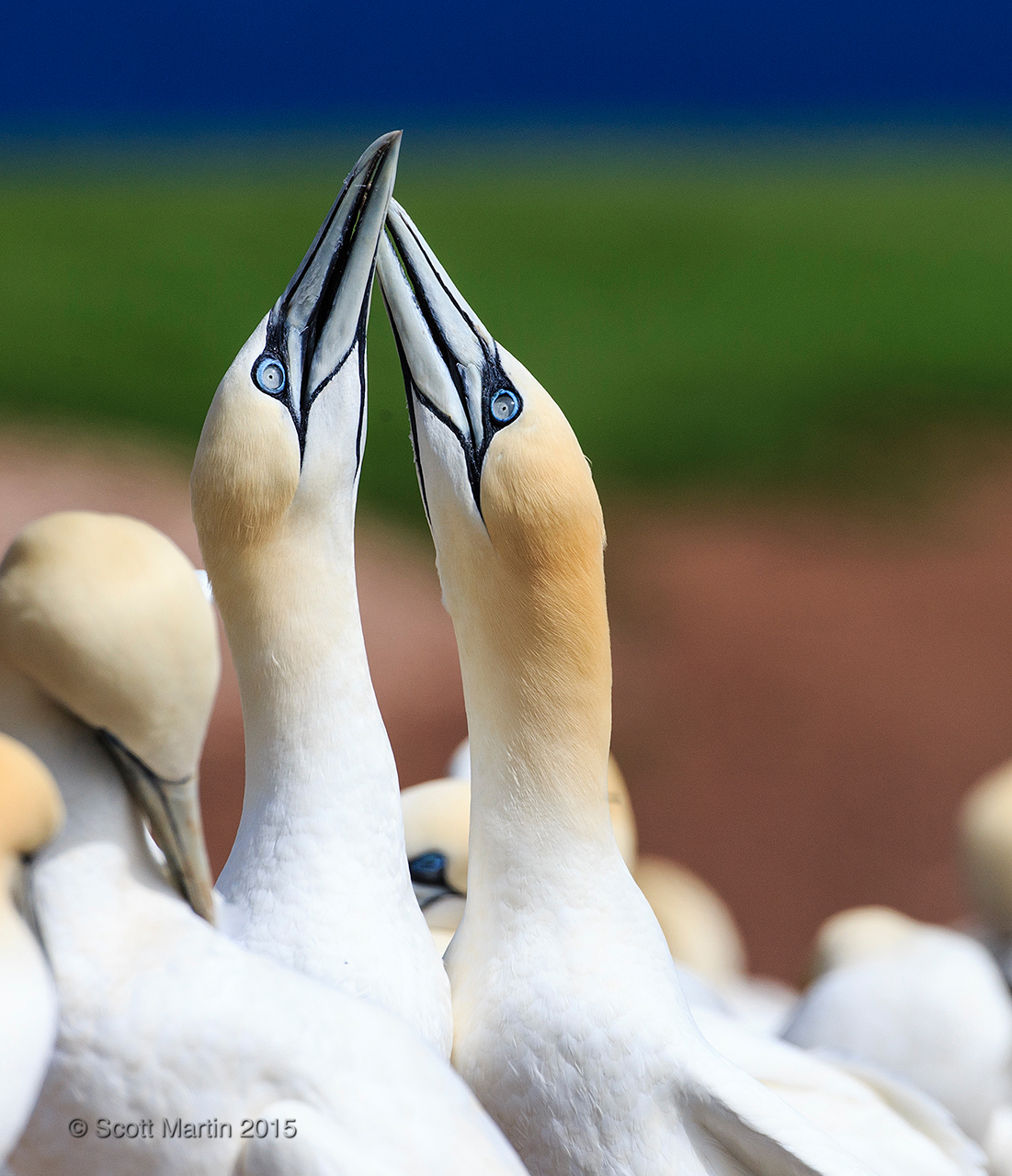 To capture fencing effectively, a low angle is required to separate the Gannets from the other birds and also create a clear back ground to enhance the photographic result.
To capture fencing effectively, a low angle is required to separate the Gannets from the other birds and also create a clear back ground to enhance the photographic result.
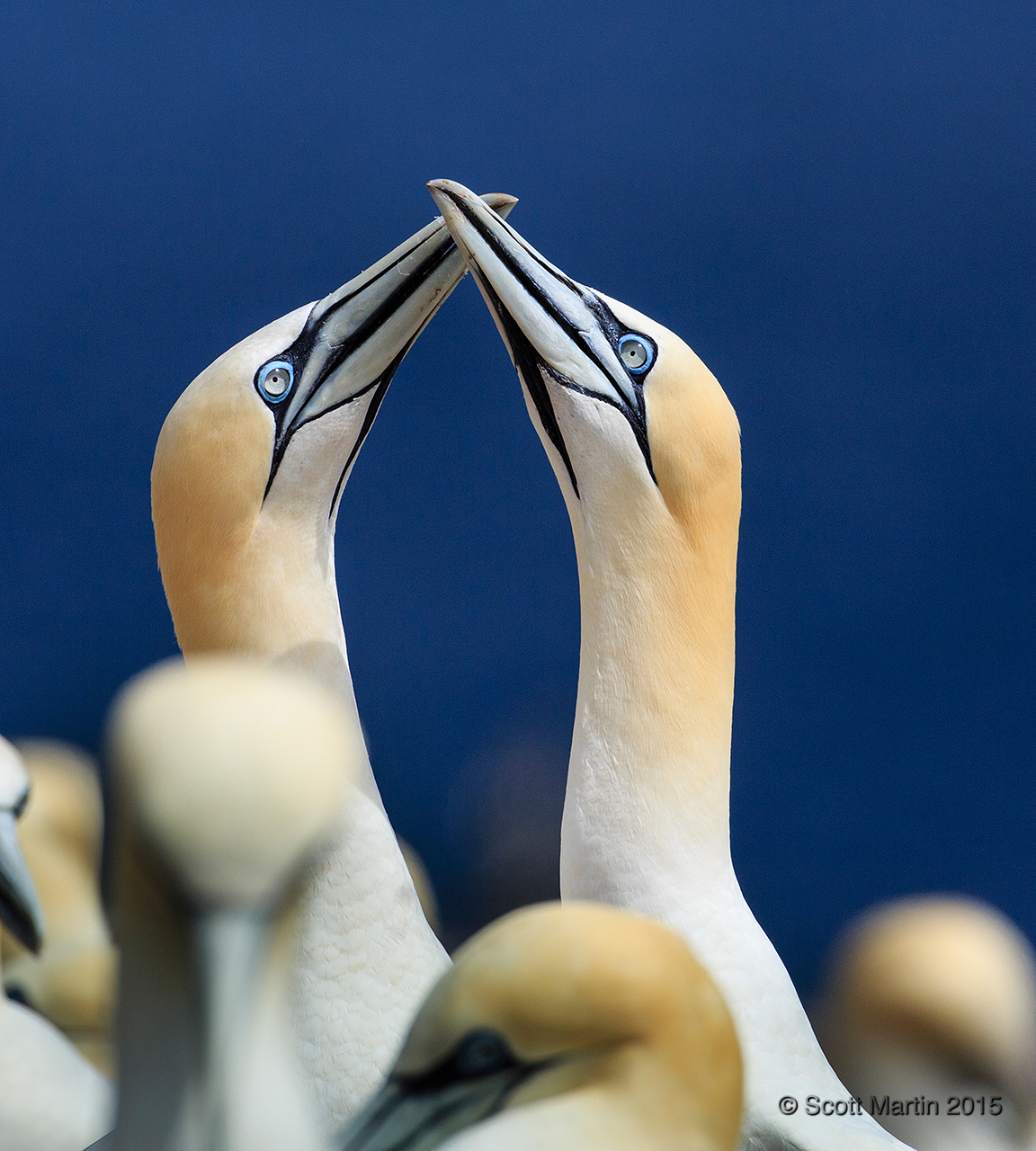
Yes, that means lying down in order to ‘get the shot’, but it’s always worth that extra effort!
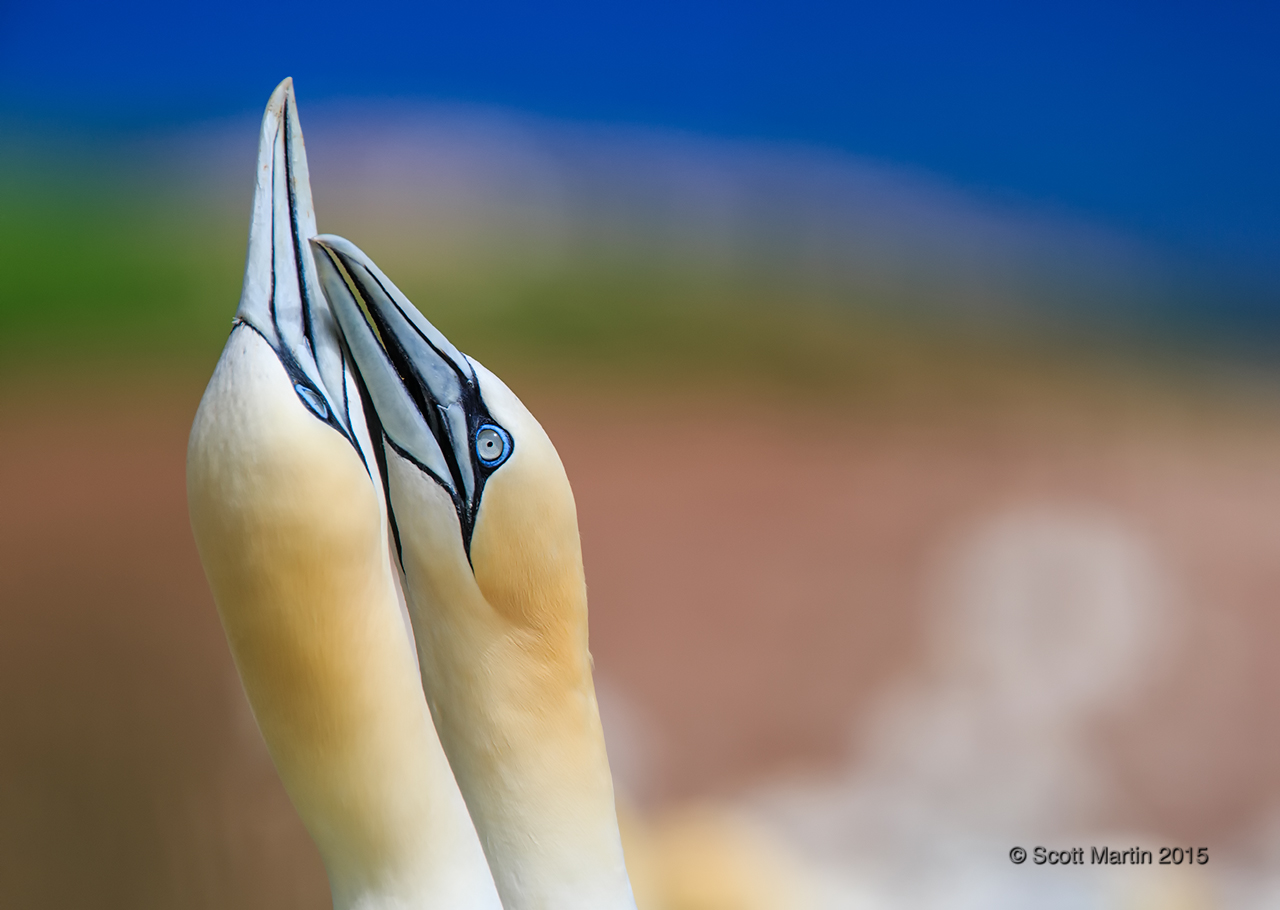
You can see and sense the affection these birds share with each other, which as monogamous couples they do for life.
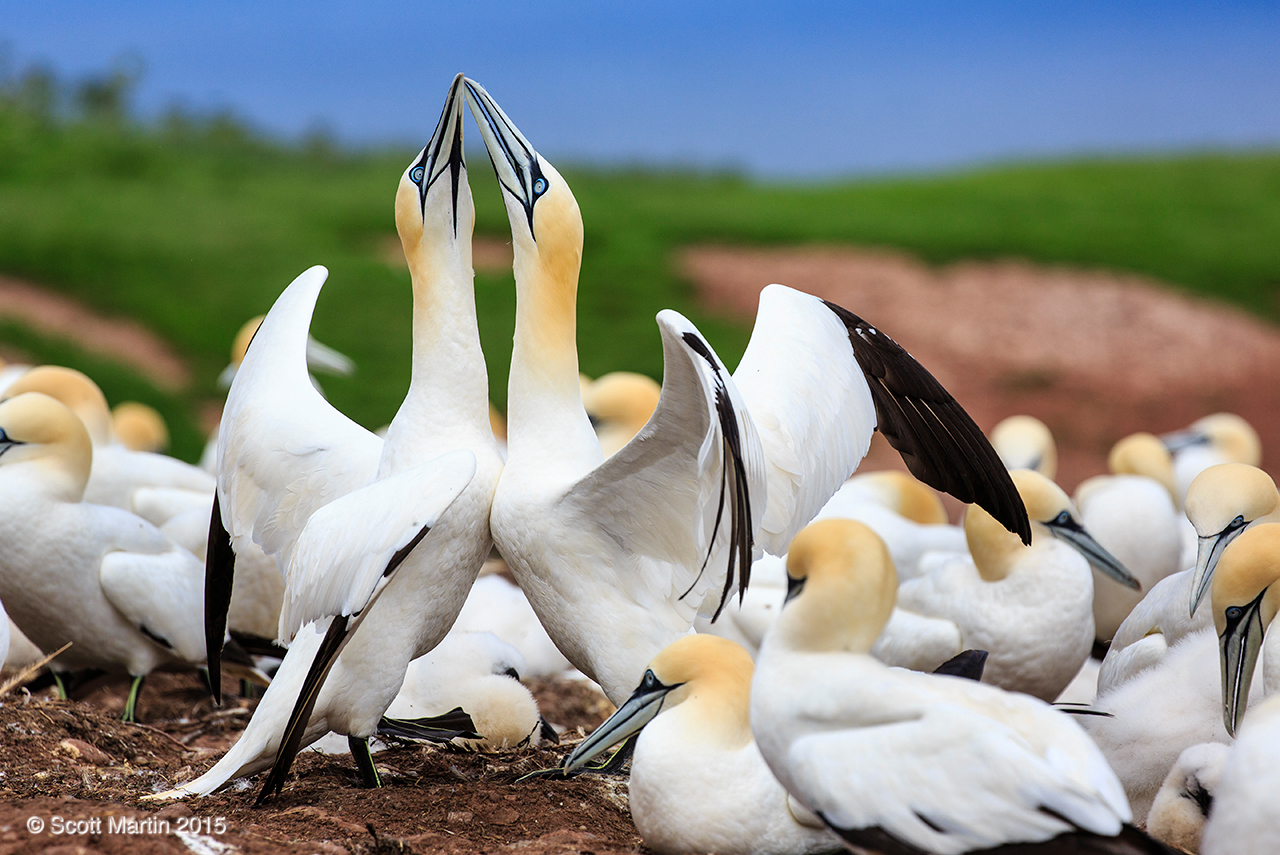
Although this next image lacks any eye contact (a bird photographer’s no no) it has become a favourite of mine with its artistic feel.
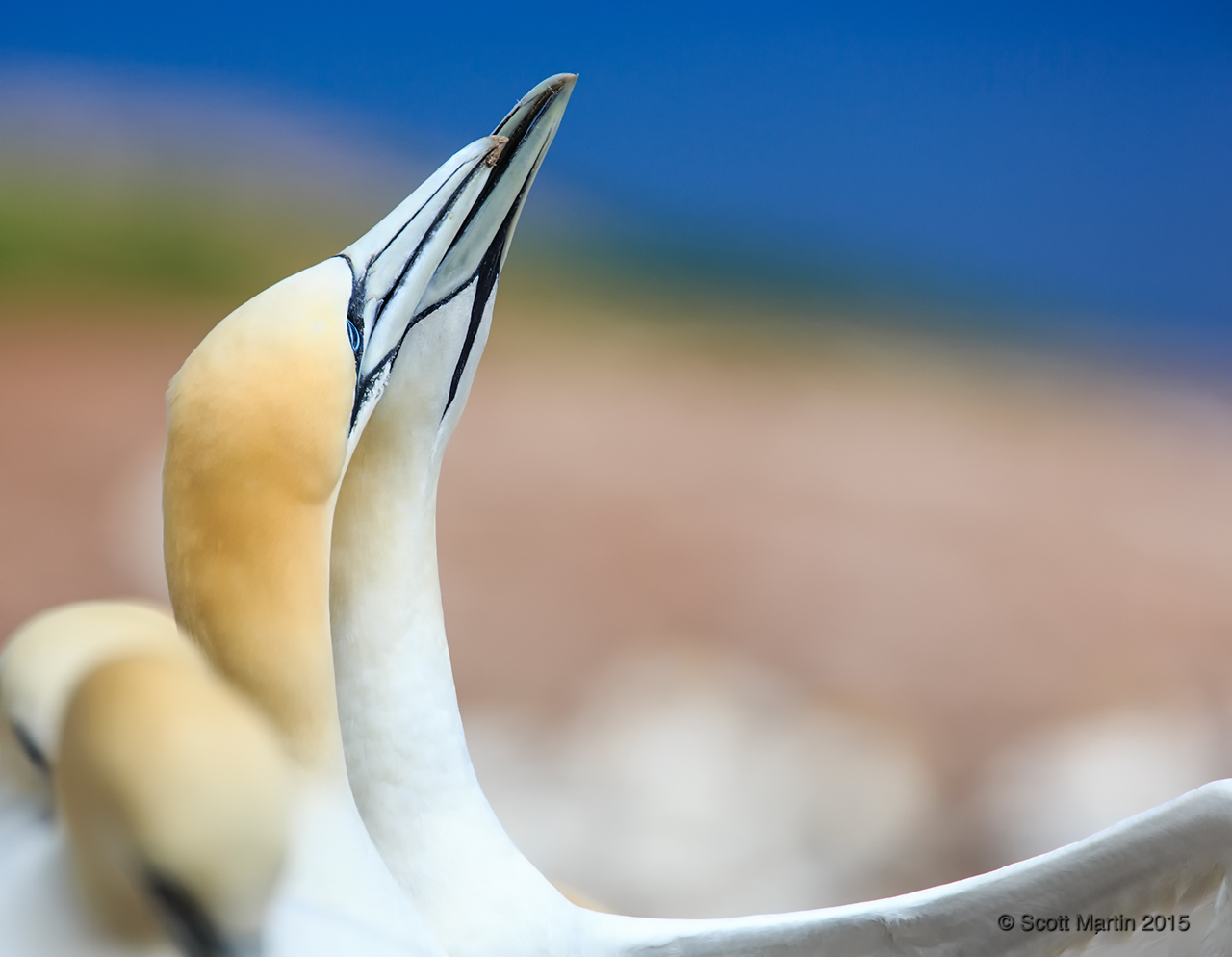
Mutual preening is another important mating ritual. The Gannet pair caresses and smooths the other’s feathers, typically around the head and neck.
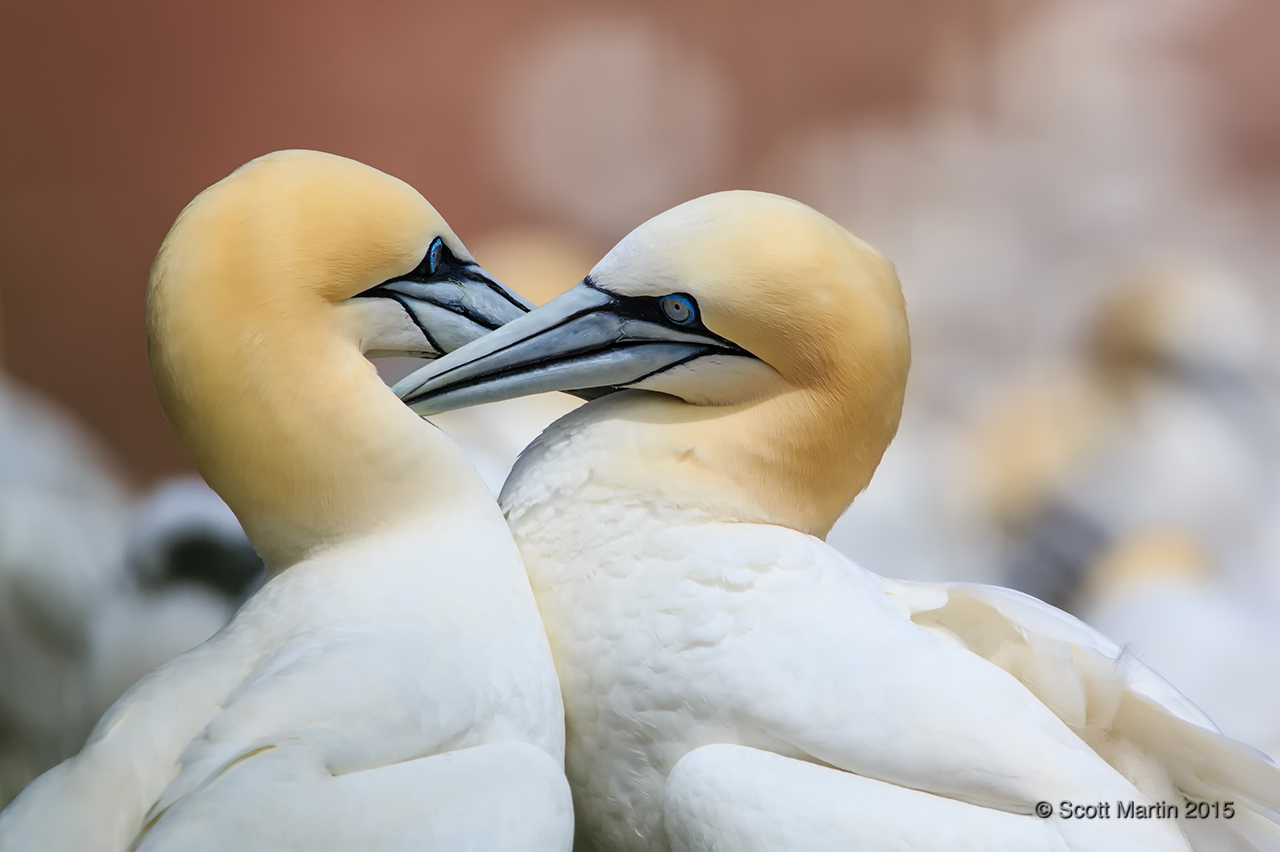
They will preen each other for extended periods of time.
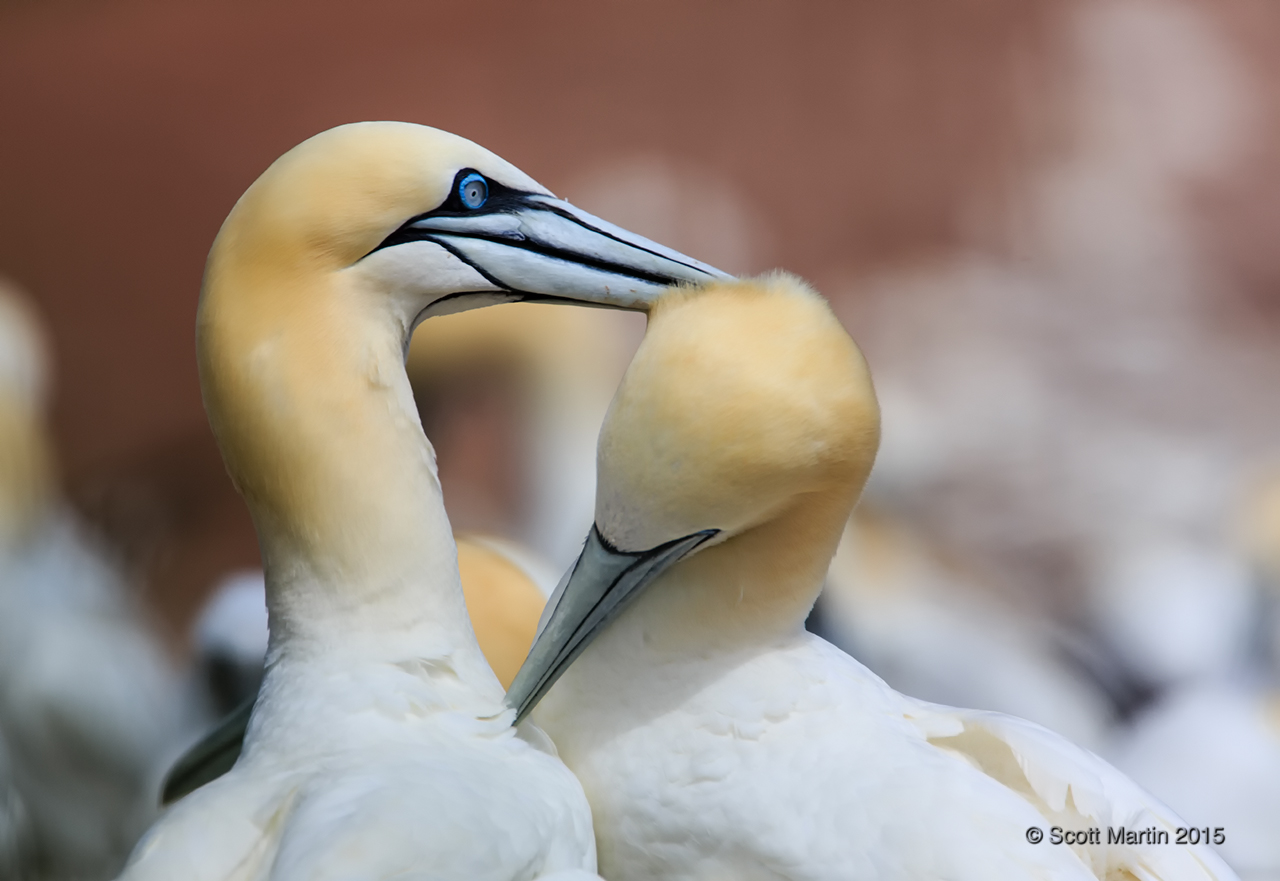 Unfortunately, fighting is common amongst Gannets, sometimes between pairs and more often with other Gannets that venture too close to a neighbouring nest. When fighting the birds anchor their claws into the ground and extend their necks to fight with their beaks. It often appears that they are attempting to jab the opponent’s eyes.
Unfortunately, fighting is common amongst Gannets, sometimes between pairs and more often with other Gannets that venture too close to a neighbouring nest. When fighting the birds anchor their claws into the ground and extend their necks to fight with their beaks. It often appears that they are attempting to jab the opponent’s eyes.
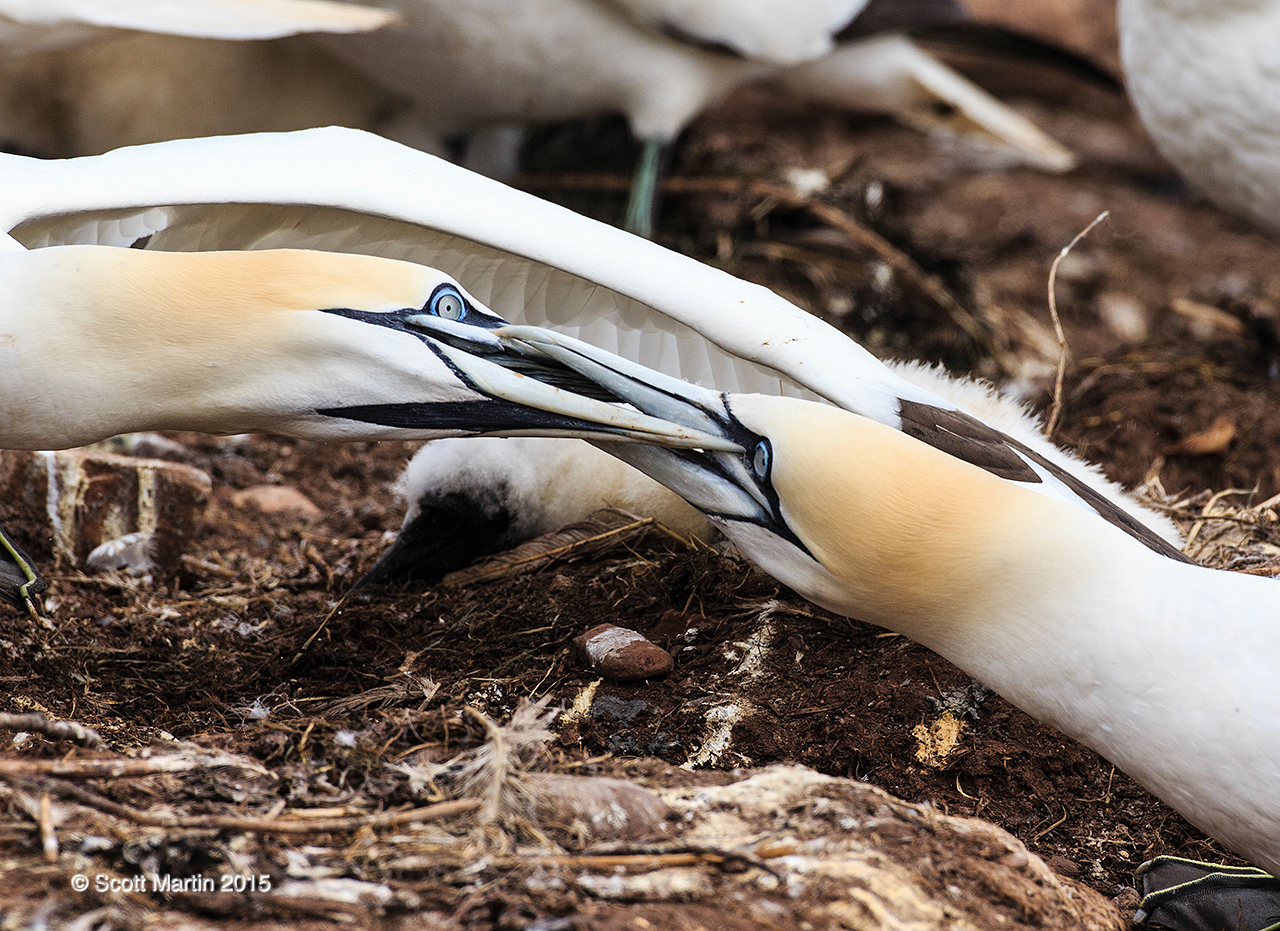
Threat-gaping, menacing and jabbing are related behaviours usually between Gannets on adjacent nests, where from a sitting position the birds jab towards each other while making lots of noise. There is generally no contact between the birds.
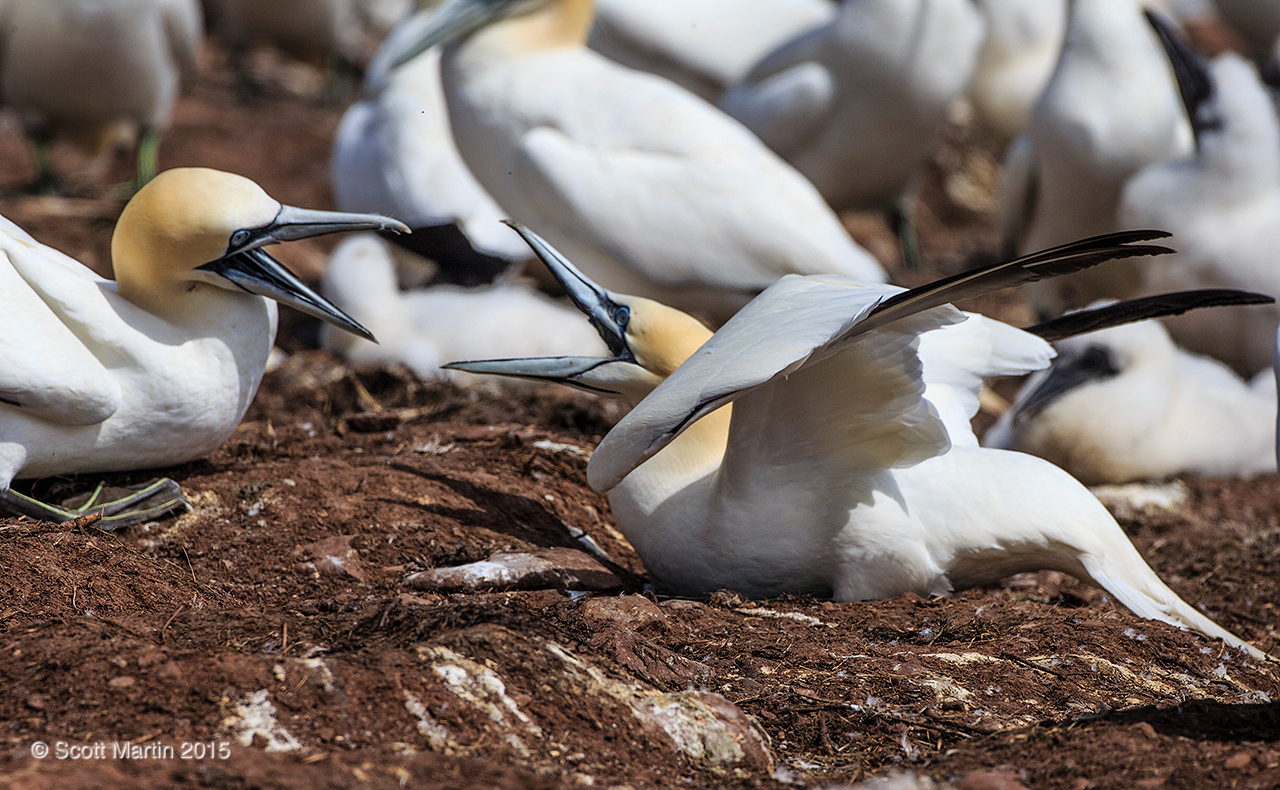
The last behaviour we will look at is called sky pointing and is thought to signal to a mate that the pointing partner is going to leave and the other is to stay and guard the nest. It is also performed by any Gannet in the colony who is about to take flight. When sky pointing, the neck is extended and bill pointed skyward, the wings are drawn back and the feet are prominently displayed with their bright green lines on black webbing.
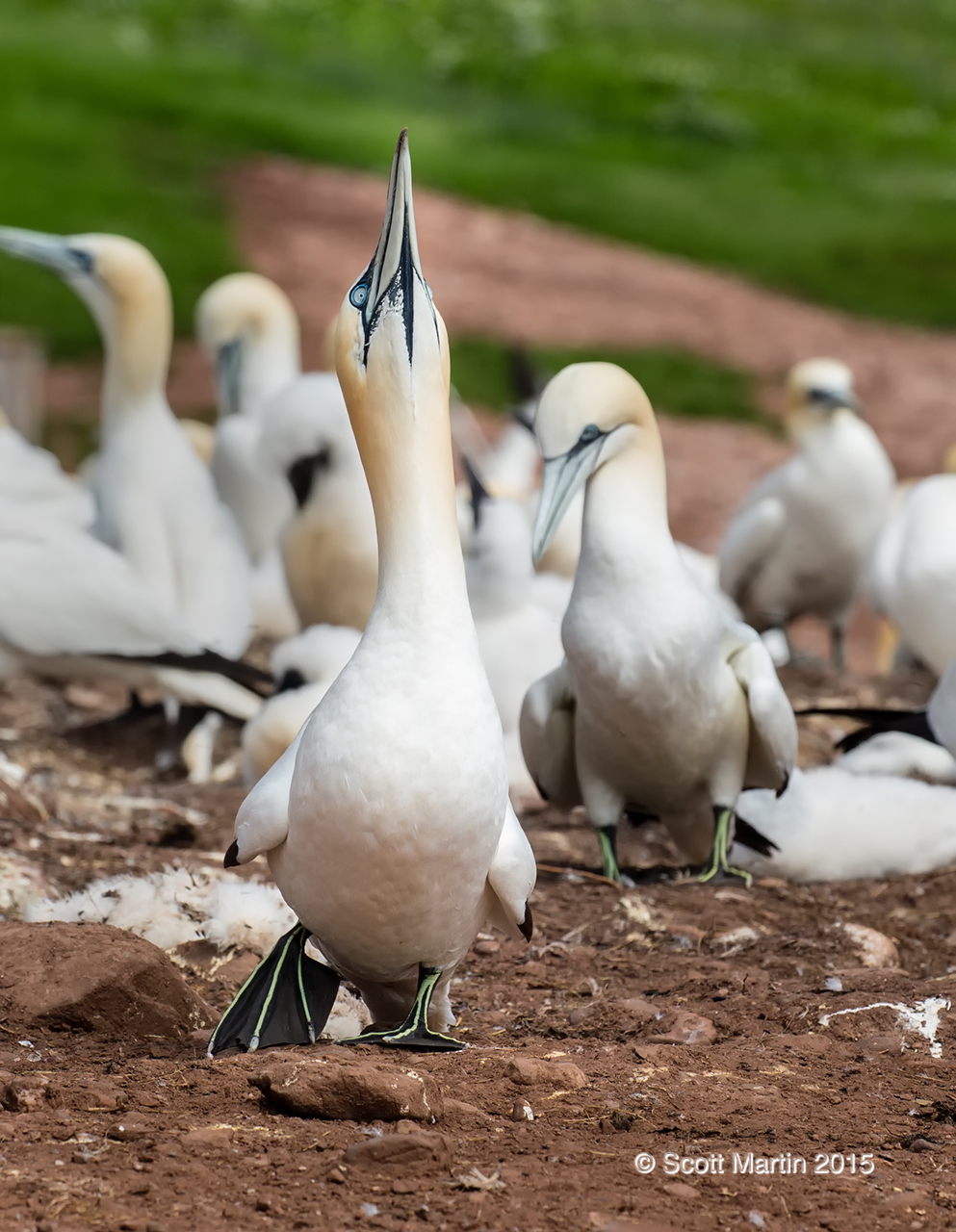
.
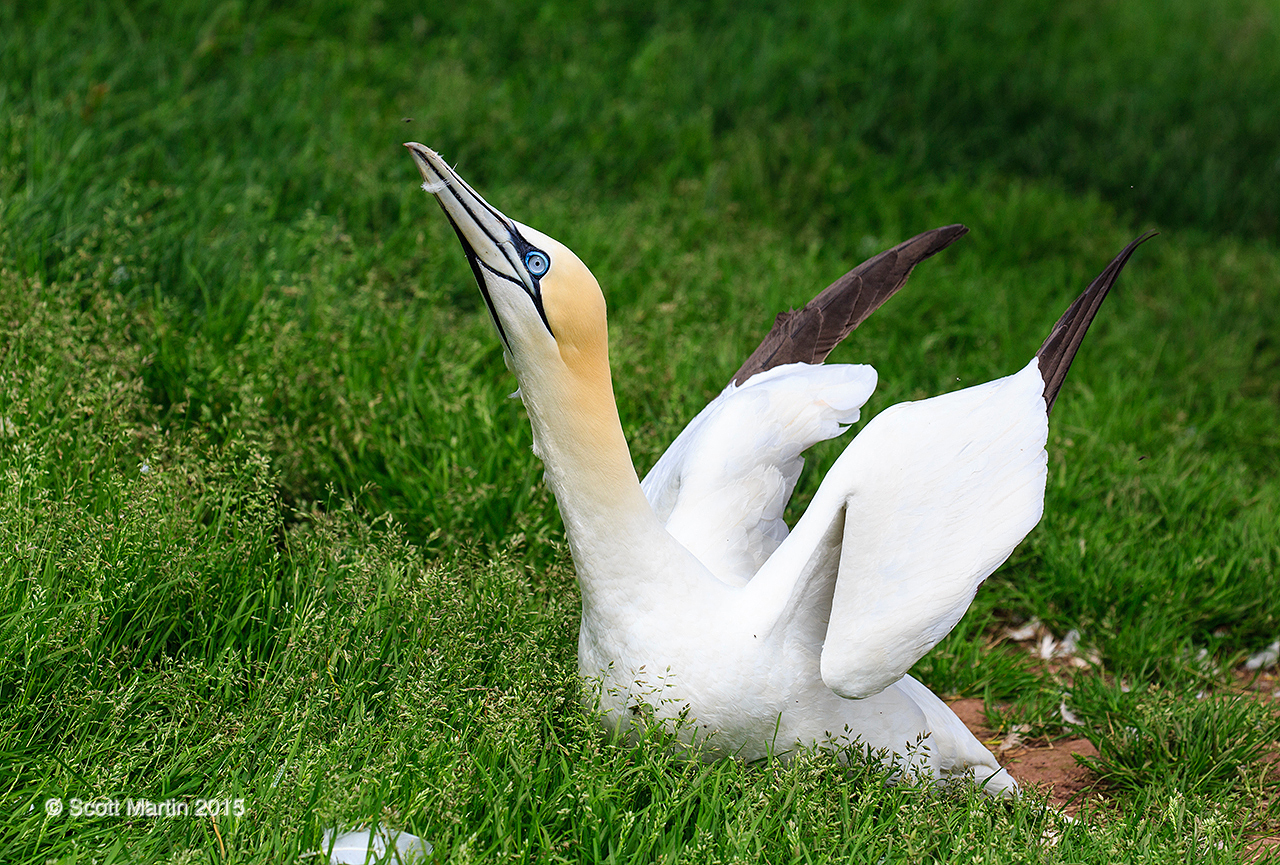
The Gannets of Bonaventure Island feed primarily on Mackerel, Herring and Capelin and they consume lots of them. It is estimated that each bird consumes 500 g of fish daily and that the annual fish consumption of the Bonaventure colony is 3,100 tons or 6.2 million pounds. It is fascinating to watch Gannets fish as they always do so in groups. Look-out birds scout the ocean for schools of fish and once found they must signal the others as large groups of Gannets quickly congregate overhead and then with pin point accuracy dive into the school of fish from impressive heights and at great speed. This style of group diving, sometimes described as hailstorm fishing causes panic and disorientation within the school of fish and it is thought that this greatly improves the Gannet’s success rate compared to fishing alone.
The following images show the classic diving sequence of the Northern Gannet. These images were taken from the pier in the town of Percé which is where the ferries leave for Bonaventure Island. The waters between Percé and Bonaventure are sheltered and thus are a prime fishing location for the Gannets.
A Gannet cruising high above the water spots a target, puts the brakes on and prepares to begin its dive.
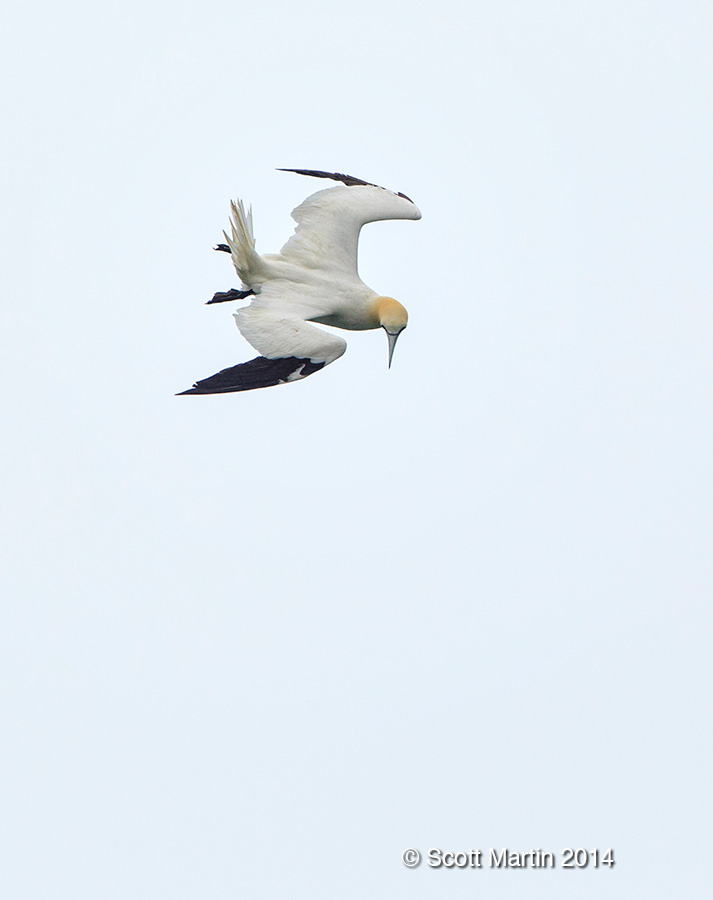
The dive begins with Bonaventure Island looming in the back ground
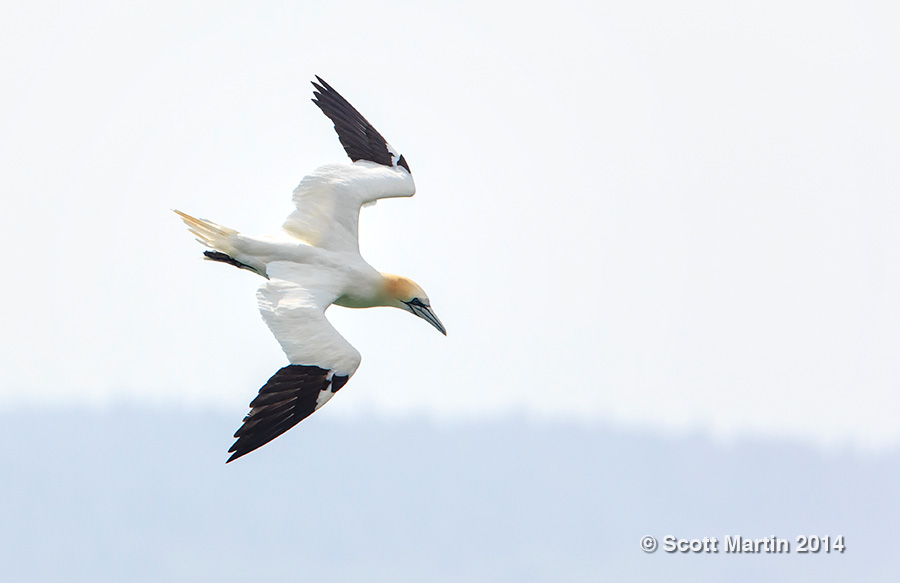
Gannets begin their dives approximately 100′ above the water and use their outstretched wings to steer them directly towards the target.
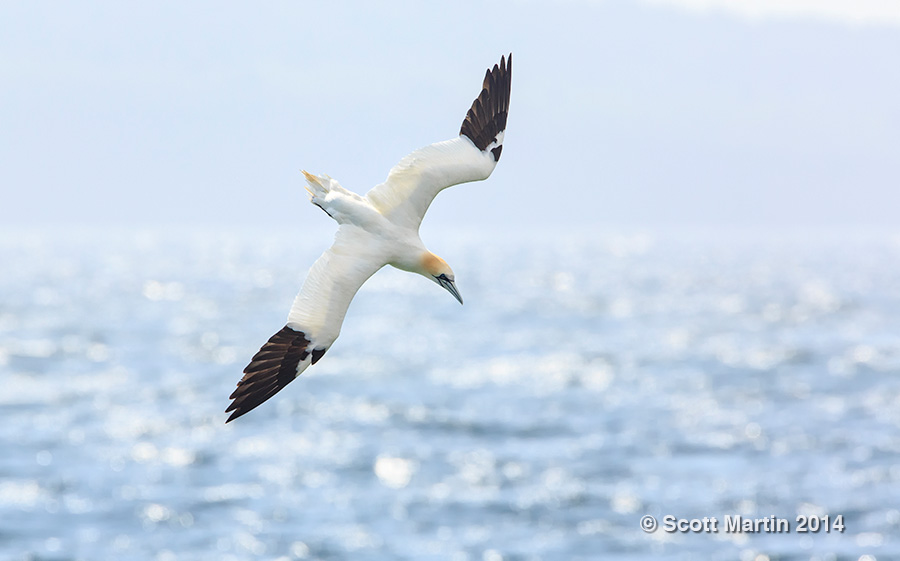
The wings remain fully extended until just before impact.
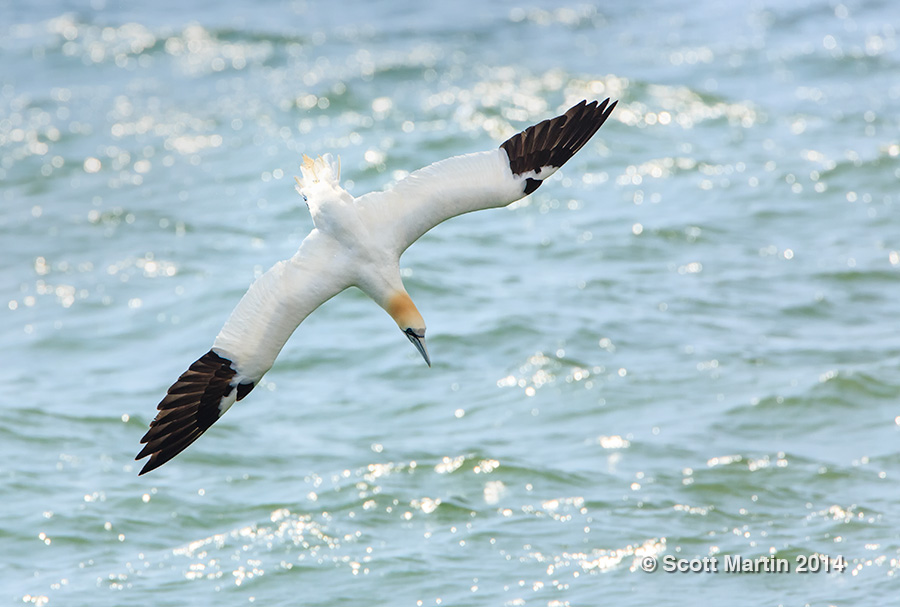
As they are about to enter the water they begin to quickly draw back their wings.
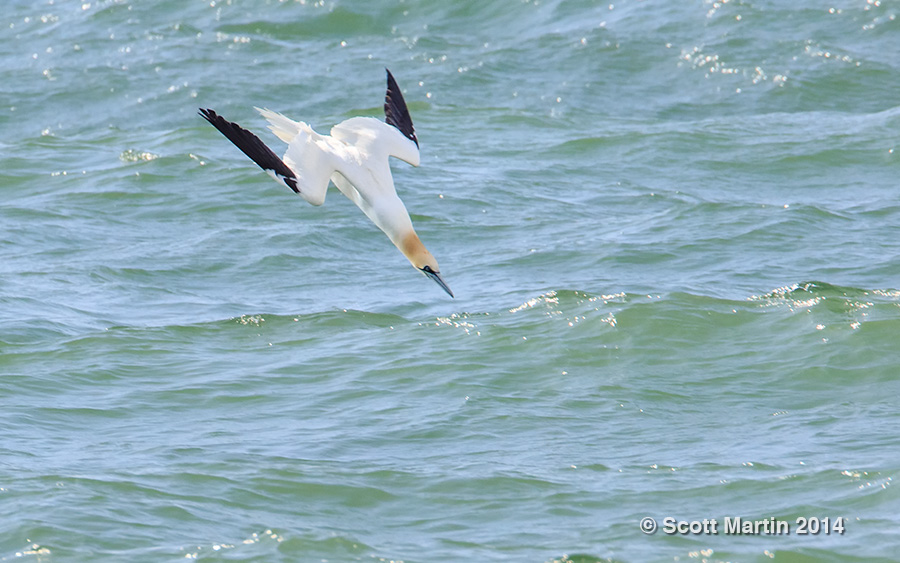
At the time of impact the wings are drawn fully back and neck is extended and the Gannet looks more like a torpedo that the very large pelagic bird it is.
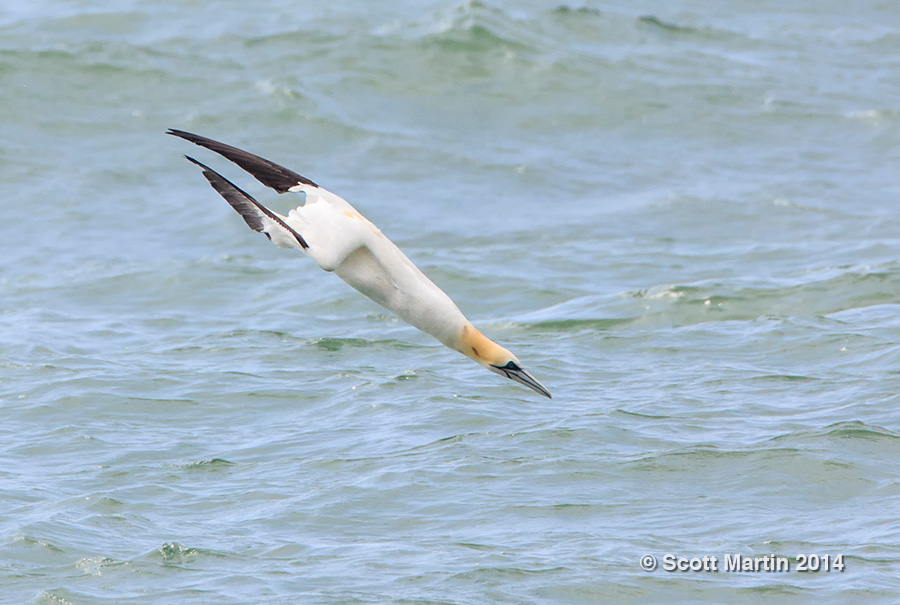
The speed of the Gannet at impact with the water is 100 km/h and even at that speed, the large size and buoyancy of the bird only allows it to reach depths of five or six feet. They catch their prey while returning to the surface.
As we conclude this post I will leave you with some portraits and in flight images of the Northern Gannet. I trust these help give you an appreciation for this great bird of Bonaventure Island.
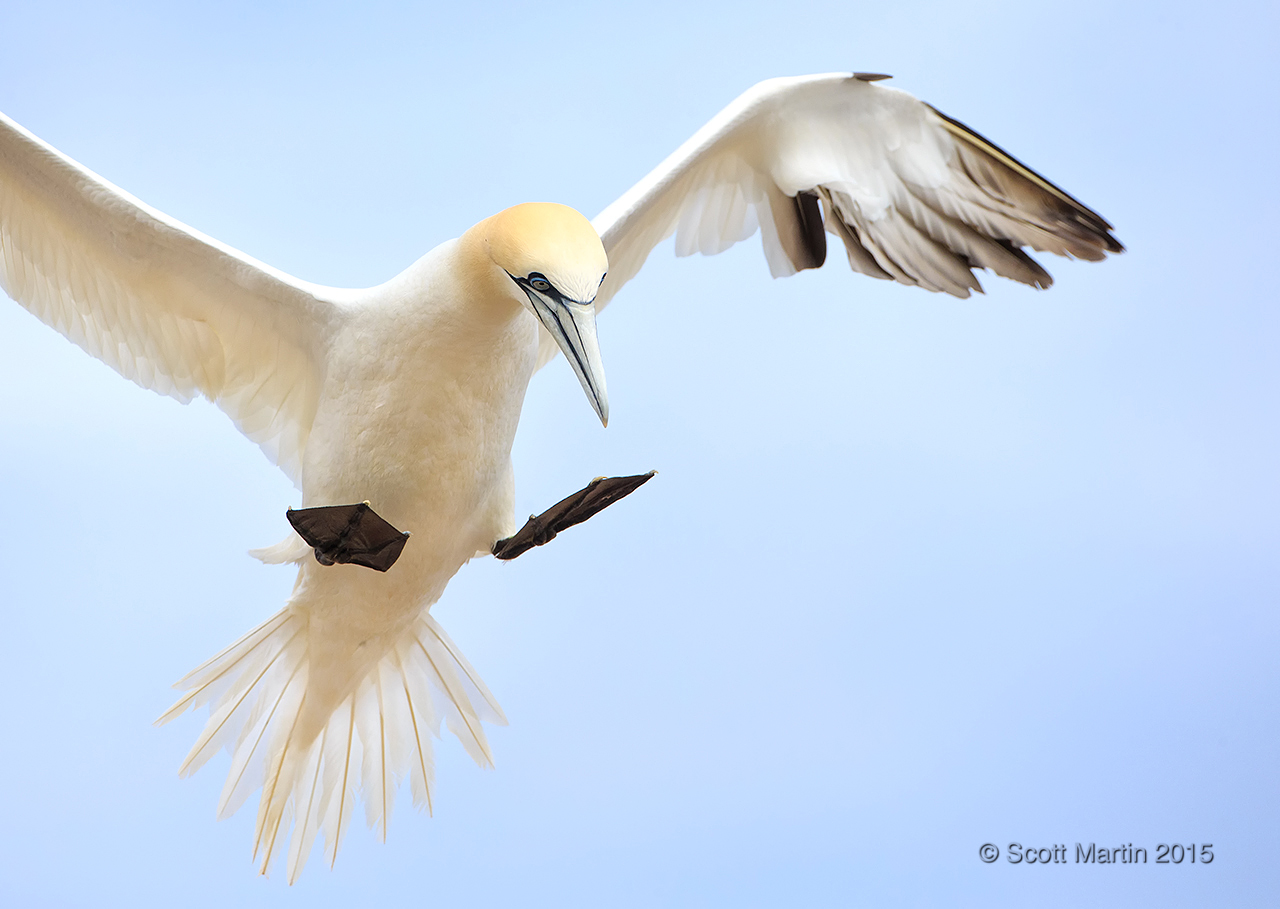
When given the opportunity, attempt to photograph birds against different back grounds which greatly influences the photographic results. The photo above has the sky as the background while the image below uses the water.
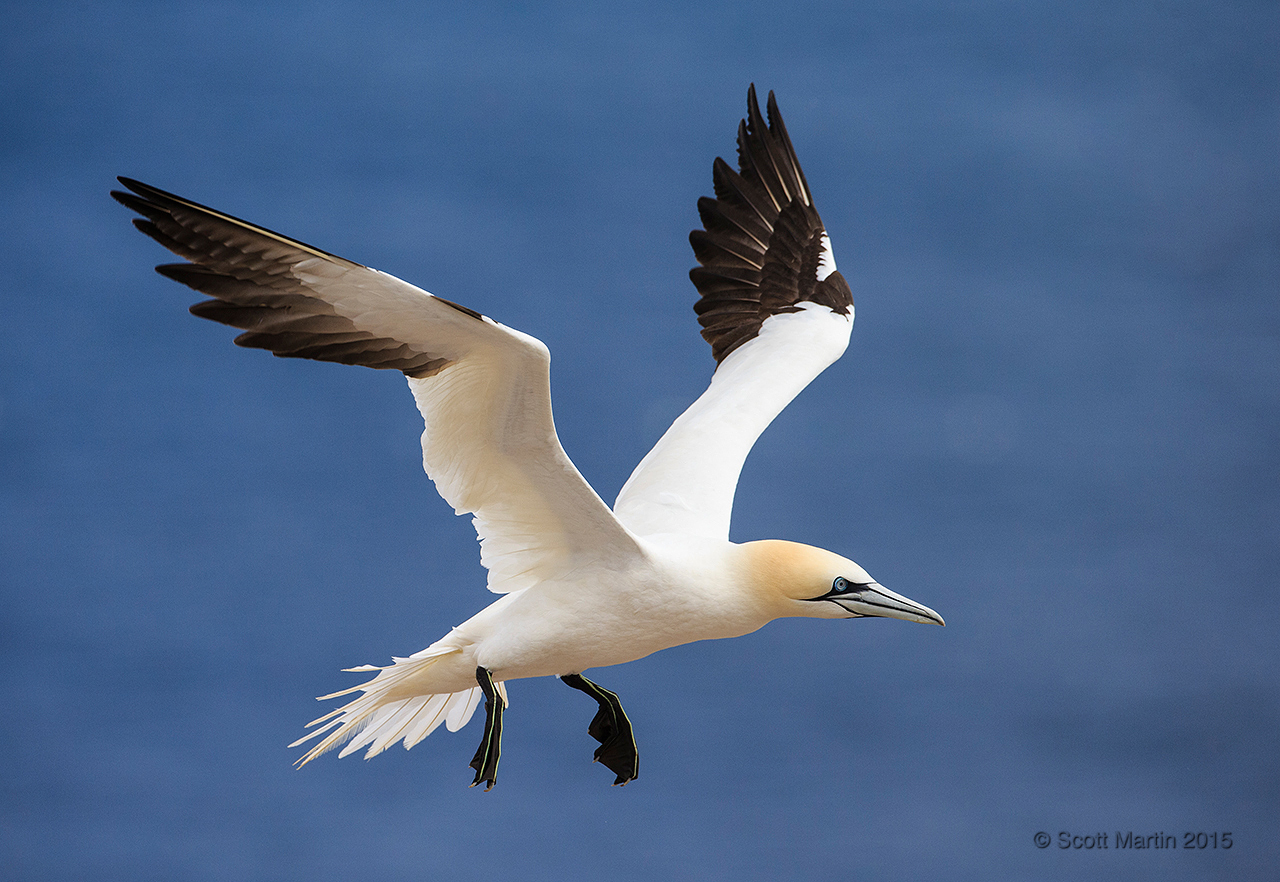
A unique pose with both eyes visible. Not a common occurrence in bird photography.
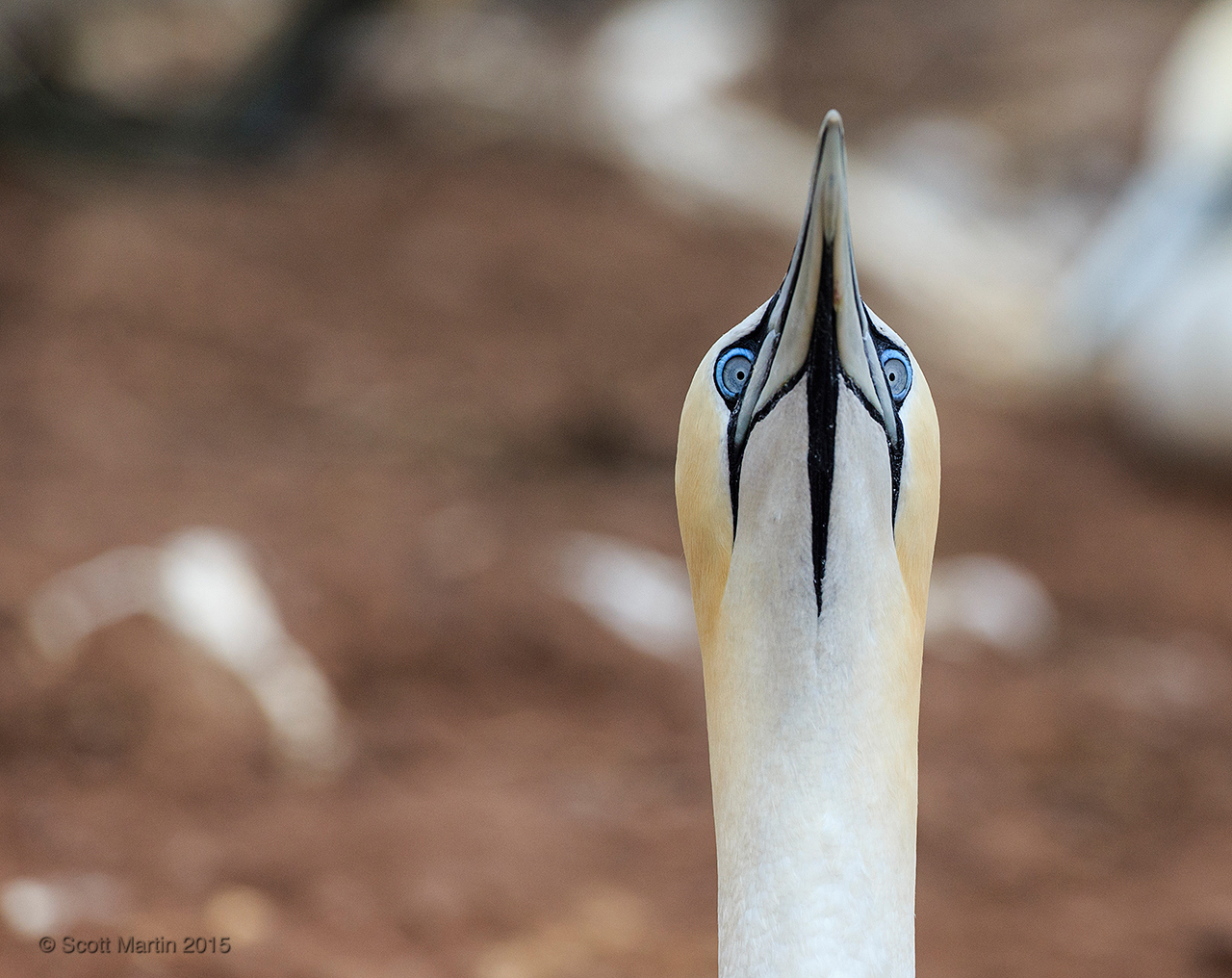
The long and slender wings of the Gannet make it ideally designed for gliding and riding the thermals that move up the cliffs on which they nest. This also allows the large and heavy Gannet to cover large distances with minimal effort.
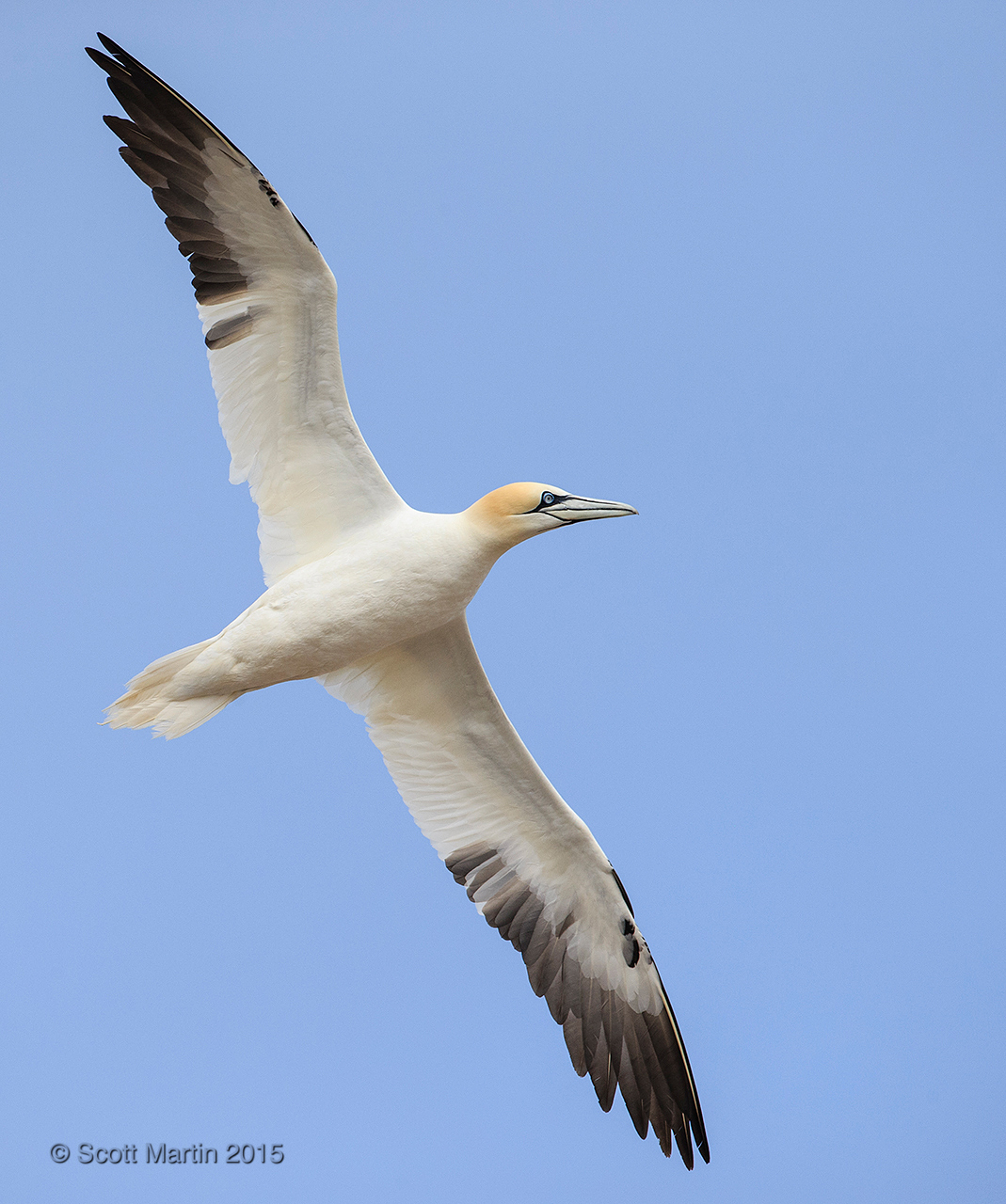
A Gannet slowing down after spotting its nest location.
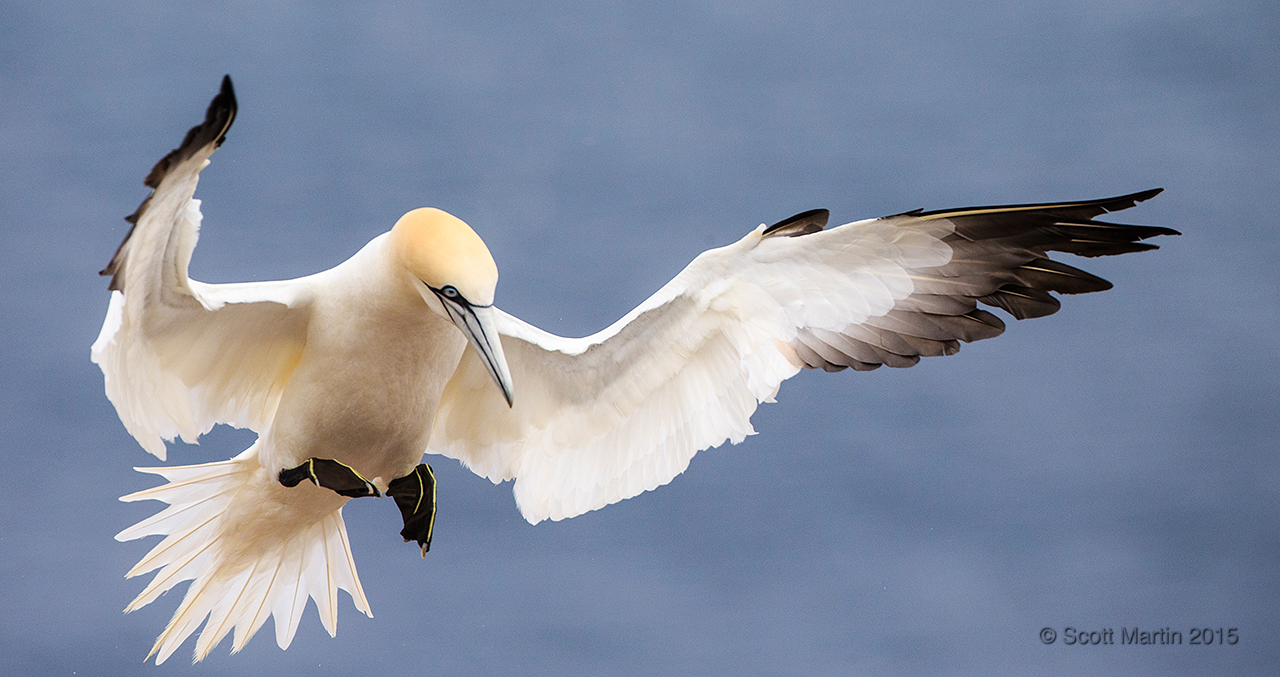
Capturing two birds in flight in the same frame with both in focus is a difficult challenge but the perseverance required paid off….eventually!
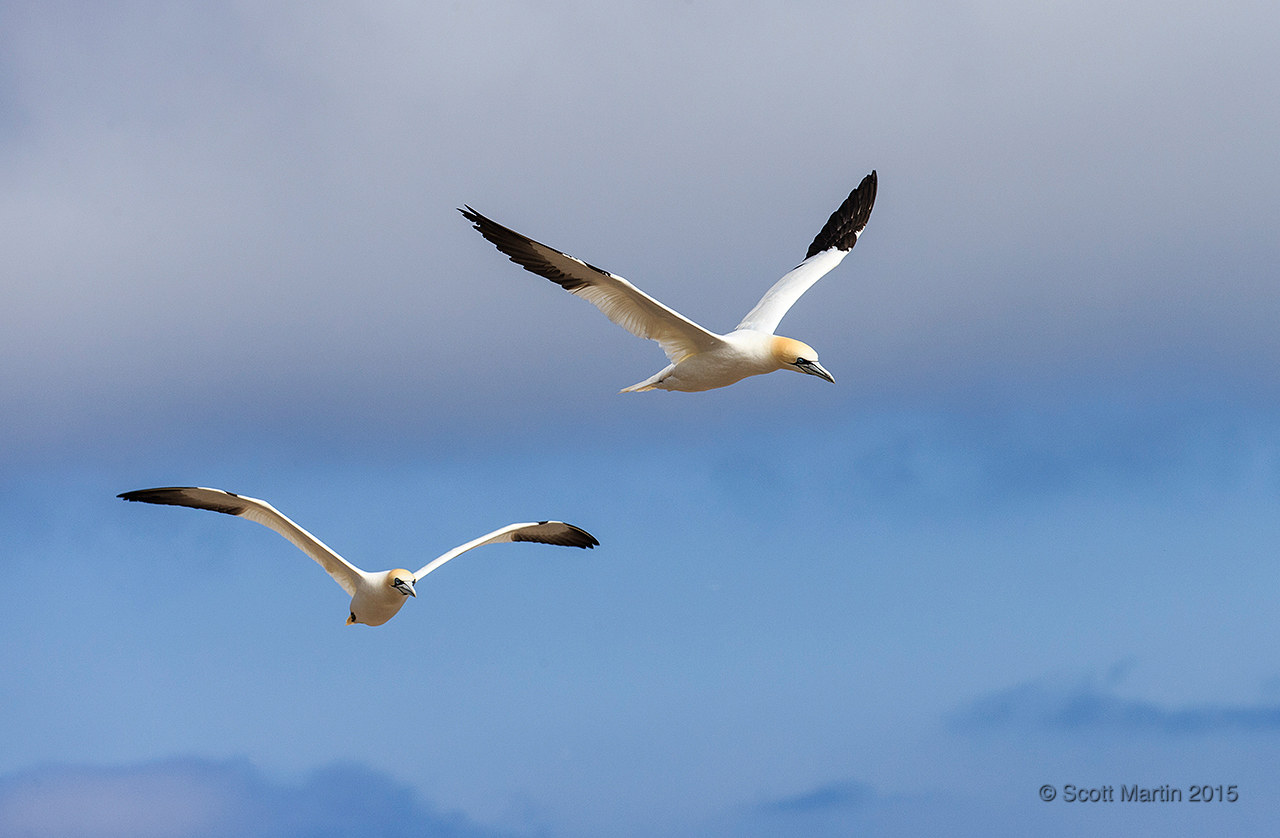
They truly are a photogenic species.
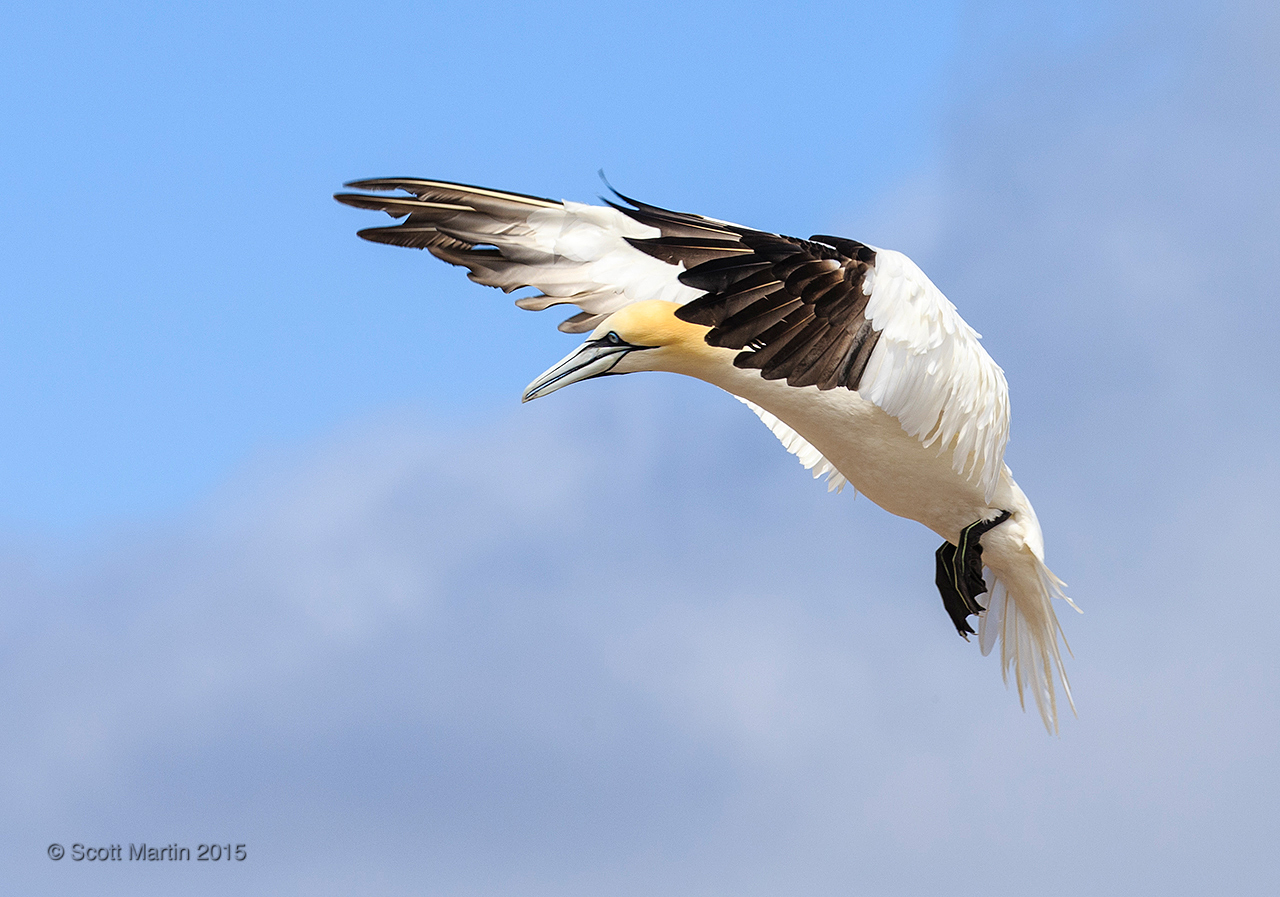
A Gannet cruising low over the colony before heading out to fish.
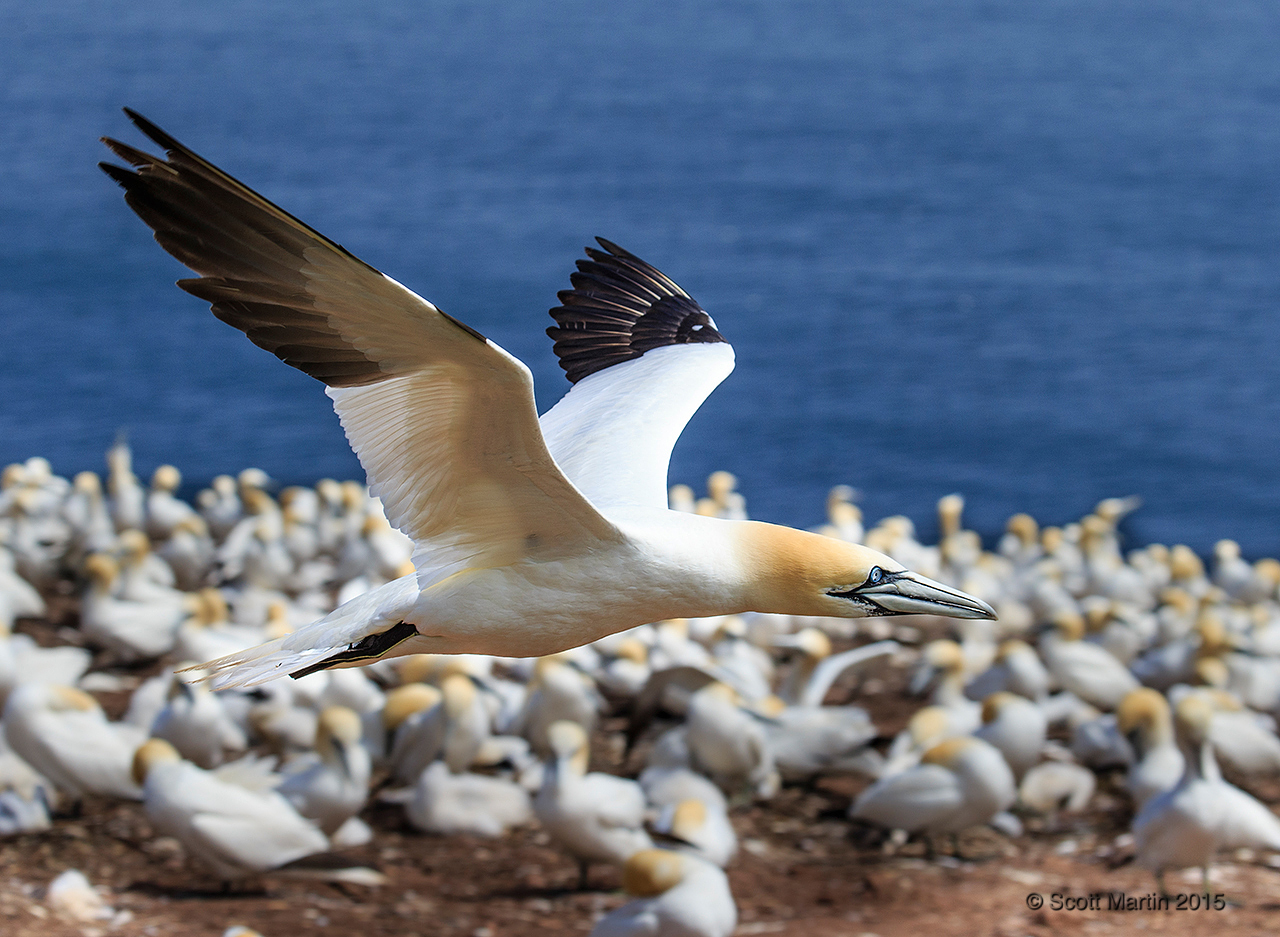
An in flight acrobat, slowing down and looking for the nest.
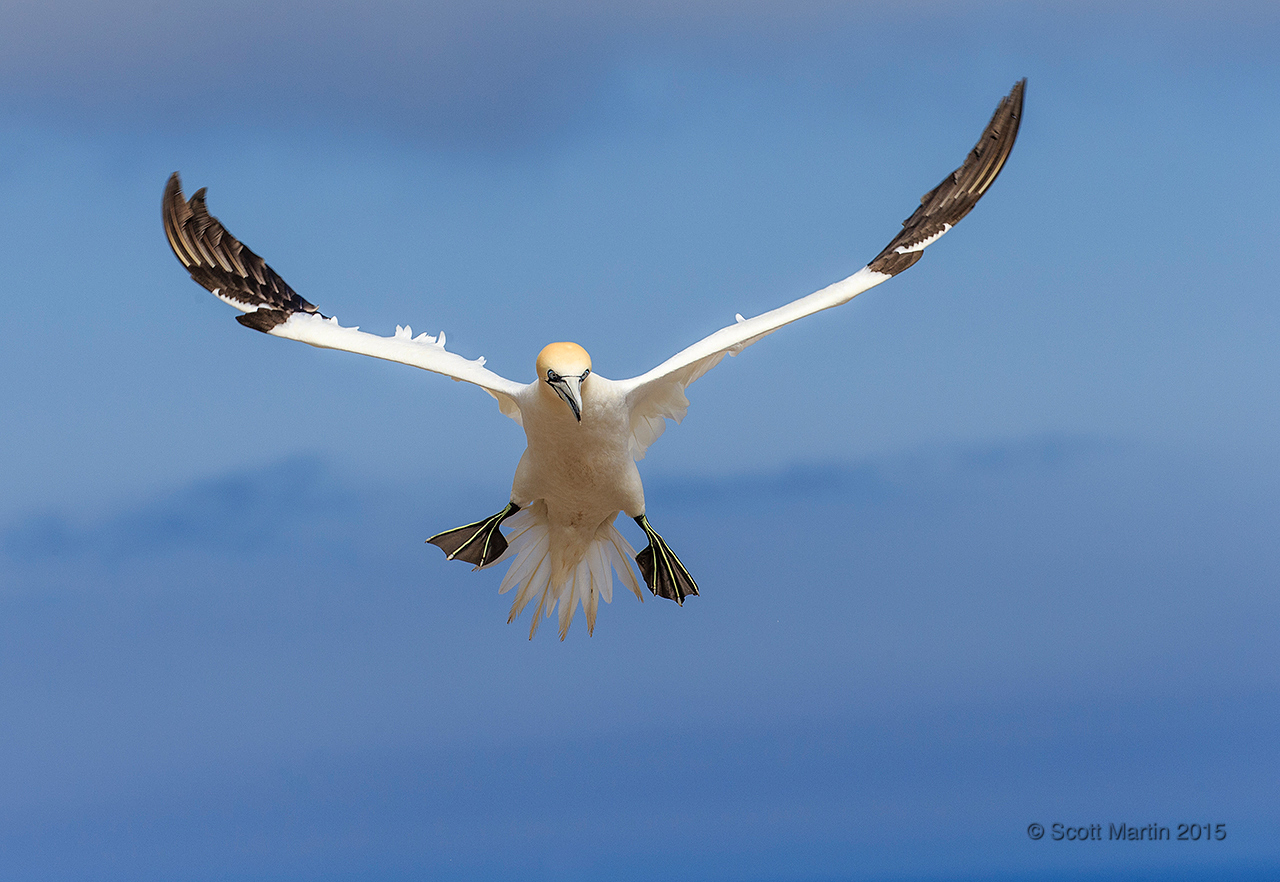
An affectionate couple guarding their nest.

Gannets normally dwell on cliffs but when there is no real estate left on the cliffs they occupy the plateaus atop the cliffs. They quickly denude the plateaus of vegetation and don’t often stray into grassy areas except to gather nesting material, or to offer the gift of grass to a potential partner, as an offer to build a nest together. It was a treat to find this Gannet with grass in its beak.
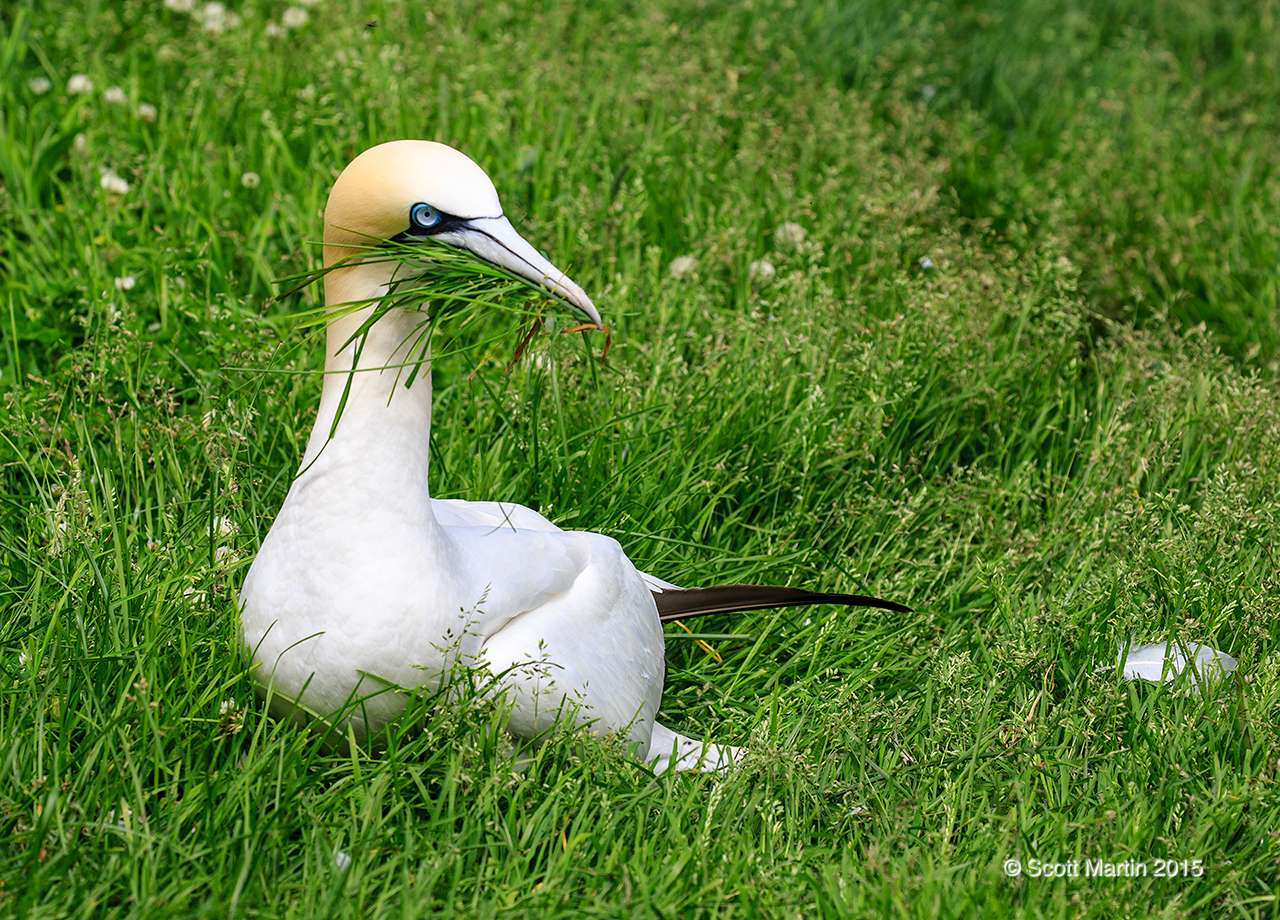
Apparently the object of his desire wasn’t overly interested in his kind offer!
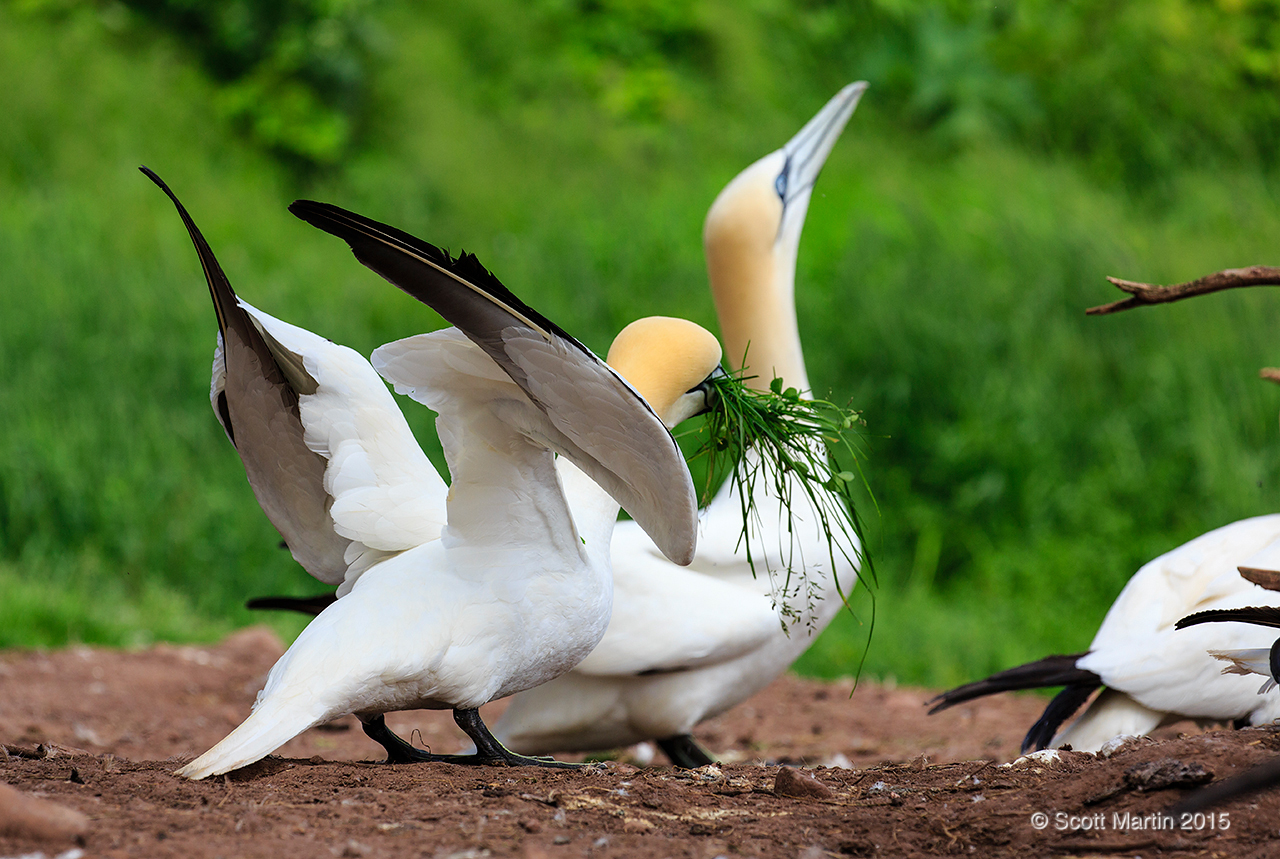
The maestro pose against a natural gradient background.
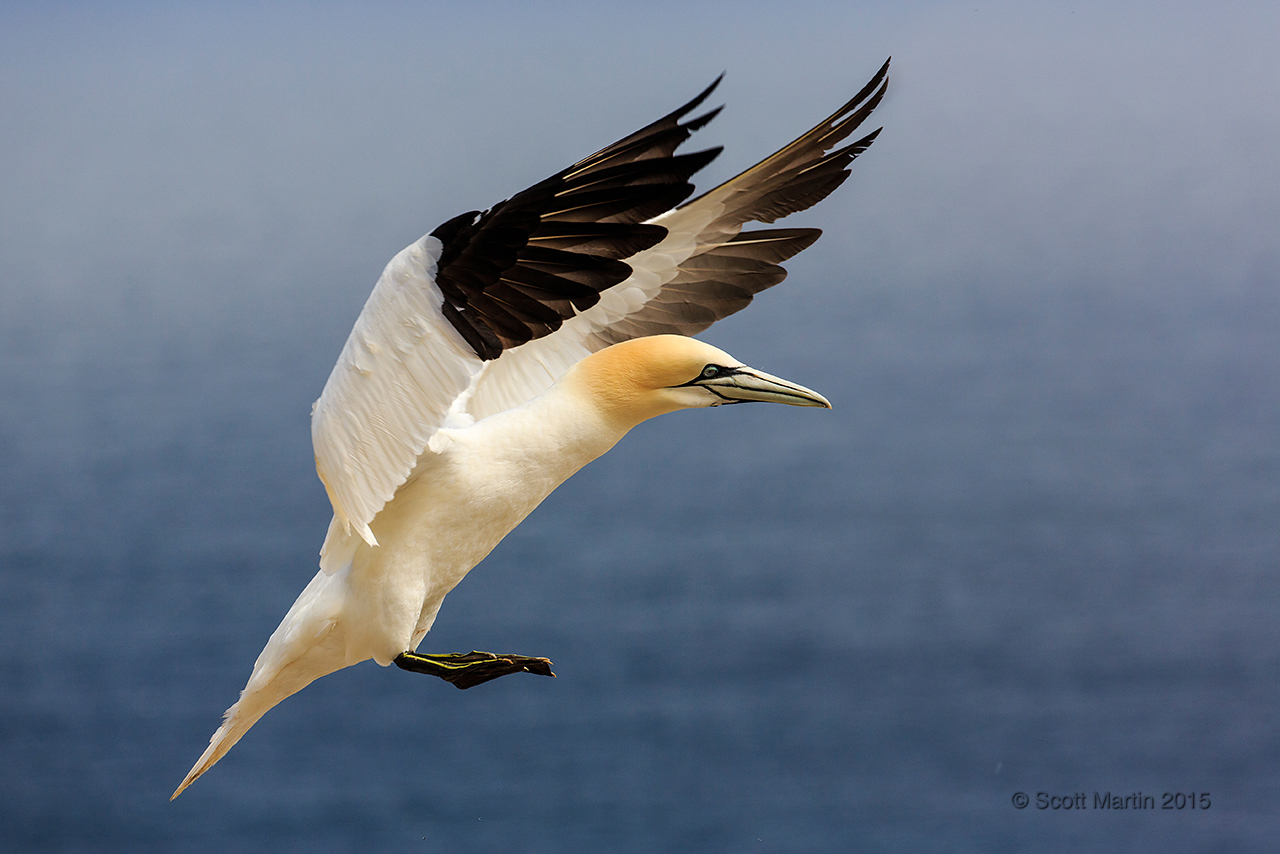
And a final tight portrait of the Northern Gannet with its steel eye and intense blue eye ring.
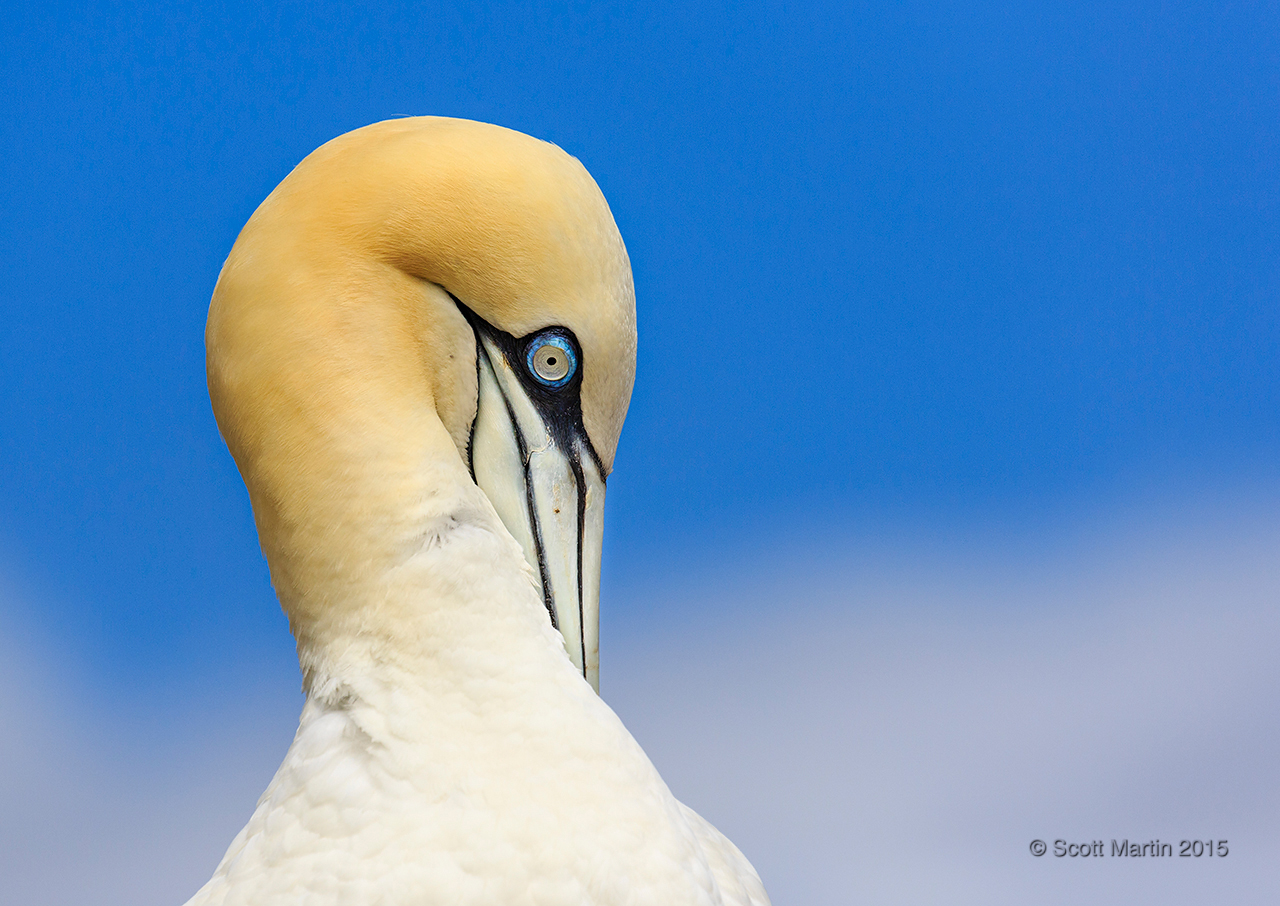
Although this post contains a number of images, there are many more in the Gulls, Gannets, Terns & Skimmers Gallery. I trust you will enjoy them as well.
Deb and I have had the opportunity to visit Percé and Bonaventure Island each of the past two summers to photograph Northern Gannets. We both highly recommend that you make the effort to travel to the Gaspé Peninsula of Quebec, not only to see the Gannets but to explore this very unique and beautiful part of our great country. You won’t be disappointed. If you want any Gaspé travel tips don’t hesitate to contact me as I’d be glad to help!
Follow Scott Martin Photography